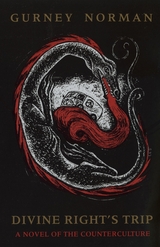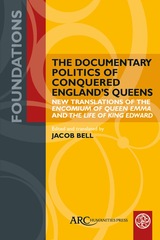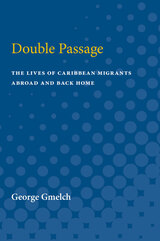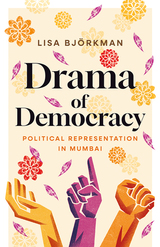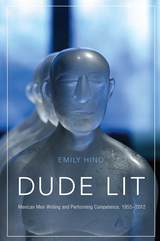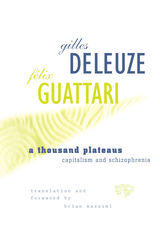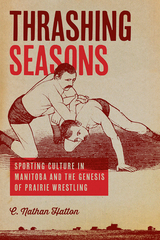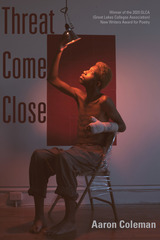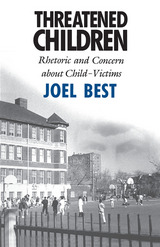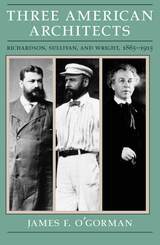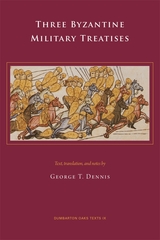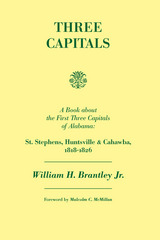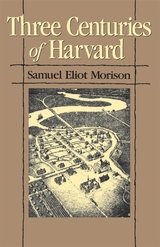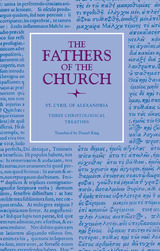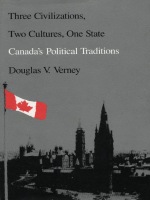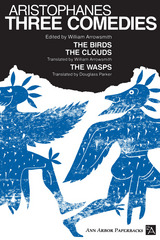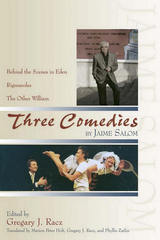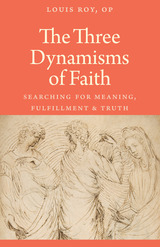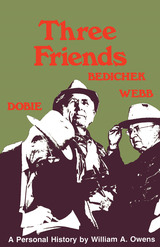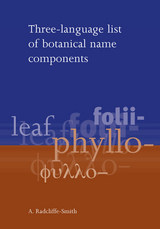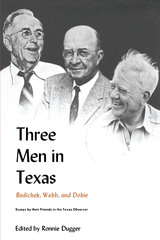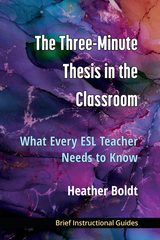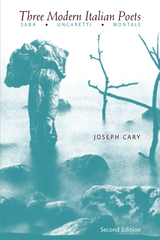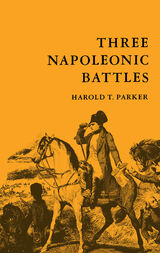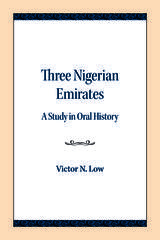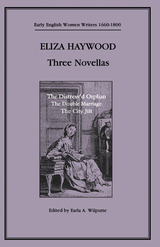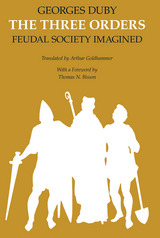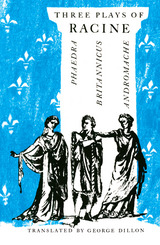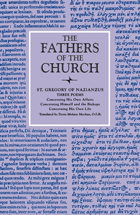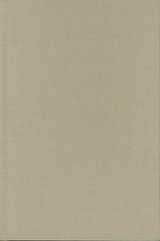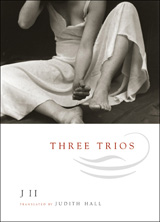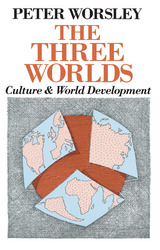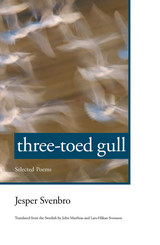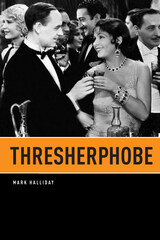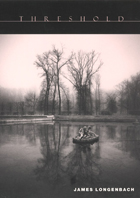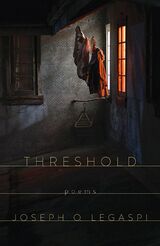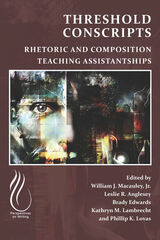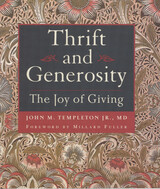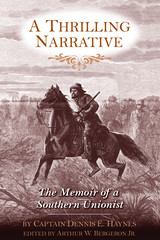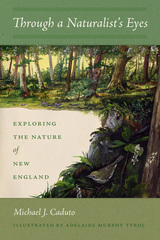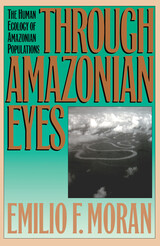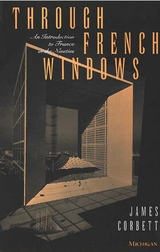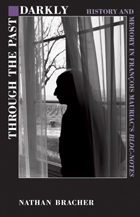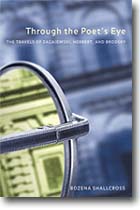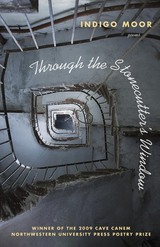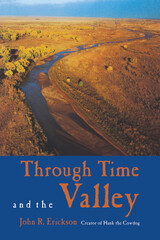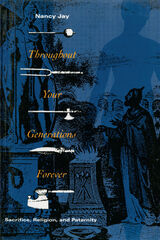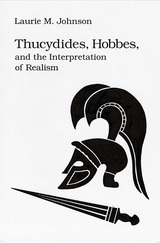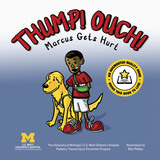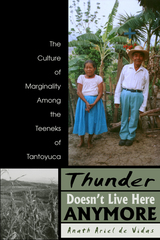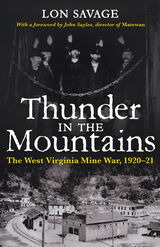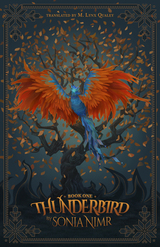A Thousand Plateaus: Capitalism and Schizophrenia
Gilles Deleuze
University of Minnesota Press, 1987 A Thousand Plateaus continues the work Gilles Deleuze and Félix Guattari began in Anti-Oedipus and has now become established as one of the classic studies of the development of critical theory in the late twentieth century. It occupies an important place at the center of the debate reassessing the works of Freud and Marx, advancing an approach that is neither Freudian nor Marxist but which learns from both to find an entirely new and radical path. It presents an attempt to pioneer a variety of social and psychological analyses free of the philosophical encumbrances criticized by postmodern writers. A Thousand Plateaus is an essential text for feminists, literary theorists, social scientists, philosophers, and others interested in the problems of contemporary Western culture.
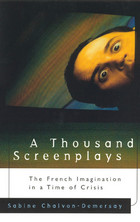 A Thousand Screenplays: The French Imagination in a Time of Crisis
Sabine Chalvon-Demersay
University of Chicago Press, 1999 In 1991, French public television held an amateur screenwriting contest. When Sabine Chalvon-Demersay, a French sociologist, examined the roughly 1,000 entries, she had hoped to analyze their differences. What she found, however, surprised her. Although the entrants covered nearly every social demographic, their screenplays presented similar characters in similar situations confronting similar problems.
The time of crisis presented by the amateur writers was not one of war, famine, or disease—it was the millennial dilemma of representation. In a world plagued by alienation, individualization, and a lack of mobility, how can members of a society combat their declining senses of self?
Although the contestants wrote about life in France, their concerns and struggles have a distinctly universal ring. A lucid, witty writer, Chalvon-Demersay offers a clear, if still developing, photograph of the contemporary imagination.
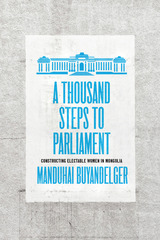 A Thousand Steps to Parliament: Constructing Electable Women in Mongolia
Manduhai Buyandelger
University of Chicago Press, 2022 A Thousand Steps to Parliament traces how the complicated, contradictory paths to political representation that women in Mongolia must walk mirror those the world over.
Mongolia has often been deemed an “island of democracy,” commended for its rapid adoption of free democratic elections in the wake of totalitarian socialism. The democratizing era, however, brought alongside it a phenomenon that Manduhai Buyandelger terms “electionization”—a restructuring of elections from time-grounded events into a continuous neoliberal force that governs everyday life beyond the electoral period. In this way, electoral campaigns have come to substitute for the functions of governing, from social welfare to the private sector, requiring an accumulation of wealth and power beyond the reach of most women candidates. In A Thousand Steps to Parliament, Buyandelger shows how successful women candidates instead use strategies of self-polishing to cultivate charisma and a reputation for being oyunlag, or intellectful. This carefully crafted identity can be called the “electable self”: treating their bodies and minds as pliable and renewable, women candidates draw from the same practices of neoliberalism that have unsustainably commercialized elections. By tracing the complicated, contradictory paths to representation that women in Mongolia must walk, A Thousand Steps to Parliament holds a mirror up to democracies the world over, revealing an urgent need to grapple with the encroaching effects of neoliberalism in our global political systems.
 A Thousand Weddings: The Memoir of Hope Hart of West Tennessee
Marvin Downing
University of Tennessee Press, 2025 Born at the dawn of the twentieth century, Hope Hart's life spanned a dynamic period in American history, particularly in the South. As the daughter of Sterling Hart, a traveling Methodist minister from Weakley County in northwest Tennessee, Hope's early years were shaped by her father's work preaching and performing wedding ceremonies across Tennessee, Kentucky, Mississippi, and Arkansas. Throughout her childhood, Hart witnessed the last days of the nineteenth-century Methodist circuit riders and the rapid evolution of the post–Civil War South. As an adult, Hart worked as a teacher and high school principal in northwest Tennessee before moving to Washington, DC, where she served as an administrative assistant to several US representatives over the course of her career.
Completed in 1962 and published here for the first time, A Thousand Weddings offers a firsthand account of a rapidly changing West Tennessee and its surrounding regions during the early twentieth century. Hart paints a vivid picture of life during this time, including rich descriptions of clothing (especially wedding attire), food, transportation, and attitudes toward religion, race, education, and marriage.
In presenting Hart’s story, editor Marvin Downing adds crucial context and commentary that situate the events of her life against the backdrop of significant moments in American history, including the Jackson Purchase, the growing influence of Jim Crow laws, and the First World War.
With its blend of personal anecdotes and historical context, A Thousand Weddings is both a heartwarming and engaging read and a thought-provoking journey through many facets of Tennessee history.
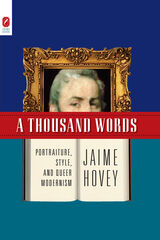 A THOUSAND WORDS: PORTRAITURE, STYLE, AND QUEER MODERNISM
Jaime Hovey
Ohio State University Press, 2006 A Thousand Words argues that there is such a thing as queer modernism, and that the (mostly) literary portrait—one of the more prominent forms of experimentalism in late-nineteenth- and early-twentieth-century writing—functions as one of its most important erotically dynamic aesthetic mechanisms, one modeled on visual portraiture’s relationships of looking between the artists, sitters, and spectators of paintings. Jaime Hovey looks at how the dynamic structure of visual portraiture was appropriated by modernist writers—including Oscar Wilde, Gertrude Stein, T. S. Eliot, Virginia Woolf, Ernest Hemingway, and Colette, among others, who used the self-conscious literary portrait.
Portraiture speaks to the complex relationship between identity, sexuality, and art, and the presence of so many portraits in this era suggests that sexual, gender, and racial aspects of character, personality, and personal identity were of major concern to most modernist writers. Yet it took most of the twentieth century for critical work to appear that meaningfully explored these themes, and very little has been said about the queerness of literary portraiture. This book demonstrates that literary portraiture is enamored of its own self-consciousness, with the pleasures of looking at itself seeing itself, and that its texts circulate this pleasure between writers, narrators and other characters, and readers as a perverse aesthetics
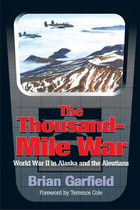 The Thousand-Mile War: World War II in Alaska and the Aleutians
Brian Garfield
University of Alaska Press, 1995 The Thousand-Mile War is a powerful story of the battles of the United States and Japan on the bitter rim of the North Pacific, that has been acclaimed as one of the great accounts of World War II. Author Brian Garfield, a novelist and screenwriter whose works have sold some 20 million copies, was searching for a new story when he came upon this "forgotten war" in Alaska. He found the history of the brave men who had served in the Aleutians so compelling that he wrote the first full-length history of the Aleutian campaign. The book remains a favorite among Alaskans and WWII history buffs.
The war in the Aleutians was fought in some of the worst climatic conditions on earth for men, ships, and airplanes. The sea was rough, the islands craggy and unwelcoming, but the most fearful enemy was the weather—the savage wind, fog, and rain of the Aleutian chain. The fog seemed to reach even into the minds of the military commanders on both sides, as they directed their men into situations with often had tragic results. Frustrating, befuddling, and still the subject of debate, the Aleutian campaign nevertheless marked an important turn of the war in favor of the United States.
More than half a century after the war ended, more of the fog has been lifted. In this updated edition, Garfield supplements his original account drawn from statistics, personal interviews, letters, and diaries, with more recently declassified photographs and significant additional illustrations.
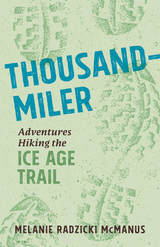 Thousand-Miler: Adventures Hiking the Ice Age Trail
Melanie Radzicki McManus
Wisconsin Historical Society Press, 2017 In thirty-six thrilling days, Melanie Radzicki McManus hiked 1,100 miles around Wisconsin, landing her in the elite group of Ice Age Trail thru-hikers known as the Thousand-Milers. In prose that’s alternately harrowing and humorous, Thousand-Miler takes you with her through Wisconsin’s forests, prairies, wetlands, and farms, past the geologic wonders carved by long-ago glaciers, and into the neighborhood bars and gathering places of far-flung small towns. Follow along as she worries about wildlife encounters, wonders if her injured feet will ever recover, and searches for an elusive fellow hiker known as Papa Bear. Woven throughout her account are details of the history of the still-developing Ice Age Trail—one of just eleven National Scenic Trails—and helpful insight and strategies for undertaking a successful thru-hike. In addition to chronicling McManus’s hike, Thousand-Miler also includes the little-told story of the Ice Age Trail’s first-ever thru-hiker Jim Staudacher, an account of the record-breaking thru-run of ultrarunner Jason Dorgan, the experiences of a young combat veteran who embarked on her thru-hike as a way to ease back into civilian life, and other fascinating tales from the trail. Their collective experiences shed light on the motivations of thru-hikers and the different ways hikers accomplish this impressive feat, providing an entertaining and informative read for outdoors enthusiasts of all levels.
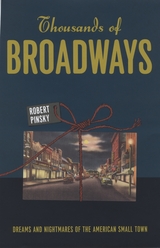 Thousands of Broadways: Dreams and Nightmares of the American Small Town
Robert Pinsky
University of Chicago Press, 2009 Broadway, the main street that runs through Robert Pinsky’s home town of Long Branch, New Jersey, was once like thousands of other main streets in small towns across the country. But for Pinsky, one of America’s most admired poets and its former Poet Laureate, this Broadway is the point of departure for a lively journey through the small towns of the American imagination. Thousands of Broadways explores the dreams and nightmares of such small towns—their welcoming yet suffocating, warm yet prejudicial character during their heyday, from the early nineteenth century through World War II. The citizens of quintessential small towns know one another extensively and even intimately, but fail to recognize the geniuses and criminal minds in their midst. Bringing the works of such figures as Mark Twain, William Faulkner, Alfred Hitchcock, Thornton Wilder, Willa Cather, and Preston Sturges to bear on this paradox, as well as reflections on his own time growing up in a small town, Pinsky explores how such imperfect knowledge shields communities from the anonymity and alienation of modern life. Along the way, he also considers how small towns can be small minded—in some cases viciously judgmental and oppressively provincial. Ultimately, Pinsky examines the uneasy regard that creative talents like him often have toward the small towns that either nurtured or thwarted their artistic impulses. Of living in a small town, Sherwood Anderson once wrote that "the sensation is one never to be forgotten. On all sides are ghosts, not of the dead, but of living people." Passionate, lyrical, and intensely moving, Thousands of Broadways is a rich exploration of this crucial theme in American literature by one of its most distinguished figures.
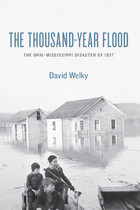 The Thousand-Year Flood: The Ohio-Mississippi Disaster of 1937
David Welky
University of Chicago Press, 2011 In the early days of 1937, the Ohio River, swollen by heavy winter rains, began rising. And rising. And rising. By the time the waters crested, the Ohio and Mississippi had climbed to record heights. Nearly four hundred people had died, while a million more had run from their homes. The deluge caused more than half a billion dollars of damage at a time when the Great Depression still battered the nation.
Timed to coincide with the flood's seventy-fifth anniversary, The Thousand-Year Flood is the first comprehensive history of one of the most destructive disasters in American history. David Welky first shows how decades of settlement put Ohio valley farms and towns at risk and how politicians and planners repeatedly ignored the dangers. Then he tells the gripping story of the river's inexorable rise: residents fled to refugee camps and higher ground, towns imposed martial law, prisoners rioted, Red Cross nurses endured terrifying conditions, and FDR dispatched thousands of relief workers. In a landscape fraught with dangers—from unmoored gas tanks that became floating bombs to powerful currents of filthy floodwaters that swept away whole towns—people hastily raised sandbag barricades, piled into overloaded rowboats, and marveled at water that stretched as far as the eye could see. In the flood's aftermath, Welky explains, New Deal reformers, utopian dreamers, and hard-pressed locals restructured not only the flood-stricken valleys, but also the nation's relationship with its waterways, changes that continue to affect life along the rivers to this day.
A striking narrative of danger and adventure—and the mix of heroism and generosity, greed and pettiness that always accompany disaster—The Thousand-Year Flood breathes new life into a fascinating yet little-remembered American story.
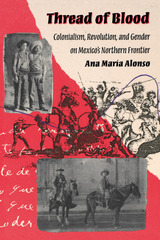 Thread of Blood: Colonialism, Revolution, and Gender on Mexico's Northern Frontier
Ana María Alonso
University of Arizona Press, 1995 This book is about the construction and tranformation of peasant military colonists on Mexico's northern frontier from the late 18th through the early 20th century. Though the majority of the data comes from the pueblo of Namiquipa in the state of Chihuahua, the argument has broader implications for the study of northern Mexico, frontier societies, and our understanding of the northern armies in the 1910 Revolution. The study is rare for its integration of several levels, placing an analysis of gender and ethnicity within a specific historical period.
The author demonstrates that a distinct kind of frontier serrano society was generated in Namiquipa between the mid-18th and mid-19th centuries. In exchange for keeping the Apaches at bay, colonists were provided with arms and land grants. At the same time, they developed a gendered sense of ethnic identity that equated honor with land, autonomy, and a kind of masculinity that distinguished the "civilized" colonist from the "barbarous" Indian. While this identity was itself ordered hierarchically between men and women, and between "Hispanic" and "Indian," it also provided serranos with a sense of pride and dignity that was not directly associated with wealth.
After the defeat of the Apaches, and with increased state control during the last decades of the Porfiriato, the serranos on the frontier were transformed from bulwarks of order to victims of progress. The expansion of capitalism and the manipulation of local political office by men no longer accountable to communal norms eroded the legitimacy of both powerholders and the central state. In response, serranos constructed an ideology of history based on past notions of masculine honor and autonomy. This ideology motivated their confrontations with the Mexican state during the 1890s and also served as the force behind their mobilization in the 1910 revolution.
 Threadbare: Class and Crime in Urban Alaska
Mary Kudenov
University of Alaska Press, 2017 Alaska’s perch at the geographic corner of civilization isn’t all wilderness and reality TV. There’s a darker side too. Above the 49th parallel some of the nation’s highest rates of alcoholism, suicide, and violent crime can be found. While it can easy to write off or even romanticize these statistics as the product of a lingering Wild West culture, talking with real Alaskans reveals a different story.
Journalist Mary Kudenov set out to find the true stories behind this “end-of-the-road” culture. Through her essays, we meet Alaskans who live outside the common adventurer narrative: a recent graduate of a court-sponsored sobriety program, a long-timer in the Hiland Mountain Correctional Center for women, a slum-landlord’s emancipated teenage daughter, and even a post-rampage spree killer. Her subjects struggle with poverty and middle-class aspirations, education and minimum wage work, God and psychology. The result is a raw and startling collection of direct, ground-level reporting that will leave you deeply moved.
 Threads from the Web of Life & The Shark and the Jellyfish: Stories in Natural History
Stephen Daubert
Vanderbilt University Press, 2019 Ecology, like all literary narrative, has the potential for turnabout, surprise, lessons learned, and tragedy. The stories in Threads from the Web of Life and The Shark and the Jellyfish describe protagonists, their competitors, and the habitats that provide the setting for their interaction—habitats that have become surprisingly complex with the passage of evolutionary time.
One niche moves across a world of flowers that reaches its earliest peak bloom in the low valleys and then peaks later among the slopes of the foothills—a rolling habitat. Another hop-scotches across the ocean floor, compelling its occupants to migrate from the fallen body of one dead whale to the next. Yet another appears in the aftermath of typhoons, requiring its inhabitants to search the tropical coastline for the latest storm landfall.
These tales are filled with no less intrigue than other literary works, but they transpire out of the sight of most readers. Once known only to ecologists, in Threads from the Web of Life and The Shark and the Jellyfish, available for the first time in a single deluxe paperback, these stories become accessible to everyone with an interest in natural history.
 Threads from the Web of Life: Stories in Natural History
Stephen Daubert
Vanderbilt University Press, 2006 A Selection of the Discovery Channel Book Club
In sixteen stories Steve Daubert pulls the reader into the mystery and immediacy of ecological processes spanning a range from microscopic to tectonic, from microscopic to cosmic forces. Each tale brings the reader into the moment to witness an episode of survival in the wild first-hand. The material is presented on a level of intimacy and detail not usually encountered in other styles of natural history writing.
These creative non-fiction stories provide not just a bird's eye view (though that's true for the owls, warblers, condors, and hummingbirds in the book), but a wasp's eye view, a mouse's, a sea turtle's, a squid's. Sometimes the focus is as small as the detritus on the forest floor, or a single beat of the wing of a gull. Other stories range across evolutionary time. From whales and dinosaurs to creatures invisible to the naked eye, author and illustrator bring to life the dynamic interplay of living, evolving creatures and the natural forces that have shaped their worlds.
The book includes chapter notes that document the scientific basis for each story and describe the controversies still surrounding some of them -- a splendid resource for families to read and share.
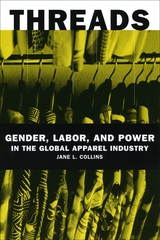 Threads: Gender, Labor, and Power in the Global Apparel Industry
Jane L. Collins
University of Chicago Press, 2003 Americans have been shocked by media reports of the dismal working conditions in factories that make clothing for U.S. companies. But while well intentioned, many of these reports about child labor and sweatshop practices rely on stereotypes of how Third World factories operate, ignoring the complex economic dynamics driving the global apparel industry.
To dispel these misunderstandings, Jane L. Collins visited two very different apparel firms and their factories in the United States and Mexico. Moving from corporate headquarters to factory floors, her study traces the diverse ties that link First and Third World workers and managers, producers and consumers. Collins examines how the transnational economics of the apparel industry allow firms to relocate or subcontract their work anywhere in the world, making it much harder for garment workers in the United States or any other country to demand fair pay and humane working conditions.
Putting a human face on globalization, Threads shows not only how international trade affects local communities but also how workers can organize in this new environment to more effectively demand better treatment from their distant corporate employers.
 Threads of Life: Autobiography and the Will
Richard Freadman
University of Chicago Press, 2001 Many autobiographers share profound questions about human life with their readers—questions like: To what extent was my life imposed on me? To what extent did I bring it about through particular choices and actions, through the activity of my own will? Indeed, the issue of the will is central to autobiographical writing, and some of the greatest autobiographies give extended consideration to the will—its nature; its powers; its limitations; the forms of freedom, constraint, and expression it finds in various cultures; its role in particular human lives.
In this new study, unprecedented in subject and scope, Richard Freadman offers the first sustained account of how changing theological, philosophical, and psychological accounts of the human will have been reflected in the writing of autobiography, and of how autobiography in its turn has helped shape various understandings of the will. Early chapters trace narrative representations of the will from antiquity (the Greeks and Augustine) to postmodernism (Derrida and Barthes), with particular emphasis on late modernity's culture of the will. Later chapters then present detailed and powerfully original readings of autobiographical texts by Louis Althusser, Roland Barthes, B. F. Skinner, Ernest Hemingway, Simone de Beauvoir, Arthur Koestler, Stephen Spender, and Diana Trilling.
Freadman's interdisciplinary approach to autobiography and the will includes a theoretical defense of the view that autobiographers are, in varying degrees, agents in their own texts. Threads of Life argues that late modernity has inherited deeply conflicted attitudes to the will. Freadman suggests that these attitudes, now deeply embedded in contemporary cultural discourse, need reexamining. In this, he contends, 'reflective autobiography' has an important part to play.
Threat Come Close
Aaron Coleman
Four Way Books, 2018 In his debut collection, Aaron Coleman writes an American anthem for the 21st century, a full-throated lyric composed of pain, faith, lust and vulnerability. Coleman’s poems comment on and interrogate the meaning of home and identity for a black man in America, past and present. Guided by a belief system comprising an eclectic array of invented saints—Trigger, Seduction, Doubt and Who—Coleman’s quest finds answers in the natural world where “[t]he trees teach me how to break and keep on living.”
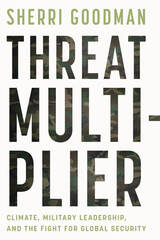 Threat Multiplier: Climate, Military Leadership, and the Fight for Global Security
Sherri Goodman
Island Press, 2024 Threat Multiplier takes us onto the battlefield and inside the Pentagon to show how the US military is confronting the biggest security risk in global history: climate change. More than thirty years ago, when Sherri Goodman became the Pentagon’s first Chief Environmental Officer, no one would have imagined this role for our armed forces.
Indeed, for much of the twentieth century, the Department of Defense (DOD) was better known for containing the Soviet nuclear threat than protecting the environment. And yet, today, the military has moved from an environmental laggard to a clean energy and climate leader, recognizing that a warming world exacerbates every threat—from hurricanes and forest fires, to competition for increasingly scarce food and water, to terrorism and power plays by Russia and China. The Pentagon now considers climate in war games, disaster relief planning, international diplomacy, and even the design of its own bases.
What was the key to this dramatic change in military thinking? What keeps today’s generals and admirals up at night? How can we safeguard our national defense and our planet? No one is better poised to answer these questions than Sherri Goodman, who was at the vanguard of environmental leadership among our armed forces and civilian representatives. In Threat Multiplier, she tells the inside story of the military’s fight for global security, a tale that is as hopeful as it is harrowing.
 Threat of Dissent: A History of Ideological Exclusion and Deportation in the United States
Julia Rose Kraut
Harvard University Press, 2020 In this first comprehensive overview of the intersection of immigration law and the First Amendment, a lawyer and historian traces ideological exclusion and deportation in the United States from the Alien Friends Act of 1798 to the evolving policies of the Trump administration.
Beginning with the Alien Friends Act of 1798, the United States passed laws in the name of national security to bar or expel foreigners based on their beliefs and associations—although these laws sometimes conflict with First Amendment protections of freedom of speech and association or contradict America’s self-image as a nation of immigrants. The government has continually used ideological exclusions and deportations of noncitizens to suppress dissent and radicalism throughout the twentieth and twenty-first centuries, from the War on Anarchy to the Cold War to the War on Terror.
In Threat of Dissent—the first social, political, and legal history of ideological exclusion and deportation in the United States—Julia Rose Kraut delves into the intricacies of major court decisions and legislation without losing sight of the people involved. We follow the cases of immigrants and foreign-born visitors, including activists, scholars, and artists such as Emma Goldman, Ernest Mandel, Carlos Fuentes, Charlie Chaplin, and John Lennon. Kraut also highlights lawyers, including Clarence Darrow and Carol Weiss King, as well as organizations, like the ACLU and PEN America, who challenged the constitutionality of ideological exclusions and deportations under the First Amendment. The Supreme Court, however, frequently interpreted restrictions under immigration law and upheld the government’s authority.
By reminding us of the legal vulnerability foreigners face on the basis of their beliefs, expressions, and associations, Kraut calls our attention to the ways that ideological exclusion and deportation reflect fears of subversion and serve as tools of political repression in the United States.
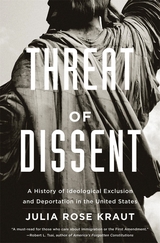 Threat of Dissent: A History of Ideological Exclusion and Deportation in the United States
Julia Rose Kraut
Harvard University Press “Suspicion of foreigners goes back to the earliest days of the republic…Kraut traces how different ideologies would be considered intolerably dangerous according to the dominant fears of a given era. Anarchism gave way to communism; communism gave way to Islamic radicalism.” —Jennifer Szalai, New York Times
“Magisterial and well written…A gripping, expansive story that traces the consequences of suspicions of ‘un-American’ ideologies and loyalties in federal jurisprudence from the War of 1812 through the still-raging War on Terror.”
—Rachel Ida Buff, Journal of Interdisciplinary History
“An original, comprehensive history of one of the most pervasive and insidious forms of political repression in the United States—one few Americans know anything about.”
—Michael Kazin, author of War Against War
Beginning with the Alien Friends Act of 1798, the United States has passed laws in the name of national security to bar or expel foreigners based on their beliefs and associations. From the War on Anarchy to the War on Terror, the government repeatedly turns to ideological exclusions and deportations to suppress radicalism and dissent.
Threat of Dissent delves into major legislation and court decisions at the intersection of immigration and the First Amendment without losing sight of the people involved. We follow the cases of foreign-born activists and artists such as Emma Goldman and Carlos Fuentes, meet determined civil rights lawyers like Carol Weiss King, and discover how the ACLU and PEN challenged the constitutionality of exclusions and deportations. While sensitively capturing the particular legal vulnerability of foreigners, Julia Rose Kraut reminds us that deportations are not just a tool of political repression but a deliberate instrument of demagogic grandstanding.
 The Threat of Liberation: Imperialism and Revolution in Zanzibar
Amrit Wilson
Pluto Press, 2013 The Threat of Liberation returns to the tumultuous years of the Cold War, when, in a striking parallel with today, imperialist powers were seeking to institute ‘regime change’ and install pliant governments.
Using iconic photographs, declassified US and British documents, and in-depth interviews, Amrit Wilson examines the role of the Umma Party of Zanzibar and its leader, the visionary Marxist revolutionary, Abdulrahman Mohamed Babu. Drawing parallels between US paranoia about Chinese Communist influence in the 1960s with contemporary fears about Chinese influence, it looks at the new race for Africa’s resources, the creation of AFRICOM and how East African politicians have bolstered US control. The book also draws on US cables released by Wikileaks showing Zanzibar's role in the ‘War on Terror’ in Eastern Africa today.
The Threat of Liberation reflects on the history of a party which confronted imperialism and built unity across ethnic divisions, and considers the contemporary relevance of such strategies.
 Threat: Palestinian Political Prisoners in Israel
Edited by Abeer Baker and Anat Matar
Pluto Press, 2011 Palestinian prisoners charged with security-related offences are immediately taken as a threat to Israel's security. They are seen as potential, if not actual, suicide bombers. This stereotype ignores the political nature of the Palestinian prisoners' actions and their desire for liberty.
By highlighting the various images of Palestinian prisoners in the Israel-Palestine conflict, Abeer Baker and Anat Matar chart their changing fortunes. Essays written by prisoners, ex-prisoners, Human rights defenders, lawyers and academic researchers analyse the political nature of imprisonment and Israeli attitudes towards Palestinian prisoners. These contributions deal with the prisoners' status within Palestinian society, the conditions of their imprisonment and various legal procedures used by the Israeli military courts in order to criminalise and de-politicise them. Also addressed are Israel's breaches of international treaties in its treatment of the Palestinian prisoners, practices of torture and solitary confinement, exchange deals and prospects for release.
This is a unique intervention within Middle East studies that will inspire those working in human rights, international law and the peace process.
Threatened Children: Rhetoric and Concern about Child-Victims
Joel Best
University of Chicago Press, 1990 Child abuse, incest, child molestation, Halloween sadism, child pornography: although clearly not new problems, they have attracted more attention than ever before. Threatened Children asks why. Joel Best analyzes the rhetorical tools used by child advocates when making claims aimed at raising public anxiety and examines the media's role in transmitting reformers' claims and the public's response to the frightening statistics, compelling examples, and expanding definitions it confronts. Drawing on a wide range of sources, from criminal justice records to news stories, from urban legends to public opinion surveys, Best reveals how the cultural construction of social problems evolves.
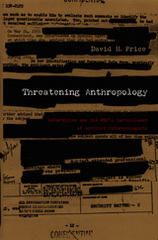 Threatening Anthropology: McCarthyism and the FBI’s Surveillance of Activist Anthropologists
David H. Price
Duke University Press, 2004 A vital reminder of the importance of academic freedom, Threatening Anthropology offers a meticulously detailed account of how U.S. Cold War surveillance damaged the field of anthropology. David H. Price reveals how dozens of activist anthropologists were publicly and privately persecuted during the Red Scares of the 1940s and 1950s. He shows that it was not Communist Party membership or Marxist beliefs that attracted the most intense scrutiny from the fbi and congressional committees but rather social activism, particularly for racial justice. Demonstrating that the fbi’s focus on anthropologists lessened as activist work and Marxist analysis in the field tapered off, Price argues that the impact of McCarthyism on anthropology extended far beyond the lives of those who lost their jobs. Its messages of fear and censorship had a pervasive chilling effect on anthropological investigation. As critiques that might attract government attention were abandoned, scholarship was curtailed. Price draws on extensive archival research including correspondence, oral histories, published sources, court hearings, and more than 30,000 pages of fbi and government memorandums released to him under the Freedom of Information Act. He describes government monitoring of activism and leftist thought on college campuses, the surveillance of specific anthropologists, and the disturbing failure of the academic community—including the American Anthropological Association—to challenge the witch hunts. Today the “war on terror” is invoked to license the government’s renewed monitoring of academic work, and it is increasingly difficult for researchers to access government documents, as Price reveals in the appendix describing his wrangling with Freedom of Information Act requests. A disquieting chronicle of censorship and its consequences in the past, Threatening Anthropology is an impassioned cautionary tale for the present.
 Threatening Others: Nicaraguans and the Formation of National Identities in Costa Rica
Carlos Sandoval-Garcia
Ohio University Press, 2004 During the last two decades, a decline in public investment has undermined some of the national values and institutions of Costa Rica. The resulting sense of dislocation and loss is usually projected onto Nicaraguan “immigrants.” Threatening Others: Nicaraguans and the Formation of National Identities in Costa Rica explores the representation of the Nicaraguan “other” in the Costa Rican imagery. It also seeks to address more generally why the sense of national belonging constitutes a crucial identification in contemporary societies. Interdisciplinary and based on extensive fieldwork, it looks critically at the “exceptionalism” that Costa Ricans take for granted and view as a part of their national identity. Carlos Sandoval-García argues that Nicaraguan immigrants, once perceived as a “communist threat,” are now victims of an invigorated, racialized politics in which the Nicaraguan nationality has become an offense in itself. Threatening Others is a deeply searching book that will interest scholars and students in Latin American studies and politics, cultural studies, and ethnic studies.
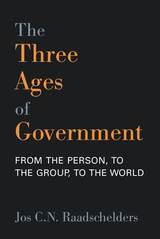 The Three Ages of Government: From the Person, to the Group, to the World
Jos C.N. Raadschelders
University of Michigan Press, 2020 It is only in the last 250 years that ordinary people (in some parts of the world) have become citizens rather than subjects. This change happened in a very short period, between 1780 and 1820, a result of the foundations of democracy laid in the age of revolutions. A century later local governments embraced this shift due to rapid industrialization, urbanization, and population growth. During the twentieth century, all democratic governments began to perform a range of tasks, functions, and services that had no historical precedent. In the thirty years following the Second World War, Western democracies created welfare states that, for the first time in history, significantly reduced the gap between the wealthy and everyone else. Many of the reforms of that postwar period have been since rolled back because of the belief that government should be more like a business. Jos C.N. Raadschelders provides the information that all citizens should have about their connections to government, why there is a government, what it does, how it does it, and why we can no longer do without it. The Three Ages of Government rises above stereotypical thinking to show the centrality of government in human life.
Three American Architects: Richardson, Sullivan, and Wright, 1865-1915
James F. O'Gorman
University of Chicago Press, 1991 O'Gorman discusses the individual and collective achievement of the recognized trinity of American architecture: Henry Hobson Richardson (1838-86), Louis Sullivan (1856-1924), and Frank Lloyd Wright (1867-1959). He traces the evolution of forms created during these architects' careers, emphasizing the interrelationships among them and focusing on the designs and executed buildings that demonstrate those interrelationships. O'Gorman also shows how each envisioned the building types demanded by the growth of nineteenth-century cities and suburbs—the downtown skyscraper and the single-family home.
[A] brilliant analysis . . . a major contribution to our understanding of the beginnings of modern American architecture."—David Hamilton Eddy, Times Higher Education Supplement.
 Three American Poets: Walt Whitman, Emily Dickinson, and Herman Melville
William C. Spengemann
University of Notre Dame Press, 2010
In Three American Poets, William C. Spengemann describes the very different sorts of poetry Whitman, Dickinson, and Melville wrote, their comparable reasons for writing as they did, and the posthumous critical effects of their having done so.
By linking these utterly singular poets and their work--verse connected by shared qualities of oddity, complexity, and difficulty--Spengemann illuminates the poets' efforts to create verse equal to the demands of a changing nineteenth century. All three responded to a widespread sense of loss--loss, above all, of Christian understandings of the origins, nature, and purpose of human existence, both individual and collective. All three, too, regarded poetry as the sole means of dealing with that loss and of comprehending not only a changing world but the old world from which the new one had departed, and hence the connections between the vanished, discredited past, the baffling present, and the as yet inscrutable future.
Spengemann suggests that the poetic eccentricities of Whitman, Melville, and Dickinson arose directly from their use of poetry as a vehicle of thought; each devised a poetic language either to attempt to recover a lost sense of assurance threatened by the collapse of traditional faith or to discover an altogether new ground of knowledge and being. Spengemann guides us in parsing their respective poetics with masterful readings closely attuned to diction, syntax, meter, and figure. His authoritative and empirical descriptions of the poets' verse and their respective characteristic aesthetics afford us heightened access to the poems and the pleasures peculiar to them, in the process making us better readers of poetry in general.
 Three Ancient Colonies: Caribbean Themes and Variations
Sidney W. Mintz
Harvard University Press, 2010 As a young anthropologist, Sidney Mintz undertook fieldwork in Jamaica, Haiti, and Puerto Rico. Fifty years later, the eminent scholar of the Caribbean returns to those experiences to meditate on the societies and on the island people who befriended him. These reflections illuminate continuities and differences between these cultures, but even more they exemplify the power of people to reveal their own history.
Mintz seeks to conjoin his knowledge of the history of Jamaica, Haiti, and Puerto Rico—a dynamic past born of a confluence of peoples of a sort that has happened only a few times in human history—with the ways that he heard people speak about themselves and their lives. Mintz argues that in Jamaica and Haiti, creolization represented a tremendous creative act by enslaved peoples: that creolization was not a passive mixing of cultures, but an effort to create new hybrid institutions and cultural meanings to replace those that had been demolished by enslavement. Globalization is not the new phenomenon we take it to be.
This book is both a summation of Mintz's groundbreaking work in the region and a reminder of how anthropology allows people to explore the deep truths that history may leave unexamined.
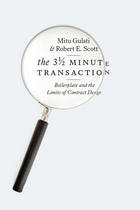 The Three and a Half Minute Transaction: Boilerplate and the Limits of Contract Design
Mitu Gulati and Robert E. Scott
University of Chicago Press, 2012 Boilerplate language in contracts tends to stick around long after its origins and purpose have been forgotten. Usually there are no serious repercussions, but sometimes it can cause unexpected problems. Such was the case with the obscure pari passu clause in cross-border sovereign debt contracts, until a novel judicial interpretation rattled international finance by forcing a defaulting sovereign—for one of the first times in the market’s centuries-long history—to repay its foreign creditors. Though neither party wanted this outcome, the vast majority of contracts subsequently issued demonstrate virtually no attempt to clarify the imprecise language of the clause.
Using this case as a launching pad to explore the broader issue of the “stickiness” of contract boilerplate, Mitu Gulati and Robert E. Scott have sifted through more than one thousand sovereign debt contracts and interviewed hundreds of practitioners to show that the problem actually lies in the nature of the modern corporate law firm. The financial pressure on large firms to maintain a high volume of transactions contributes to an array of problems that deter innovation. With the near certainty of massive sovereign debt restructuring in Europe, The Three and a Half Minute Transaction speaks to critical issues facing the industry and has broader implications for contract design that will ensure it remains relevant to our understanding of legal practice long after the debt crisis has subsided.
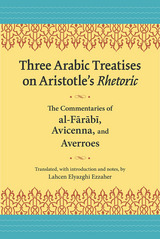 Three Arabic Treatises on Aristotle’s Rhetoric: The Commentaries of al-Farabi, Avicenna, and Averroes
Translated, with introduction and notes, by Lahcen Elyazghi Ezzaher
Southern Illinois University Press, 2015 Winner, 2018 MLA Aldo and Jeanne Scaglione Prize for a Translation of a Scholarly Study of Literature
It is increasingly well documented that western rhetoric’s journey from pagan Athens to the medieval academies of Christian Europe was significantly influenced by the intellectual thought of the Muslim Near East. Lahcen Elyazghi Ezzaher contributes to the contemporary chronicling of this influence in Three Arabic Treatises on Aristotle’s Rhetoric: The Commentaries of al-Farabi, Avicenna, and Averroes, offering English translations of three landmark medieval Arabic commentaries on Aristotle's famous rhetorical treatise together in one volume for the first time. Elegant and practical, Elyazghi Ezzaher’s translations give English-speaking scholars and students of rhetoric access to key medieval Arabic rhetorical texts while elucidating the unique and important contribution of those texts to the revival of European interest in the rhetoric and logic of Aristotle, which in turn influenced the rise of universities and the shaping of Western intellectual life. With a focus on Book I of Aristotle’s Rhetoric, the commentaries ofal-Farabi, Avicenna, and Averroes translated by Elyazghi Ezzaher are paramount examples of an extensive Arabic-Muslim tradition of textual commentary while also serving as rich corollaries to the medieval Greek and Latin rhetorical commentaries produced in Europe. Elyazghi Ezzaher’s translations are each accompanied by insightful scholarly introductions and notes that contextualize—both historically and culturally—these immensely significant works while highlighting a comparative, multidisciplinary approach to rhetorical scholarship that offers new perspectives on one of the field’s foundational texts. A remarkable addition to rhetorical studies, Three Arabic Treatises on Aristotle’s Rhetoric: The Commentaries of al-Farabi, Avicenna, and Averroes not only provides vibrant English translations of essential medieval Arabic rhetorical texts but also challenges scholars and students of rhetoric to consider their own historical, cultural, and linguistic relationships to the texts and objects they study.
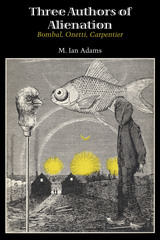 Three Authors of Alienation: Bombal, Onetti, Carpentier
By M. Ian Adams
University of Texas Press, 1975 As a philosophical and social concept, alienation covers a broad range of mental states, both normal and abnormal. Correspondingly, a wide range of literary forms has been employed to deal with this important theme. In Three Authors of Alienation, an exploration of the literary expression of alienation, M. Ian Adams discusses the works of three contemporary Latin American authors. The fiction of María Luisa Bombal, Juan Carlos Onetti, and Alejo Carpentier reflects alienation, disgust with life, and a feeling of nothingness arising from the conditions of modern society. However, each author treats the theme differently. In La última niebla, María Luisa Bombal uses poetic imagery to create the emotional life of the protagonist. Juan Carlos Onetti portrays the schizoid extreme of alienation with a complex of symbols based on changes of vision caused by the mental states of his characters. In Los pasos perdidos, Alejo Carpentier presents the problem of the modern alienated artist who attempts to rid himself of his social alienation by changing times and cultures. In his close analysis of the works discussed, Adams considers each literary element in its context and also in terms of its relation to the larger artistic vision of the author. In addition, he places the works of the three authors in the greater perspective of modern social problems by discussing the concepts of social alienation proposed by Erich Fromm and Erich Kahler. His conclusion is that, although disgust with life and feelings of meaninglessness are at the heart of the experiences of the characters of all three authors, only in Alejo Carpentier’s Los pasos perdidos are social conditions the major cause of alienation. In the works of Bombal and Onetti, alienation is a result not of social conditions, but of factors unique to the characters’ personalities and circumstances. Three Authors of Alienation is a solid contribution to criticism of contemporary Latin American narrative. Adams’s projection of a social problem into the realm of aesthetic experience yields intriguing interpretations of both the problem and the literature.
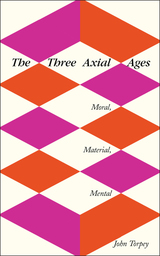 The Three Axial Ages: Moral, Material, Mental
Torpey, John
Rutgers University Press, 2017 How should we think about the “shape” of human history since the birth of cities, and where are we headed? Sociologist and historian John Torpey proposes that the “Axial Age” of the first millennium BCE, when some of the world’s major religious and intellectual developments first emerged, was only one of three such decisive periods that can be used to directly affect present social problems, from economic inequality to ecological destruction.
Torpey’s argument advances the idea that there are in fact three “Axial Ages,” instead of one original Axial Age and several subsequent, smaller developments. Each of the three ages contributed decisively to how humanity lives, and the difficulties it faces. The earliest, or original, Axial Age was a moral one; the second was material, and revolved around the creation and use of physical objects; and the third is chiefly mental, and focused on the technological. While there are profound risks and challenges, Torpey shows how a worldview that combines the strengths of all three ages has the potential to usher in a period of exceptional human freedom and possibility.
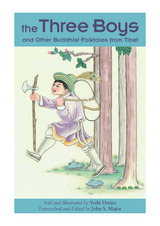 The Three Boys and other Buddhist Folk Tales from Tibet
Yeshi Dorjee and transcribed and edited by John S. Major
University of Hawaii Press, 2007 A virtuous young woman journeys to the Land of the Dead to retrieve the still-beating heart of a king; a wily corpse-monster tricks his young captor into setting him free; a king falls under a curse that turns him into a cannibal; a shepherd who understands the speech of animals saves a princess from certain death. These are just a few of the wondrous tales that await readers of this collection of Tibetan Buddhist folktales. Fifteen stories are told for modern readers in a vivid, accessible style that reflects a centuries-old tradition of storytelling in the monasteries and marketplaces of Tibet.
As a child growing up in a Buddhist monastery, Yeshi Dorjee would often coax the elderly lamas into telling him folktales. By turns thrilling, mysterious, clever, and often hilariously funny, the stories he narrates here also teach important lessons about mindfulness, compassion, and other key Buddhist principles. They will delight readers of all ages, scholars and students, Buddhists and non-Buddhists alike.
 Three Bullets Sealed His Lips
Bruce A. Rubenstein
Michigan State University Press, 1987 The gangland style slaying if State Senator Warren G. Hooper on January 11, 1945, three days before he was to testify before a grand jury investigating alleged corruption in the Michigan legislature, forced coverage of Allied war triumphs from the state's newspaper headlines. National media representatives flocked to Michigan to join local reporters in following the efforts of grand jury special prosecutor Kim Sigler and the State Police to apprehend the killers. Because no arrests ever were made, a 1951 journalistic prediction has proven true: "The Hooper case will continue to come back to remind the people and politicians of Michigan of the black days of 1945 when almost every official of the state had his price." For this reason, the Hooper murder has endured as one of the most intriguing unsolved mysteries in the annals of Michigan crime.
Utilizing interviews, trial transcripts, State police files, and a collection of grand jury testimony long thought to have been destroyed, Professors Bruce A. Rubenstein and Lawrence E. Ziewacz set forth the reason for Hooper's assassination. Written in a lively style, using dialogue taken from court records and correspondence, Three Bullets Sealed His Lips demonstrates that historical writing need not be dull.
Three Byzantine Military Treatises
George T. Dennis
Harvard University Press, 1985 Threatened on all sides by relentless enemies for a thousand years, the Byzantines needed ready armies and secure borders. To this end, experienced commanders compiled practical handbooks of military strategy. Three such manuals are presented here. The Anonymous Byzantine Treatise on Strategy was written by a retired combat engineer around the middle of the sixth century, while Skirmishing and Campaign Organization and Tactics date from the late tenth century and concern warfare in the mountains along the Syrian frontier and campaigns in the rugged terrain of the Balkans. These treatises provide information not only on tactics and weaponry but also on the motivations of the men who risked their lives to defend the empire.
Three Capitals: St. Stephens, Huntsville, and Cahawba, 1818-1826
William H. Brantley Jr
University of Alabama Press, 1976 "Three Capitals is an in-depth study of Alabama's first three seats of government--St. Stephens, Huntsville, and Cahawba.... The University of Alabama Press has reprinted the book in a handsome new edition with a pertinent introduction by Malcolm C. McMillan. Brantley's study is a tribute to the accomplishments of an amateur historian and contains a wealth of useful information." --Bulletin of the History of the Early American Republic
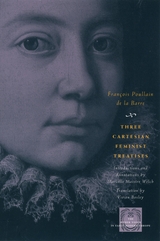 Three Cartesian Feminist Treatises
François Poullain de la Barre
University of Chicago Press, 2002 One of the most radical feminist theorists in Europe before the nineteenth century, François Poullain de la Barre (1647-1723) was a man way ahead of his time. Applying Cartesian principles to "the Woman Question," Poullain demonstrated by rational deduction that the supposedly "self-evident" inequality of the sexes was nothing more than unfounded prejudice.
Poullain published three books (anonymously) on this topic in the 1670s, all of which are included in English translation in this volume. In On the Equality of the Two Sexes he argued that the supposedly "natural" inferiority of women was culturally produced. To help women recognize and combat this prejudice, Poullain advocated a modern, enlightened feminine education in On the Education of Ladies. Finally, since his contemporaries largely ignored Poullain's writings, he offered a rebuttal to his own arguments in On the Excellence of Men—a rebuttal that he promptly countered, strengthening his original positions.
A truly modern feminist, Poullain laid the intellectual groundwork for the women's liberation movement centuries before it happened.
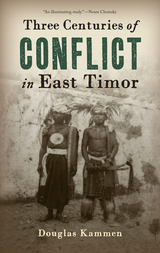 Three Centuries of Conflict in East Timor
Kammen, Douglas
Rutgers University Press, 2015 One of the most troubling but least studied features of mass political violence is why violence often recurs in the same place over long periods of time. Douglas Kammen explores this pattern in Three Centuries of Conflict in East Timor, studying that region’s tragic past, focusing on the small district of Maubara. Once a small but powerful kingdom embedded in long-distance networks of trade, over the course of three centuries the people of Maubara experienced benevolent but precarious Dutch suzerainty, Portuguese colonialism punctuated by multiple uprisings and destructive campaigns of pacification, Japanese military rule, and years of brutal Indonesian occupation. In 1999 Maubara was the site of particularly severe violence before and after the UN-sponsored referendum that finally led to the restoration of East Timor’s independence. Beginning with the mystery of paired murders during East Timor’s failed decolonization in 1975 and the final flurry of state-sponsored violence in 1999, Kammen combines an archival trail and rich oral interviews to reconstruct the history of the leading families of Maubara from 1712 until 2012. Kammen illuminates how recurrent episodes of mass violence shaped alliances and enmities within Maubara as well as with supra-local actors, and how those legacies have influenced efforts to address human rights violations, post-conflict reconstruction, and the relationship between local experience and the identification with the East Timorese nation. The questions posed in Three Centuries of Conflict in East Timor about recurring violence and local narratives apply to many other places besides East Timor—from the Caucasus to central Africa, and from the Balkans to China—where mass violence keeps recurring. Download open access ebook here.
 Three Centuries of Harpsichord Making
Frank Hubbard
Harvard University Press Here are the traditions of harpsichord making as they might have been taught to young apprentices in five countries where the craft once flourished: Italy, Flanders, France, England, and Germany. The period covered ranges from approximately 1500, when concrete data became available, to 1800, after which the nature of the instrument is no longer of musicological significance.
The author’s aim is to “give enough information to make it possible for builders of harpsichords to base their work on certain knowledge of the designs and methods of earlier makers; to guide players of the harpsichord in their search for appropriate instruments, dispositions, and registrations in recreating the music of the past; and to serve as a useful body of information for historians and editors of early keyboard music.”
A chapter each is devoted to the five most important schools of harpsichord making. Over forty plates illustrate the most typical harpsichords of each country. Each set of drawings includes a plan drawn to scale, the interior of the instrument, and interesting details of action and construction. These are supplemented by reproductions of illustrations taken from early sources. The appendixes contain texts of relevant documents, including inventories of the shops of some prominent French makers and contemporary descriptions of instruments.
Frank Hubbard has drawn material from contemporary descriptions of instruments and the mechanical arts such as those found in encyclopedias, technical treatises, books on music theory, and manuals for craftsmen. In addition he has examined hundreds of instruments in European and American collections. His exceptional position as an internationally known harpsichord maker as well as a student of harpsichord history allows him to discuss technical as well as historical matters that would be outside the competence of a musicologist.
Three Centuries of Harvard, 1636–1936
Samuel Eliot Morison
Harvard University Press This one-volume history of Harvard is not so much a summary of Samuel Eliot Morison’s monumental work [The Tercentennial History of Harvard College and University, 1636–1936] as it is an entirely fresh handling of his vast material.
With a mind saturated in the lore and tradition at his command, Professor Morison has sat down to tell the whole story of Harvard informally and briefly. Documentation and all the learned apparatus of scholarly research are therefore omitted; but the same genial humor, the same ability to see the human implications of past events, that characterize his larger, multi-volume series on Harvard are preserved in this. The result is a marvelously entertaining volume, the history of Harvard that everyone has been waiting for, a model of vitalized historical writing.
 Three Chestnut Horses
Margita Figuli
Central European University Press, 2014 This gem of Slovak naturalism was written in 1940. The story takes the reader to a mountain village. The protagonist narrates the vicissitudes, suffering, and success he experiences as he pursues a love affair, resulting in the triumph of pure love. Peter has been in love with a girl—Magdalena—since childhood and asks her to marry him. But he is too late, because a rich man, Jano Zapotocný, has already proposed to Magdalena, a proposal that her greedy mother promptly accepted on her behalf. Magdalena, out of respect for her mother's wishes, accepts the engagement. However, Magdalena promises Peter that she will put off marrying Jano and will marry him instead if he can prove that he truly loves her. He must build a house and earn a living. After almost two years Peter returns to show her that he kept his promise. But Magdalena is already married; Jano has raped her and she is pregnant. Desperate, Peter is tempted to take out his anger on Jano, nevertheless he resists the impulse. In the end, the author finds a way to reward Peter's faith in love and morality.
Three Christological Treatises
St. Cyril of Alexandria
Catholic University of America Press, 2014 Twenty-nine in all, these letters cover all but three of Cyril's years as a bishop. The first twelve were published in 2009 (Fathers of the Church 118). The present volume completes the set. Festal letters were used in Alexandria primarily to announce the beginning of Lent and the date of Easter. They also served a catechetical purpose, however, allowing the Patriarch an annual opportunity to write pastorally not just about issues facing the entire see, but also about the theological issues of the day. Thus, in these letters we catch a glimpse of Cyril the pastor writing about complex theology in an uncomplicated way. These letters also illuminate other realities of the ancient church in Alexandria, especially the relationship with the Jewish community and the rising influence of asceticism.
 Three Cities After Hitler: Redemptive Reconstruction Across Cold War Borders
Andrew Demshuk
University of Pittsburgh Press, 2021 Winner, 2023 SAH Alice Davis Hitchcock Book Award
Three Cities after Hitler compares how three prewar German cities shared decades of postwar development under three competing post-Nazi regimes: Frankfurt in capitalist West Germany, Leipzig in communist East Germany, and Wrocław (formerly Breslau) in communist Poland. Each city was rebuilt according to two intertwined modern trends. First, certain local edifices were chosen to be resurrected as “sacred sites” to redeem the national story after Nazism. Second, these tokens of a reimagined past were staged against the hegemony of modernist architecture and planning, which wiped out much of whatever was left of the urban landscape that had survived the war. All three cities thus emerged with simplified architectural narratives, whose historically layered complexities only survived in fragments where this twofold “redemptive reconstruction” after Nazism had proven less vigorous, sometimes because local citizens took action to save and appropriate them. Transcending both the Iron Curtain and freshly homogenized nation-states, three cities under three rival regimes shared a surprisingly common history before, during, and after Hitler—in terms of both top-down planning policies and residents’ spontaneous efforts to make home out of their city as its shape shifted around them.
Three Civilizations, Two Cultures, One State: Canada's Political Traditions
Douglas Verney
Duke University Press, 1986 This volume examines 150 years of Canadian political life in light if one of the country's most intractable problems, its cultural identity. Although many thoughtful Canadians remain dubious about the existence of a truly Canadian way of life, Douglas Verney argues that in fact Canada's political traditions embody and reflect a unique culture; and that although the Canadian government has been the primary instrument for nurturing this culture, it has been at the same time the entity most guilty of obscuring and ignoring it.
Three Classical Poets: Sappho, Catullus, and Juvenal
Richard Jenkyns
Harvard University Press, 1982 In this engaging essay Richard Jenkyns shows us how to read three quite different ancient poets. In a close and sensitive reading of Sappho, Catullus, and Juvenal, Jenkyns delineates the uniqueness of the poet's individual voice in relation to poetic traditions. His book constitutes a challenge to the view that one method will suffice for the interpretation of ancient poetry. He seeks to demonstrate that we can have no substitute for flexible and humane judgment, liberated from critical dogma, if we are to understand the great writers of the past. It is Jenkyns' appealing habit to clarify and illustrate his points by drawing analogies from modern and ancient literature. He deploys his wide learning with agility and grace.
Three Comedies
Aristophanes
University of Michigan Press, 1969 Contains The Birds, The Clouds, and The Wasps
 The Three Cs of Higher Education: Competition, Collaboration and Complementarity
Mark O'Hara
Central European University Press, 2019 The thirteen papers in this collection address three aspects of higher education, primarily in Europe but also in the United States. These aspects are competition, collaboration, and complementarity, both on the level of policy and on the practical level of impact on students and staff. Competition, especially for funding, occurs between and within institutions. Collaboration, more than a basic code of conduct, has become a political principle across Europe. Complementarity in the market for higher education facilitates this collaboration. The themes and contexts in higher education for which the three Cs are examined include missions and identities, response to external forces, the impact of evaluation systems and ranking schemes, the effects of globalisation, intercultural awareness and gender imbalance, and the challenges of student participation. Statistical tables and visual aids support the analysis and arguments. This book is the fifth in a series of publications drawn from the annual Forums of the European Association of Institutional Research (EAIR) from 2013 onwards
Three Demonstrations and a Funeral and Other Essays
Maria de Ponte, Kepa Korta, and John Perry
CSLI, 2024 A collaboration between three distinguished professors of linguistics and philosophy.
The result of the collaboration between three distinguished philosophers, this book comprises the best sample of one of the most original theories in contemporary philosophy of language and communication—Critical Pragmatics. They present the development of the theory from its initial sprout, with “Three Demonstrations and a Funeral” (2006) as its first visible result, to a critical clarification of its tenets in “Critical Pragmatics: Nine Misconceptions” (2023). After Korta and Perry’s Critical Pragmatics (2011), this is the most important book on Critical Pragmatics, as it was conceived, developed and applied by its creators. Having de Ponte, Korta and Perry’s most important papers together on one place will be of great value to both philosophers and linguists.
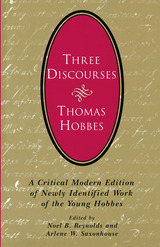 Three Discourses: A Critical Modern Edition of Newly Identified Work of the Young Hobbes
Thomas Hobbes
University of Chicago Press, 1995 For the first time in three centuries, this book brings back into print three discourses now confirmed to have been written by the young Thomas Hobbes. Their contents may well lead to a resolution of the long-standing controversy surrounding Hobbes's early influences and the subsequent development of his thought. The volume begins with the recent history of the discourses, first published as part of the anonymous seventeenth-century work, Horae Subsecivae. Drawing upon both internal evidence and external confirmation afforded by new statistical "wordprinting" techniques, the editors present a compelling case for Hobbes's authorship.
Saxonhouse and Reynolds present the complete texts of the discourse with full annotations and modernized spellings. These are followed by a lengthy essay analyzing the pieces' significance for Hobbes's intellectual development and modern political thought more generally. The discourses provide the strongest evidence to date for the profound influences of Bacon and Machiavelli on the young Hobbes, and they add a new dimension to the much-debated impact of the scientific method on his thought. The book also contains both introductory and in-depth explanations of statistical "wordprinting."
The Three Dynamisms of Faith: Searching for Meaning, Fulfillment, and Truth
Louis Roy
Catholic University of America Press, 2017 Is the faith journey a matter of reflection, of emotion, or of obedience? Is there valid and convincing evidence that does enable human beings to assent to Jesus Christ and his message? What is the influence of cognitive assumptions and of affective tende
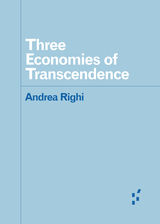 Three Economies of Transcendence
Andrea Righi
University of Minnesota Press, 2025 Exploring climate change through the interconnections between sociality, theory of money, and a different concept of time
Three Economies of Transcendence offers a sharp critique of how transcendence underpins the symbolic, economic, and environmental crises of the modern world. Andrea Righi identifies three distinct “economies of transcendence” that sustain neoliberal systems of power. Termed the economy of rank, the economy of infinite valorization, and the phallic economy of time, these economies perpetuate hierarchies, sacrifices, and ecological destruction. Through this framework, Righi not only diagnoses the crisis but also proposes an immanent model of economy that fosters solidarity and is expressly pro-social and ecologically responsible. This thought-provoking book links climate change to Western cultural and symbolic mechanisms, showing that transformative action must address these deep-seated structures. Righi envisions a future rooted in our shared spatio-temporal existence, challenging the atomizing rivalries and endless growth of neoliberalism.
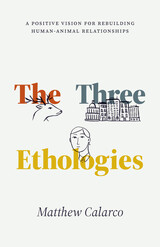 The Three Ethologies: A Positive Vision for Rebuilding Human-Animal Relationships
Matthew Calarco
University of Chicago Press, 2024 A transformative vision for human-animal relations on personal, social, and environmental levels.
The Three Ethologies offers a fresh, affirmative vision for rebuilding human-animal relations. Venturing beyond the usual scholarly and activist emphasis on restricting harm, Matthew Calarco develops a new philosophy for understanding animal behavior—a practice known as ethology—through three distinct but interrelated lenses: mental ethology, which rebuilds individual subjectivity; social ethology, which rethinks our communal relations; and environmental ethology, which reconfigures our relationship to the land we co-inhabit with our animal kin. Drawing on developments in philosophy, (eco)feminist theory, critical geography, Indigenous studies, and the environmental humanities, Calarco casts an inspiring vision of how ethological living can help us to reimagine our ideas about goodness, truth, and beauty.
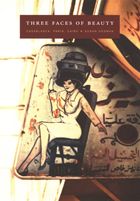 Three Faces of Beauty: Casablanca, Paris, Cairo
Susan Ossman
Duke University Press, 2002 Three Faces of Beauty offers a unique approach to understanding globalization and cultural change based on a comparative, ethnographic study of a nearly universal institution: the beauty salon. Susan Ossman traces the images and words of the beauty industry as they developed historically between Paris, Cairo, and Casablanca and then vividly demonstrates how such images are embodied today in salons located in each city.
By examining how images from fashion magazines, film, and advertising are enacted in beauty salons, Ossman demonstrates how embodiment is able to display and rework certain hierarchies. While offering the possibility of freedom from the tethers of status, nation, religion, and nature, beauty is created by these very categories and values, Ossman shows. Drawing on hundreds of interviews, she documents the various rituals of welcome, choice-making, pricing practices, and spatial arrangements in multiple salons . She also reveals ways in which patrons in all three cities imagine and co-opt looks they believe are fashionable in the other cities. By observing salons as scenes of instruction, Ossman reveals that beautiful bodies evolve within the intertwining contexts of media, modernity, location, time, postcolonialism, and male expectation.
Three Friends: Roy Bedichek, J. Frank Dobie, Walter Prescott Webb
By William A. Owens
University of Texas Press, 1975 Roy Bedichek, J. Frank Dobie, and Walter Prescott Webb—a naturalist, a folklorist, and a historian—all taught at the University of Texas, lived only a few blocks apart, and saw each other almost every day. The true cement of their friendship, however, was the correspondence that makes up much of this book. They wrote not to exchange information, but to communicate ideas, to nail down the generalities of conversation, and, above all, to challenge, encourage, and stimulate one another. William A. Owens, who knew all three personally, has tied their letters together with his own observations and with transcripts of tape interviews with the men. The result is a unique book, a combination of biography and personal history that portrays not only the three friends, but the land they loved as well.
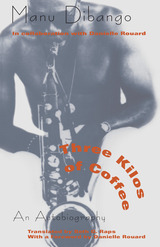 Three Kilos of Coffee: An Autobiography
Manu Dibango and Danielle Rouard
University of Chicago Press, 1994 In 1948, at the age of fifteen, Manu Dibango left Africa for France, bearing three kilos of coffee for his adopted family and little else. This book chronicles Manu Dibango's remarkable rise from his birth in Douala, Cameroon, to his worldwide success—with Soul Makossa in 1972—as the first African musician ever to record a top 40s hit.
Composer, producer, performer, film score writer and humanitarian for the poor, Manu Dibango defines the "African sound" of modern world music. He has worked with and influenced such artists as Art Blakey, Don Cherry, Herbie Hancock, Harry Belafonte, Paul Simon, and Johnny Clegg. In Africa, he has helped younger musicians, performed benefit concerts, and transcribed for the first time the scores and lyrics of African musicians.
The product of a "mixed marriage" (of different tribes and religions) who owes allegiances to both Africa and Europe, Dibango has always been aware of the ambiguities of his identity. This awareness has informed all of the important events of his life, from his marriage to a white Frenchwoman in 1957, to his creation of an "Afro-music" which joyfully blends blues, jazz, reggae, traditional European and African serenades, highlife, Caribbean and Arabic music. This music addresses the meaning of "Africanness" and what it means to be a Black artist and citizen of the world.
This lively and thoughtful memoir is based on an extensive set of interviews in 1989 with French journalist Danielle Rouard. Richly illustrated with photographs, this book will be a must for readers of jazz biographies, students of African music and ethnomusicology, and all those who are lovers of Manu Dibango's unique artistry and accomplishments.
Three Language List of Botanical Name Components
A. Radcliffe-Smith
Royal Botanic Gardens, Kew, 2000 Listing Greek and Latin words, roots or elements used or usable in botanical names and epithets, this book has been compiled in order to help authors to avoid mixture of Greek and Latin in new coinages and understand the meanings of Latin and Greek compound-coinages already in literature. Each list is presented alphabetically under Greek, Latin and English headings, together with equivalents in the other two languages. Besides the main list, there is a three-language supplementary list of 1,620 classical plant names and a listing of commonly found numerals.
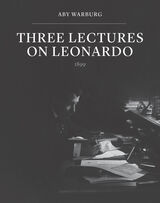 Three Lectures on Leonardo
Aby Warburg
University of London Press, 2020 In 1899 the young Aby Warburg gave a series of lectures in his hometown of Hamburg on the life and work of Leonardo da Vinci. At this time, Warburg lived and researched in Florence, and the lecture series was designed to raise his profile as a private scholar back home, but also, as Warburg’s brother Max put it, to give something back to the community. The Leonardo lectures, as they came to be known, are unique in the oeuvre of this scholar who tended to engage with very specific research problems.
With an average attendance of more than 400, Warburg’s lectures were a great success, and a fourth meeting, accompanied by original Leonardo drawings and photographic prints in the Hamburg Kunsthalle, had to be repeated. Marking the fifth centenary of Leonardo’s death and the 120th anniversary of Warburg’s first public lecture series, this volume contains the full translated text of Warburg’s previously unpublished lectures. This translation, which is based on the texts as they survive in Warburg’s three manuscripts located in the Warburg Institute Archive, will bring these groundbreaking lectures to a new audience.
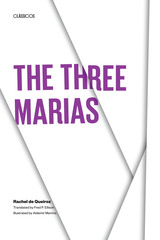 The Three Marias
By Rachel de Queiroz
University of Texas Press, 1963 Through this translation of As Três Marias the literary achievements of Rachel de Queiroz may at last be judged and appreciated by the English-reading public. Since none of her four novels has previously been translated into English, The Three Marias will be, for many non-Brazilians, an introduction to this nationally known South American author whose books have been widely praised for their artistic merits. Her literary works are colored by her projected personality, by an intense feeling for her own people, by an omnipresent social consciousness, and by personal experiences in the arid backlands of her native state of Ceará. Basing this story on certain of her own recollections from the nineteen-twenties, Rachel de Queiroz tells of a girl growing up in the seaport town of Fortaleza, in northeastern Brazil. Fred P. Ellison, whose special field is Brazilian and Spanish-American literature, has captured in his translation the author's graceful style and simplicity of language, and has successfully retained the perspective of an idealistic and gradually maturing girl.
Three Men in Texas: Bedichek, Webb, and Dobie
Essays by their Friends in the Texas Observer, Edited by Ronnie Dugger
University of Texas Press, 1967 This book is a tribute to "an incomparable triumvirate." "One was a naturalist, one a historian, and one a chronicler, but each of them was each of these. The manly love between them, a handsome thing in times and places blighted by great ugliness and banality, shone from them into their friends and contemporaries, and they shared themselves freely with those younger than they who went to them wishing to learn from them." Most of this collection of writing by friends of Roy Bedichek, Walter Prescott Webb, and J. Frank Dobie originally appeared in special editions of the Texas Observer devoted to each of the three men. Some pieces were, however, written expressly for this volume.
The Three Minute Thesis in the Classroom: What Every ESL Teacher Needs to Know
Heather Boldt
University of Michigan Press, 2019 The Three Minute Thesis (3MT®) competition is an annual academic speaking competition that challenges graduate students to present their thesis and its significance to a non-specialist audience in just three minutes. In The Three Minute Thesis in the Classroom, author Heather Boldt focuses on how the 3MT can be used in an ESL or EAP classroom to improve students' speaking skills, particularly about research. This Brief Instructional Guide uses data from the author's corpus of 3MT transcripts to reveal the six moves typical of this type of presentation and then provides instructors with a variety of classroom applications in the areas of vocabulary, pronunciation, describing research to non-specialists, and effective slide design.
Three Modern Italian Poets: Saba, Ungaretti, Montale
Joseph Cary
University of Chicago Press, 1993 Focusing on the most recent triad of Italian poetic genius—Umberto Saba, Giuseppe Ungaretti, and Eugenio Montale—Joseph Cary not only presents striking biographical portraits as he facilitates our understanding of their poetry; he also guides us through the first few decades of twentieth-century Italy, a most difficult period in its literary and cultural development.
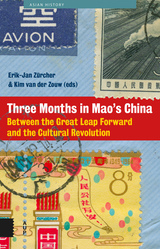 Three Months in Mao's China: Between the Great Leap Forward and the Cultural Revolution
Edited by Erik-Jan Zürcher and Kim van der Zouw
Amsterdam University Press, 2017 In the fall of 1964, sinologist Erik Zürcher travelled to China for the first time, a country he had been studying since 1947. A collection of Zürcher's personal writings from his trip, including letters and diary entries, Three Months in Mao's China offers not only new insights about the great scholar, but also a rich picture of communist China, which was in those days still almost completely inaccessible to Westerners.
During a tumultuous time in world politics, as Nikita Khrushchev was deposed, Lyndon Johnson won the US presidential election against Barry Goldwater, and China became a nuclear power, Zürcher experienced the reality of China under Mao Zedong. Only recently discovered, these documents portray, viewed through an expert's eye, a land in the midst of its own massive political, social, and economic change. Both a fascinating account by an informed outsider and a reminder of just how much China and the rest of the world have changed over the last fifty years, this is essential reading for anyone interested in East Asia and Asian history as a whole.
Three Napoleonic Battles
Harold T. Parker
Duke University Press, 1983 This narrative account of three Napoleonic battles adheres rather closely to the Aristotelian configuration of evolving tragedy. The historian succeeds in presenting herein events and character not only in historical reality but also in unities employed by the artist or tragedian. For a beginning of this lively, military story, Harold T. Parker chooses a portrayal of Napoleon at the height of his power, the battle of Friedland. The middle episode is concerned with Napoleon in his first serious personal check, the battle of Aspern-Essling. To complete the unity and to conclude the tragic progression, the author resurveys the episode of Napoleon's final defeat at the battle of Waterloo.
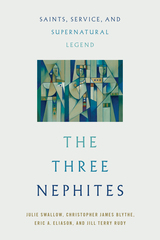 The Three Nephites: Saints, Service, and Supernatural Legend
Julie Swallow, Christopher James Blythe, Eric A. Eliason, and Jill Terry Rudy
University of Illinois Press, 2025 Stories of encounters with the Three Nephites, immortal saint-like figures, dominate the folklore of the Latter-day Saint tradition. The authors of this volume use hundreds of legends collected by the renowned folklorist William A. Wilson from across a lifetime of research, study, and interviews to focus on the different themes exhibited by the Three Nephites and show that LDS culture, beliefs, and values are embodied by and through the Three Nephites. Each chapter focuses on a different theme from Three Nephites lore. “Vanishing Hitchhiker Nephites” addresses stories of the Nephites’ travels. “The Worldwide End of the World” considers the Nephites as harbingers of the Second Coming. “Proclaiming-the-Gospel Stories” examines the interactions of the Three Nephites with missionaries. “Mix-ups, High Jinks, and Jokes” explores Nephite stories aimed at getting laughs. “That Your Joy Might Be Full” analyzes the types of service the Three Nephites render and reflects on the connection to the Church’s injunction to serve others. A one-of-a-kind collection, The Three Nephites allows readers to see the extent that this supernatural legend has played in Latter-day Saint lore.
Three Nigerian Emirates: A Study in Oral History
Victor N. Low
Northwestern University Press, 1972 Three Nigerian Emirates: A Study in Oral History is a widely held study on a scarcely examined region of Nigeria. Victor N. Low presents a detailed account of the leaders, people, and culture of the Hadejia, Katagum, and Gombe regions documented in a transcribed oral history. This work presents a valuable portrait of societies where the tradition of memory and oral history are the only means of remembering the past.
 Three Novellas
Thomas Bernhard
University of Chicago Press, 2003 Thomas Bernhard is "one of the masters of contemporary European fiction" (George Steiner); "one of the century's most gifted writers" (New York Newsday); "a virtuoso of rancor and rage" (Bookforum). And although he is favorably compared with Franz Kafka, Samuel Beckett, and Robert Musil, Thomas Bernhard still remains relatively unknown in America.
Uninitiated readers should consider Three Novellas a passport to the absurd, dark, and uncommonly comic world of Bernhard. Two of the three novellas here have never before been published in English, and all of them show an early preoccupation with the themes-illness and madness, isolation, tragic friendships-that would obsess Bernhard throughout his career. Amras, one of his earliest works, tells the story of two brothers, one epileptic, who have survived a family suicide pact and are now living in a ruined tower, struggling with madness, trying either to come fully back to life or finally to die. In Playing Watten, the narrator, a doctor who lost his practice due to morphine abuse, describes a visit paid him by a truck driver who wanted the doctor to return to his habit of playing a game of cards (watten) every Wednesday—a habit that the doctor had interrupted when one of the players killed himself. The last novella, Walking, records the conversations of the narrator and his friend Oehler while they walk, discussing anything that comes to mind but always circling back to their mutual friend Karrer, who has gone irrevocably mad. Perhaps the most overtly philosophical work in Bernhard's highly philosophical oeuvre, Walking provides a penetrating meditation on the impossibility of truly thinking.
Three Novellas offers a superb introduction to the fiction of perhaps the greatest unsung hero of twentieth-century literature. Rarely have the words suffocating, intense, and obsessive been meant so positively.
Three Novellas
Earla A. Wilputte
Michigan State University Press The three novellas presented here—The Ditress'd Orphan, The City Jilt, and The Double Marriage—were published separately in 1726, but were originally intended for a single volume. Haywood was a dangerous entity in the eighteenth century: a writing woman, writing for women. Like many female authors before her, Haywood was labeled and condemned by men as unfeminine, licentious, immodest and usurping. She dared to wield that masculine instrument, the pen, and speak her mind in public like a man.
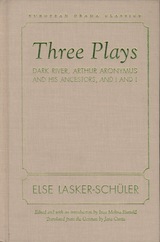 Three Plays: Dark River, Arthur Aronymus and His Ancestors, and I and I
Else Lasker-Schuler
Northwestern University Press, 2005 Avant-garde plays by a gifted and unconventional German Jewish writer, one of the few women among the Expressionists of the Berlin Moderns
Famous for her poetry and infamous for her bohemian lifestyle, as well as her association with political radicals, Else Lasker-Schüler (1869–1945) is only now returning to just renown as one of the few women writers within the Expressionist movement of the early twentieth century. These plays-Dark River, Arthur Aronymus and His Ancestors, and I and I-in Jane Curtis's fluid translation, allow readers of English to experience the radically avant-garde style that put Lasker-Schüler on a par with Brecht in her day, as well as the passionate treatment of questions of gender, ethnicity, and sexuality that placed her well ahead of her time. Lasker-Schüler's plays reflect her unusual life among the Berlin Moderns of the 1910s and 20s. The daughter of a well-to-do Jewish banker and builder, Else Schüler gave up her bourgeois existence as a doctor's wife for the artistic, social, and political uncertainties that would characterize the rest of her life. Many of her finest poems and plays were written amidst the cafe society of Berlin, where she knew some of the great expressionist artists of the period. The death of her beloved son in 1927, which led her to intense introspection and reflection on the Jewish tradition, especially mysticism and the Kabbalah, also marked the beginning of Lasker-Schüler's years of tragedy, loss, and dislocation, culminating in her flight from Nazi Germany to Switzerland and then Jerusalem, where she ended her days as an eccentric pauper.
The plays in this volume mark Lasker-Schüler's movement away from the traditional aesthetic canon, revealing a unique formal development from naturalistic expressionist episodes in the lyrical Dark River to a historicizing politicization of the theater in Arthur Aronymous to the forms of montage and "epic" presentations in I and I. A short preface by Inca Molina Rumold places each play in its historical, biographical, and artistic context.
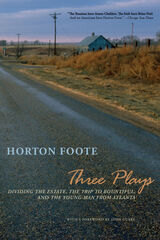 Three Plays: Dividing the Estate, The Trip to Bountiful, and The Young Man from Atlanta
Horton Foote
Northwestern University Press, 2008 Bringing together the rich characters and wry humor of a celebrated Texas scribe, this book collects three of Foote's most recognized plays. In these works, Foote deftly combines the claustrophobia of the Southern families from Tennessee Williams, the physical and psychological dysfunctions of Eugene O'Neill's families, and the humor and pathos of small town Southern life portrayed by Flannery O'Connor. In the dark comedy Dividing the Estate, matriarch Stella Gordon is dead set against the parceling out of her clan's land despite the financial woes brought on by the oil bust of the 1980s. In the course of the play, the power of petty self-interest and long-held resentments makes even painful compromise an elusive goal. Widely acclaimed in a 2007 production at Primary Stages, the play will open on Broadway in November 2008. In The Trip to Bountiful, Carrie Watts is determined to escape a cramped, unpleasant life in a small Houston apartment with her son and avaricious daughter-in-law. Her burning desire is to return to the now desolate town of her childhood, against the inexorability of change and the refuge of memory. Foote earned an Oscar nomination for Best Adapted Screenplay in 1985 for his work on Bountiful. The Pulitzer Prize-winning The Young Man from Atlanta tells the story of a couple living in Houston in 1950, suffering the aftershocks of the mysterious death of their son. Will and Lily Dale Kidder try to hold onto their beliefs about their son's life and death and the possibilities for their own lives, but both are dealt a shattering blow by the young man of the title, a friend of their son's who never appears in the play. Foote's pitch-perfect characters and sensitive eye for interpersonal relationships continue to place him at the top of playwrights working today. This new collection brings his best to new audiences.
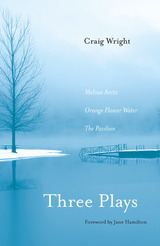 Three Plays: Melissa Arctic, Orange Flower Water, and The Pavilion
Craig Wright
Northwestern University Press, 2012 Craig Wright is one of the most widely produced, consistently entertaining playwrights of his generation. The three plays gathered in this volume—Melissa Arctic (winner of the 2005 Helen Hayes Award), Orange Flower Water, and The Pavilion—are all set in the fictional town of Pine City, Minnesota. The plays share a focus on love and relationships and feature a consistent undercurrent of observation and speculation about the nature of time. Melissa Arctic brings Shakespeare’s The Winter’s Tale into the present, retaining the original’s captivating mix of the comic and tragic. A brutally frank exploration of marriage, Orange Flower Water examines the irresistible lure and poisonous effects of unrealistic expectations within love, and portrays the inescapably compromised contours of relationships founded on adultery. The Pavilion, a lyrical and rueful homage to Our Town, is a meditation on dashed dreams and unquenchable hopes, set at a twenty-year high school reunion. In all three plays, Wright shows himself to be one of the most perceptive and engaging playwrights working today.
Three Plays of Racine: Phaedra, Andromache, and Britannicus
Jean Baptiste Racine
University of Chicago Press, 1961 "George Dillon has elected for speed and clarity; his speed, of which short quotations can impart no notion, is his equivalent for Racine's impetuous dexterity with the French Alexandrine. . . . Momentum, in such a version, is everything. It stands as a homage to Racine's strength of construction . . . and to the expressive power of his themes, on which Mr. Dillon's prefaces have eloquent and sensible things to say."—Hugh Kenner, National Review
"His literal and flexible blank verse actually forms the nearest thing in English to the longer-measured rhymed couplets of Racine; even an ordinary reading aloud of so faithful a rendering provides something of the experience that Proust described."—Elliott Coleman, Poetry
"A superb introduction . . . flawless translations, infused with poetic fire and charm."—Margaret Carpenter, Norfolk Virginian-Pilot
 Three Revolutions: Steering Automated, Shared, and Electric Vehicles to a Better Future
Daniel Sperling with Anne Brown, Robin Chase, Michael J. Dunne, Lewis M. Fulton, Susan Pike, Steven E. Polzin, Susan Shaheen, Brian D. Taylor, Levi Tillemann, and Ellen van der Meer
Island Press, 2018 For the first time in half a century, real transformative innovations are coming to our world of passenger transportation. The convergence of new shared mobility services with automated and electric vehicles promises to significantly reshape our lives and communities for the better—or for the worse.
The dream scenario could bring huge public and private benefits, including more transportation choices, greater affordability and accessibility, and healthier, more livable cities, along with reduced greenhouse gas emissions. The nightmare scenario could bring more urban sprawl, energy use, greenhouse gas emissions, and unhealthy cities and individuals.
In Three Revolutions, transportation expert Dan Sperling, along with seven other leaders in the field, share research–based insights on potential public benefits and impacts of the three transportation revolutions. They describe innovative ideas and partnerships, and explore the role government policy can play in steering the new transportation paradigm toward the public interest—toward our dream scenario of social equity, environmental sustainability, and urban livability.
Many factors will influence these revolutions—including the willingness of travelers to share rides and eschew car ownership; continuing reductions in battery, fuel cell, and automation costs; and the adaptiveness of companies. But one of the most important factors is policy.
Three Revolutions offers policy recommendations and provides insight and knowledge that could lead to wiser choices by all. With this book, Sperling and his collaborators hope to steer these revolutions toward the public interest and a better quality of life for everyone.
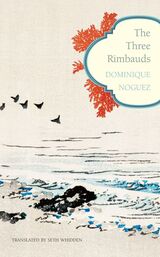 The Three Rimbauds
Dominique Noguez
Seagull Books, 2021 Mingling fact and fiction, The Three Rimbauds imagines how Rimbaud’s life would have unfolded had he not died at the age of thirty-seven.
The myth of Arthur Rimbaud (1854–1891) focuses on his early years: how the great enfant terrible tore through the nineteenth-century literary scene with reckless abandon, leaving behind him a trail of enemies, the failed marriage of an ex-lover who shot him, and a body of revolutionary poetry that changed French literature forever. He stopped writing poetry at the age of twenty-one when he left Europe to travel the world. He returned only shortly before his death at the age of thirty-seven.
But what if 1891 marked not the year of his death, but the start of a great new beginning: the poet’s secret return to Paris, which launched the mature phase of his literary career? This slim, experimental volume by Dominique Noguez shows that the imaginary “mature” Rimbaud—the one who returned from Harar in 1891, married Paul Claudel’s sister in 1907, converted to Catholicism in 1925, and went on to produce some of the greatest works in twentieth-century French prose—was already present in the almost forgotten works of his childhood, in style and themes alike. Only by reacquainting ourselves with the three Rimbauds—child, young adult, and imaginary older adult—can we truly gauge the range of the complete writer.
 The Three R’s Plus: What Today’s Schools are Trying to Do and Why
Robert H. Beck
University of Minnesota Press, 1956
The Three R's Plus was first published in 1956. Minnesota Archive Editions uses digital technology to make long-unavailable books once again accessible, and are published unaltered from the original University of Minnesota Press editions.
Do the schools still teach the three R's or are they neglecting these fundamentals? Should boys and girls be made to study things that don't interest them? What's happened to the report card? Have drill and memorization a place in today's teaching methods? What are the basic ideas behind modern education?
Questions like these are constantly being asked by parents and other responsible citizens in a sincere effort to learn more about what the public schools are doing and why. Such questions deserve thoughtful and thorough answers that will provide a basis for realistic understanding and constructive thinking about present-day schools. In this book, educators themselves explain, in understandable terms, the concepts, the methods, and the aims that underlie our public school teaching today.
Thirty-one experts contribute chapters about their particular fields. The chapters are arranged in sections on Changed and Changing Conceptions, Subjects and Services, and Issues and Interest. The book explains modern educational philosophy and describes the methods of teaching, as applied to specific subject fields, that are based on these theories. The final section discusses such controversial problems as the financial support of the schools and the role of religion in the public school.
The majority of the contributors are members of the faculty of the University of Minnesota but among the authors are included also several administrators in the Minneapolis and St. Paul public school systems.
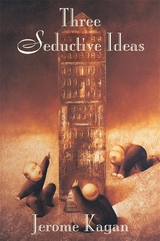 Three Seductive Ideas
Jerome Kagan
Harvard University Press, 2000 Do the first two years of life really determine a child’s future development? Are human beings, like other primates, only motivated by pleasure? And do people actually have stable traits, like intelligence, fear, anxiety, and temperament? This book, the product of a lifetime of research by one of the founders of developmental psychology, takes on the powerful assumptions behind these questions—and proves them mistaken. Ranging with impressive ease from cultural history to philosophy to psychological research literature, Jerome Kagan weaves an argument that will rock the social sciences and the foundations of public policy.
Scientists, as well as lay people, tend to think of abstract processes—like intelligence or fear—as measurable entities, of which someone might have more or less. This approach, in Kagan’s analysis, shows a blindness to the power of context and to the great variability within any individual subject to different emotions and circumstances. “Infant determinism” is another widespread and dearly held conviction that Kagan contests. This theory—with its claim that early relationships determine lifelong patterns—underestimates human resiliency and adaptiveness, both emotional and cognitive (and, of course, fails to account for the happy products of miserable childhoods and vice versa). The last of Kagan’s targets is the vastly overrated pleasure principle, which, he argues, can hardly make sense of unselfish behavior impelled by the desire for virtue and self-respect—the wish to do the right thing.
Written in a lively style that uses fables and fairy tales, history and science to make philosophical points, this book challenges some of our most cherished notions about human nature.
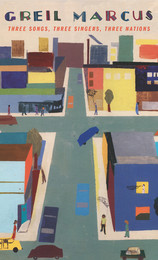 Three Songs, Three Singers, Three Nations
Greil Marcus
Harvard University Press, 2015 Greil Marcus has been one of the most distinctive voices in American music criticism for over forty years. His books, including Mystery Train and The Shape of Things to Come, traverse soundscapes of folk and blues, rock and punk, attuning readers to the surprising, often hidden affinities between the music and broader streams of American politics and culture.
Drawn from Marcus’s 2013 Massey Lectures at Harvard, his new work delves into three episodes in the history of American commonplace song: Bascom Lamar Lunsford’s 1928 “I Wish I Was a Mole in the Ground,” Geeshie Wiley’s 1930 “Last Kind Words Blues,” and Bob Dylan’s 1964 “Ballad of Hollis Brown.” How each of these songs manages to convey the uncanny sense that it was written by no one illuminates different aspects of the commonplace song tradition. Some songs truly did come together over time without an identifiable author. Others draw melodies and motifs from obscure sources but, in the hands of a particular artist, take a final, indelible shape. And, as in the case of Dylan’s “Hollis Brown,” there are songs that were written by a single author but that communicate as anonymous productions, as if they were folk songs passed down over many generations.
In three songs that seem to be written by no one, Marcus shows, we discover not only three different ways of talking about the United States but three different nations within its formal boundaries.
Three Sons: Franz Kafka and the Fiction of J. M. Coetzee, Philip Roth, and W. G. Sebald
Daniel L. Medin
Northwestern University Press, 2010 Franz Kafka was a self-conscious writer whose texts were highly if mysteriously autobiographical. Three giants of contemporary fiction—J. M. Coetzee, Philip Roth, and W. G. Sebald—have all acknowledged their debt to the work of Kafka, both in interviews and in their own academic essays and articles for a general readership about him. In this striking feat of literary scholarship, Daniel Medin finds that the use of Kafka by Coetzee, Roth, and Sebald is similarly self-reflexive and autobiographical. That writers from such divergent national and ethnic traditions can have such unique critical readings of Kafka, and that Kafka could exert such a powerful influence over their oeuvres, Medin contends, attests to the central place of Kafka in the contemporary literary imagination.
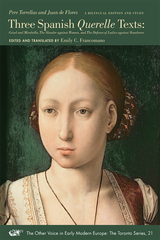 Three Spanish Querelle Texts: Grisel and Mirabella, The Slander against Women, and The Defense of Ladies against Slanderers
Pere Torrellas and Juan de Flores
Iter Press, 2013 This bilingual edition of the Three Spanish Querelle Texts is very well-conceived and will attract a wide audience among specialists and non-specialists alike. Francomano provides the first modern English translations of texts that enjoyed European-wide celebrity in the early sixteenth century. Her introduction is the best available summary of our knowledge about Torrellas’ two texts and Flores’ Grisel y Mirabella. Her translations are more readable than the Spanish texts, dividing Flores’ elaborate, rambling sentences into more comprehensible discourse. She often captures the tone of ambiguous or mock sincerity in the pleadings of both Flores’ and Torrellas’ characters. Francomano has a special sensitivity to the ludic quality of these discourses which helps readers appreciate their expression of “male anxiety” and “female agency” in the gender politics of their era.
 Three Spiritualist Novels
Elizabeth Stuart Phelps
University of Illinois Press, 2000 This volume brings together for the first time three novels that illustrate the distinguished American writer Elizabeth Stuart Phelps's enduring interest in the afterlife. The daughter of a Calvinist minister, Phelps could not reconcile herself to the idea of a heaven full of spirits who had cut their ties to those left behind on Earth. Rather, she became convinced of the viability of the Spiritualist view that a vital link to earthly life continues in the hereafter.
Articulating an alternative to conservative church doctrine, Phelps assured her readers--many of them women bereft of their loved ones by the Civil War--that Spiritualist ideas about the afterlife were not fundamentally at odds with Scripture. Like the protagonist of The Gates Ajar, these readers wanted to believe "something actual, something pleasant" about the world to come, not "glittering generalities" about a "dreadful Heaven" where their loved ones were too busy singing and worshiping to have any thought of those left behind.
All three of the novels collected here--The Gates Ajar (1868), Beyond the Gates (1883), and The Gates Between (1887)--describe heaven as a perfected version of earthly life and the afterlife as a chance to make up for opportunities squandered on Earth. A grieving sister finds consolation in the Spiritualist idea of a continued connection with her beloved brother; a dying woman finds her soulmate in the afterlife; an erring husband makes amends across the line between the living and the dead.
Tremendously popular in Phelps's lifetime, these novels offer a way of reconciling human beings to earthly loss and sorrow, assuring readers of an afterlife both restorative and compensatory. They also provide an intriguing look at a phenomenon that preoccupied nineteenth-century America and continues to fascinate us in the twenty-first century.
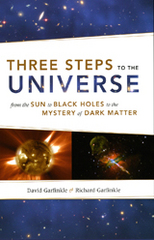 Three Steps to the Universe: From the Sun to Black Holes to the Mystery of Dark Matter
David Garfinkle and Richard Garfinkle
University of Chicago Press, 2008 If scientists can’t touch the Sun, how do they know what it’s made of? And if we can’t see black holes, how can we be confident they exist? Gravitational physicist David Garfinkle and his brother, science fiction writer Richard Garfinkle, tackle these questions and more in Three Steps to the Universe, a tour through some of the most complex phenomena in the cosmos and an accessible exploration of how scientists acquire knowledge about the universe through observation, indirect detection, and theory.
The authors begin by inviting readers to step away from the Earth and reconsider our Sun. What we can directly observe of this star is limited to its surface, but with the advent of telescopes and spectroscopy, scientists know more than ever about its physical characteristics, origins, and projected lifetime. From the Sun, the authors journey further out into space to explore black holes. The Garfinkle brothers explain that our understanding of these astronomical oddities began in theory, and growing mathematical and physical evidence has unexpectedly supported it. From black holes, the authors lead us further into the unknown, to the dark matter and energy that pervade our universe, where science teeters on the edge of theory and discovery. Returning from the depths of space, the final section of the book brings the reader back down to Earth for a final look at the practice of science, ending with a practical guide to discerning real science from pseudoscience among the cacophony of print and online scientific sources.
Three Steps to the Universe will reward anyone interested in learning more about the universe around us and shows how scientists uncover its mysteries.
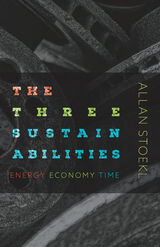 The Three Sustainabilities: Energy, Economy, Time
Allan Stoekl
University of Minnesota Press, 2021 Bringing the word sustainability back from the brink of cliché—to a substantive, truly sustainable future
Is sustainability a hopelessly vague word, with meager purpose aside from a feel-good appeal to the consumer? In The Three Sustainabilities, Allan Stoekl seeks to (re)valorize the word, for a simple reason: it is useful. Sustainability designates objects in time, their birth or genesis, their consistency, their survival, their demise. And it raises the question, as no other word does, of the role of humans in the survival of a world that is quickly disappearing—and perhaps in the genesis of another world. Stoekl considers a range of possibilities for the word, touching upon questions of object ontology, psychoanalysis, urban critique, technocracy, and religion. He argues that there are three varieties of sustainability, seen from philosophical, cultural, and economic perspectives. One involves the self-sustaining world “without us”; another, the world under our control, which can run the political spectrum from corporatism to Marxism to the Green New Deal; and a third that carries a social and communitarian charge, an energy of the “universe” affirmed through, among other things, meditation and gifting. Each of these carves out a different space in the relations between objects, humans, and their survival and degradation. Each is necessary, unavoidable, and intimately bound with, and infinitely distant from, the others. Along the way, Stoekl cites a wide range of authors, from philosophers to social thinkers, literary theorists to criminologists, anthropologists to novelists. This beautifully written, compelling, and nuanced book is a must for anyone interested in questions of ecology, energy, the environmental humanities, contemporary theories of the object, postmodern and posthuman aesthetics, or religion and the sacred in relation to community.
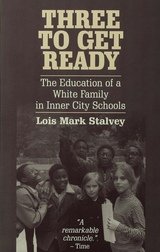 Three to Get Ready: The Education of a White Family in Inner City Schools
Lois M. Stalvey
University of Wisconsin Press, 1996 How do our schools take bright, active, ordinary children, who happen to be poor and black, and turn them into ill-educated and violent delinquents? Lois Stalvey’s book will show you how it is done. In 1962, the Stalveys, a middle-class white family, moved from Omaha to an integrated urban neighborhood in Philadelphia, where the three children enrolled in public schools. For twelve years, Lois Stalvey watched her children and their predominantly African American classmates as both a parent and a volunteer teacher. What she saw was shocking. When her own children misbehaved or had learning problems, they were granted patience and understanding. In contrast, African American children were treated, by both black and white teachers, as naughty, dangerous, obstinate, or stupid. Though more than twenty years have passed since the first publication of this book, the tragedy is that the message Lois Stalvey shares with her readers can only be more important today. “Why bother moving children’s bodies around to achieve integrated education,” she asks, “if, like the children in our school, they cannot escape teachers with segregating eyes?”
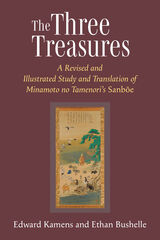 The Three Treasures: A Revised and Illustrated Study and Translation of Minamoto no Tamenori's Sanboe
Edward Kamens and Ethan Bushelle
University of Michigan Press, 2023 When the young Princess Sonshi became a Buddhist nun in the year 984, a scholar-official of the royal court was commissioned to create a guide to the Buddhist religion that would be accessible for her. He did so in the form of the illustrated works of fiction (monogatari) that appealed to women readers of her time and class. The text has survived in later manuscripts; the illustrations, if they ever existed, have not. This revised translation recreates Sonshi’s experience of receiving this multimedia presentation, with illustrations selected to help contemporary readers visualize its content and essays that provide context on the religious and cultural experience of the author. The Three Jewels is a unique document that opens a window onto the world of Buddhist religious experience—especially for women—in high classical Japan, the time of Sei Shōnagon’s Pillow Book and Murasaki Shikibu’s Tale of Genji.
Three Trios: Poems
J II
Northwestern University Press, 2007 Three Trios brings together, for the first time, translations of two ancient texts. The Apocryphal Book of Judith may be the more familiar one--the tale of a widow as warrior-savior. Less familiar may be the possibility that hidden within this narrative is another older sequence, a pagan one. The ritual that initiated a woman into the Dionysian also licensed her to leave her community. That ceremony, for all the running and blood-letting, helped the cultivated woman cultivate her individuation out of a morass of femininity. The "Mysteries" were widely practiced, and yet to preserve their secrecy, any documentary evidence was surely hidden, coded, or bowdlerized. It is possible that the Book of Judith was such a disguised book of common pagan prayer. Three Trios is composed out of this audacious possibility.
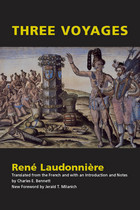 Three Voyages
Rene Laudonniere
University of Alabama Press, 2001 This translation of an eyewitness account by a major participant offers valuable information about all three attempts to establish a French colony on the south Atlantic coast of North America. Rene Laudonniere's account of the three attempts by France to colonize what is now the United States is uniquely valuable because
he played a major role in each of the ventures—first, in 1562, as second in command during the founding of the ill-fated Charlesport, then as commander for the establishment of Fort Caroline on Florida's St. Johns River in 1564, and finally as the one to welcome French reinforcements the following year. It was also Laudonniere's destiny to witness the tragic fall of Fort Caroline to Spanish claims one month later. Laudonniere wrote his chronicle, L'histoire Notable de la Floride, in 1565 following the fall of Fort Caroline as he recuperated in England. Much more than an account of his feelings and adventures, Laudonniere's history reveals him to be an exceedingly able and accurate geographer with a highly developed interest in anthropology. The first English translation was published by Richard Hakluyt in 1587. Charles E. Bennett's graceful and accurate rendering in modern English was first published in 1975 by the University Press of Florida. Besides the account, thoroughly annotated and with present-day names identifying sites visited by the Frenchman, this volume includes a valuable introductory essay. The appendices to the volume are four noteworthy documents, the last of which—a guide to plants of 16th-century Florida—will be of exceptional interest to naturalists, gardeners, and students of folklore. The account itself will fascinate professional historians and anthropologists as well as general readers interested in the exciting and often moving
events of early European settlement in the New World. Rene Laudonniere was a French adventurer and explorer of the 16th century who wrote L'histoire Notable de la Floride. Charles E. Bennett is a historian and former Florida congressman. He was coauthor of the Moss-Bennett legislation and was instrumental in the establishment of the Fort Caroline National Memorial and the Timucuan Ecological and Historical Preserve. Jerald T. Milanich is Curator in Archaeology at the Florida Museum of Natural History.
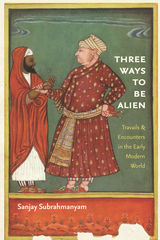 Three Ways to Be Alien: Travails and Encounters in the Early Modern World
Sanjay Subrahmanyam
Brandeis University Press, 2011 Sanjay Subrahmanyam’s Three Ways to Be Alien draws on the lives and writings of a trio of marginal and liminal figures cast adrift from their traditional moorings into an unknown world. The subjects include the aggrieved and lost Meale, a “Persian” prince of Bijapur (in central India, no less) held hostage by the Portuguese at Goa; English traveler and global schemer Anthony Sherley, whose writings reveal a surprisingly nimble understanding of realpolitik in the emerging world of the early seventeenth century; and Nicolò Manuzzi, an insightful Venetian chronicler of the Mughal Empire in the later seventeenth century who drifted between jobs with the Mughals and various foreign entrepôts, observing all but remaining the eternal outsider. In telling the fascinating story of floating identities in a changing world, Subrahmanyam also succeeds in injecting humanity into global history and proves that biography still plays an important role in contemporary historiography.
The Three Worlds: Culture and World Development
Peter Worsley
University of Chicago Press, 1984 A major, eclectic work of extraordinary scope and unprecedented vision, The Three Worlds is much more than a study of the contemporary Third World. It examines the constituents of development—cultural as well as political and economic—throughout the world from prehistory to the present.
Peter Worsley first considers existing theories of development, synthesizing the Marxist approach with that of social anthropologists and identifying culture—in the sense of a shared set of values—as the key element missing in more traditional approaches to the sociology of development. Worsley then examines successive forms of rural organization, develops a new definition of the urban poor, considers the relation of ethnicity and nationalism to social class and to each other, and, finally, discusses the nature of the three worlds implied in the term Third World.
 The Three Worlds of Social Democracy: A Global View
Edited by Ingo Schmidt
Pluto Press, 2016 The twentieth century saw social democracy emerge to become the dominant ideology of governance in Western Europe, and today its influence spreads far beyond the continent, reaching into the Global South. At the same time, however, social democracy appears to be on shakier ground than ever, its programs eroded by new geopolitical and sociopolitical realities.
The Three Worlds of Social Democracy presents a view of the current state of social democracy through close looks at the experiences of social democratic parties and governments in Western and Eastern Europe, Latin America, India, and South Africa. The contributors review the ideas and policies of the different parties and discuss efforts to deal with contemporary economic and social challenges. The result is a volume that will be of value to students of comparative politics even as it furthers the debate about the future of social democratic policies.
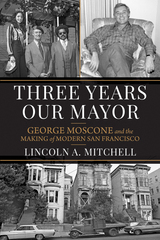 Three Years Our Mayor: George Moscone and the Making of Modern San Francisco
Lincoln A. Mitchell
University of Nevada Press, 2025 Those who recognize Mayor George Moscone’s name may think of him as the career politician who was assassinated along with Harvey Milk, but there was much more to this influential and fascinating man’s story. He was a trailblazing progressive and powerful state legislator who was instrumental in passing legislation on issues ranging from LGBT rights to funding for school lunches. Moscone’s 1975 campaign for mayor was historically significant because it was the first time a major race was won by a candidate who campaigned aggressively for expanding civil rights for both African Americans and LGBT people. He won his campaign for mayor chiefly because of huge support from those two constituencies.
Moscone was also a very colorful character who, in addition to being a successful politician, was a charming and charismatic bon vivant who was deeply embedded in the fabric and culture of San Francisco. He grew up the only son of a single mother in Cow Hollow when it was a working class, largely Italian American neighborhood, and he became the kind of politician who knew bartenders, playground attendants, small business owners, and neighborhood activists in every corner of the city. Moscone’s life and the history of San Francisco during the middle half of the twentieth century are deeply intertwined.
Through illustrating the life of Moscone, author Lincoln A. Mitchell explores how today’s San Francisco came into being. Moscone—through his work in the State Senate, victory in the very divisive 1975 mayor’s race, and brief tenure as mayor—was a key figure in the city’s evolution. The politics surrounding Moscone’s election as mayor, governance of the city, and tragic death are still relevant issues. Moscone was a groundbreaking politician whose life was cut short, but his influence on San Francisco can still be felt today.
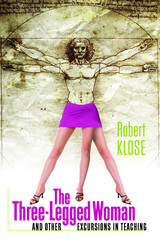 The Three-Legged Woman and Other Excursions in Teaching
Robert Klose
University Press of New England, 2013 Since 1986, Robert Klose has taught biology at a “small, impoverished, careworn” college in central Maine. Located on a former military base, the school became first the South Campus of the University of Maine, or SCUM, and later, Penobscot Valley Community College, then Bangor Community College, and most recently University College of Bangor. Despite its improved nomenclature, University College of Bangor remains an open-admissions environment at which “one never knows what’s going to come in over the transom.” Klose’s nontraditional students have included, in addition to single parents and veterans, the homeless, the abused, ex-cons, and even a murderer (who was otherwise “a very nice person”). Chronicling his experiences teaching these diverse students, Klose describes with equal doses of care and wry wit those who are profoundly unfit for college, their often inadequate command of the lingua franca, and the alacrity with which they seize upon the paranormal (the three-legged woman) while expressing skepticism about mainstream science. He reflects on the decline of reading for enjoyment and the folly of regarding email as a praiseworthy substitute for expository writing. He details what works in the classroom, identifies what has failed, and relates stories of the absurd, the sublime, and the unanticipated, such as one student’s outburst following a discussion of evolution: “For what you have taught today you shall be damned to everlasting fires of hell!” Tempering thoughtfulness with a light touch and plenty of humor, these essays prove that teaching, an “imperfect occupation,” remains a “special profession.”
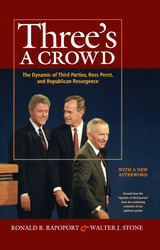 Three's a Crowd: The Dynamic of Third Parties, Ross Perot, and Republican Resurgence
Ronald B. Rapoport and Walter J. Stone
University of Michigan Press, 2011 "A significant contribution to our understanding of minor parties and party system change. The authors develop a new theory and provide strong empirical evidence in support of it. They show that the Perot's candidacy has had a strong and lasting impact on partisan competition in elections.
---Paul Herrnson, Director, Center for American Politics and Citizenship Professor, Department of Government and Politics, University of Maryland
"Powerfully persuasive in its exhaustive research, Three's a Crowd may surprise many by revealing the long- ignored but pivotal impact of Perot voters on every national election since 1992."
---Clay Mulford, Jones Day and General Counsel to the 1992 Perot Presidential Campaign and to the Reform Party.
"Rapaport and Stone have written an engaging and important book. They bring fresh perspectives, interesting data, and much good sense to this project. Three's a Crowd is fundamentally about political change, which will, in turn, change how scholars and pundits think of Ross Perot in particular, and third parties in general."
---John G. Geer, Professor of Political Science at Vanderbilt University and Editor of The Journal of Politics
"The definitive analysis of the Perot movement, its role in the 1994 GOP victory, and the emergence of an enduring governing majority."
---L. Sandy Maisel, Director, Goldfarb Center for Public Affairs, Colby College
Three's a Crowd begins with the simple insight that third parties are creatures of the American two-party system, and derive their support from the failures of the Democratic and Republican parties.
While third parties flash briefly in the gaps left by those failures, they nevertheless follow a familiar pattern: a sensation in one election, a disappointment in the next. Rapoport and Stone conclude that this steep arc results from one or both major parties successfully absorbing the third party's constituency. In the first election, the third party raises new issues and defines new constituencies; in the second, the major parties move in on the new territory. But in appropriating the third party's constituents, the major parties open themselves up to change. This is what the authors call the "dynamic of third parties."
The Perot campaign exemplified this effect in 1992 and 1996. Political observers of contemporary electoral politics missed the significance of Perot's independent campaign for the presidency in 1992. Rapoport and Stone, who had unfettered-and unparalleled-access to the Perot political machine, show how his run perfectly embodies the third-party dynamic. Yet until now no one has considered the aftermath of the Perot movement through that lens.
For anyone who seeks to understand the workings of our stubbornly two-party structure, this eagerly awaited and definitive analysis will shed new light on the role of third parties in the American political system.
Three-Toed Gull: Selected Poems
Jesper Svenbro
Northwestern University Press, 2003 Perhaps the most widely respected and read poet of his generation in Sweden, Jesper Svenbro makes his debut in the English-speaking world with this selection of poems drawn from his seven previous volumes and impeccably translated by John Matthias and Lars-Håkan Svensson. At times intellectual and erudite, at other times invoking intimacy and closely observed memories, Svenbro appears here at his most richly allusive, calling with consummate ease upon the myths of the Greeks, real and imaginary journeys in Lapland, the poetry of Sappho and T. S. Eliot, the plaints and joys of childhood, and the evocations of nature and of art. Whether in intricate formal innovations or flights of free verse, in the linguistic politics of "Stalin as Wolf" or the political linguistics of "A Critique of Pure Representation," Svenbro's work captures in its every nuance the transcendent possibilities of the poet's art.
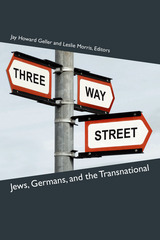 Three-Way Street: Jews, Germans, and the Transnational
Jay Howard Geller and Leslie Morris, Editors
University of Michigan Press, 2016 As German Jews emigrated in the nineteenth and early twentieth centuries and as exiles from Nazi Germany, they carried the traditions, culture, and particular prejudices of their home with them. At the same time, Germany—and Berlin in particular—attracted both secular and religious Jewish scholars from eastern Europe. They engaged in vital intellectual exchange with German Jewry, although their cultural and religious practices differed greatly, and they absorbed many cultural practices that they brought back to Warsaw or took with them to New York and Tel Aviv. After the Holocaust, German Jews and non-German Jews educated in Germany were forced to reevaluate their essential relationship with Germany and Germanness as well as their notions of Jewish life outside of Germany.
Among the first volumes to focus on German-Jewish transnationalism, this interdisciplinary collection spans the fields of history, literature, film, theater, architecture, philosophy, and theology as it examines the lives of significant emigrants. The individuals whose stories are reevaluated include German Jews Ernst Lubitsch, David Einhorn, and Gershom Scholem, the architect Fritz Nathan and filmmaker Helmar Lerski; and eastern European Jews David Bergelson, Der Nister, Jacob Katz, Joseph Soloveitchik, and Abraham Joshua Heschel—figures not normally associated with Germany. Three-Way Street addresses the gap in the scholarly literature as it opens up critical ways of approaching Jewish culture not only in Germany, but also in other locations, from the mid-nineteenth century to the present.
 Three-Way Street: Strategic Reciprocity in World Politics
Joshua S. Goldstein and John R. Freeman
University of Chicago Press, 1990 How can the world's most powerful nations cooperate despite their conflicting interests? In Three-Way Street, Joshua S. Goldstein and John R. Freeman analyze the complex intersection defined by relations among the United States, the Soviet Union, and China over the past forty years.
The authors demonstrate that three major schools of international relations theory—all game-theoretic, psychological, and quantitative-empirical approaches—have all advocated a strategy that employs cooperative initiatives and reciprocal responses in order to elicit cooperation from other countries. Critics have questioned whether such approaches can model how countries actually behave, but Goldstein and Freeman provide a wealth of detailed empirical evidence showing the existence and effectiveness of strategic reciprocity among the three countries between 1948 and 1989. Specifically, they establish that relations among the three countries have improved in recent decades through a "two steps forward, one step back" pattern. Their innovative and remarkably accessible synthesis of leading theoretical perspectives brilliantly illuminates the nature and workings of international cooperation.
Thresherphobe
Mark Halliday
University of Chicago Press, 2013 In his sixth collection, Mark Halliday continues to seek ways of using the smart playfulness of such poets as Frank O’Hara and Kenneth Koch to explore life’s emotional mysteries—both dire and hilarious—from the perpetual dissolving of our past to the perpetual frustration of our cravings for ego-triumph, for sublime connection with an erotically idealized Other, and for peace of spirit. Animated by belief in the possible truths to be reached in interpersonal speech, Halliday’s voice-driven poetry wants to find insight—or at least a stay against confusion—through personality without being trapped in personality. History will leave much of what we are on the threshing floor, Halliday notes, but in the meantime we do what we can; let posterity (if any!) say we rambled truly.
Forward Prizes for Poetry: Highly Commended for 'Classic Blunder' and 'Lois in the Sunny Tree'
Threshold
James Longenbach
University of Chicago Press, 1998 Threshold is an extraordinary first collection that explores the shifting spaces between differing states of human experience. James Longenbach's poems dwell on metaphoric gates, doorways, and end points past which our everyday world seems luminous and strange. Technically superb and quietly moving, Threshold resonates with a fresh poetic voice.
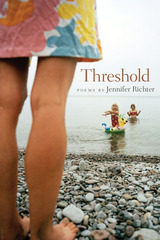 Threshold
Jennifer Richter
Southern Illinois University Press, 2010 Jennifer Richter presents a series of poems that explore the many facets of the term "threshold." Throughout the collection, the narrator experiences several acts of threshing, or separating—from birth and the small yet profound distances that part a mother and child, to the separation caused by illness and its toll on relationships. At the same time, she is progressively gathering, piecing together the remnants of her life, collecting her children into her arms, and welcoming a future without pain. Pain is often present in these poems, as the narrator frequently confronts her own threshold for enduring a ravaging illness. Her harrowing struggle through recovery is chronicled by a poem at the end of each section, tracing her powerful journey from deep suffering to a fragile yet steadfast sense of hope.
These gripping lyric and prose poems explore duality in its many forms: the private, contemplative world versus a world of action; the mirror sides of health and sickness; the warmth of a June sun and the deep, long nights of winter; mother and child; collecting and letting go. From the comfort of a morning bed at home to the desperate streets of Hanoi, Threshold is a searing portrait of healing, the courage it takes to bridge the gulfs that divide, and the wonder of the ties that bind. What Is My Body Without You? My son’s pajamas unsnapped on the floor: small husk of his body relaxing on its back, legs and sleeves still filled with his rush. This part of him hasn’t outgrown my arms and sometimes lets me lift him up our steep stairs, carry him to bed and pull his shade against the gray thin winter sky like milk my daughter wakes up wanting. In the last days of lifting her to my breast, I fill her less than the air already gone from my son’s flat shape. Twice like that I have lain back, the doctor opening me along the same clean seam. Each time I was watching: with a few tugs the child was out, naked and heading toward other hands, each child cut loose before I knew it.
Threshold
Joseph O. Legaspi
CavanKerry Press, 2017 Threshold enters a landscape of seemingly perpetual in-between, crossing from conventionality to queerness; exploring the fluidity of gender; and translating the hard hold of family. The collection meditates on passageways and what it means to arrive at, and pierce through, thresholds—between countries, past and future, and the threat and security of love.
Threshold Conscripts: Rhetoric and Composition Teaching Assistantships
William J. Macauley
University Press of Colorado, 2023 This richly textured edited collection explores the ways in which graduate teaching assistants are prepared to enter the field of rhetoric and composition. By viewing teaching and learning from the perspective of the TAs themselves, the chapters, personal narratives, and program profiles that make up this collection speak to the diversity and complexity found within and beyond university walls and deepen our understanding of how these preparation programs shape TA identities and practices. Through their stories and reports, the contributors to this volume provide valuable insights into the programs, realities, and experiences that shape their work in rhetoric and composition.
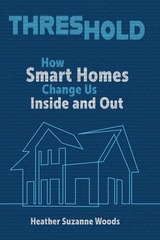 Threshold: How Smart Homes Change Us Inside and Out
Heather Suzanne Woods
University of Alabama Press, 2024 An urgent and cautionary examination of the totalizing effect of smart home technology on the lives of those who live in them—and those who don’t
Smart homes are here—domestic spaces bristling with networked technologies that appear to enhance work, entertainment, logistics, health, and security. But these technologies may also extract a cost in attention, money, and privacy. In Threshold, communication and technology expert Heather Suzanne Woods applies rhetorical theory to answer the urgent question of how swiftly proliferating smart homes alter those who inhabit them.
Building on extensive research into smart homes in the United States, Woods recounts how smart homes arose and predicts the trajectory of their future form. She pulls back the curtain on the technology, probes who is in control, and questions whether a home can be too smart. She reveals how smart homes incentivize ubiquitous computing as a daily practice, priming smart home occupants for permanent transactional existence largely controlled by corporate interests.
Woods suggests a dynamic cultural framework for understanding smart homes that takes into account sociotechnical variables such as gender, class, income, race, criminal justice, and more through which smart homes shape human life. Woods’s framework reveals how smart homes both reflect social norms about technology as well as whet consumer appetites for an ever more totalizing relationship with technology. She argues that this progression leads to “living in digitality,” a cultural state of constant use and reliance on technology.
Written for homeowners, policymakers, technology enthusiasts, and scholars, Threshold interweaves meticulously researched critical analysis with matter-of-fact graphics that map relationships between digital tools and social life. Readers will appreciate this bracing assessment of smart technologies that empowers smart home users to make informed decisions about their dwellings.
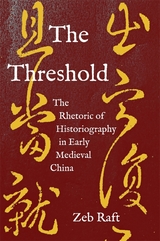 The Threshold: The Rhetoric of Historiography in Early Medieval China
Zeb Raft
Harvard University Press, 2023 What happens when historiography—the way historical events are committed to writing—shapes historical events as they occur? How do we read biography when it is truly “life-writing,” its subjects fully engaged with the historiographical rhetoric that would record their words and deeds?
The Threshold, a study of the culture of historiography in early medieval China, explores these questions through the lens of the History of Liu-Song, a dynastic history compiled in 488 and covering the first three-quarters of the fifth century. Rhetoric courses through early medieval historiography: from the way a historian framed history for readers to the political machinations contained within historical narratives, from the active use of rhetorical techniques to the passive effect that embedded discourses exercised on historian, historical actor, and reader alike. Tracing these varied strands of historical argumentation, Zeb Raft shows how history was constructed through rhetorical elements including the narration of officialdom, the anecdote, and, above all, the historical document. The portrait that emerges is of an epideictic historiography where praise was mixed with irony and achievement diluted with ambivalence—and where the most secure positions lay on the threshold of political power and historical interpretation.
 Thresholds of the Sacred: Architectural, Art Historical, Liturgical, and Theological Perspectives on Religious Screens, East and West
Sharon E. J. Gerstel
Harvard University Press, 2006 From the veils of the first-century Jewish temple, to the Orthodox iconostasis, to the tramezzi of Renaissance Italy, screens of various shapes, sizes, and materials have been used to separate spaces and order communities in religious buildings. Drawn from papers presented at a recent Dumbarton Oaks Byzantine Studies symposium, the contributors to this volume use a variety of perspectives to approach the history of religious screens and examine the thresholds that they mark. Focusing on the Middle Ages and Renaissance in the East and West, the volume includes discussions of screens in Egypt, Byzantium, the Gothic West and Italy. Some authors argue that screens, and particularly the one marking the threshold between the sanctuary/choir and nave, were conduits rather than barriers. Other authors emphasize the critical role of screens in dividing the laity and clergy, men and women, the pure and impure.
This volume provides new research on the history of religious screen and important insights into the many ways in which the sacred and profane are separated within ecclesiastical contexts.
Thrift & Generosity: Joy Of Giving
John M. Templeton
Templeton Press, 2004 In these difficult economic times, thrift may seem like a necessity, rather than a route to joy. But in this handbook, the reader learns about the virtue of thrift, and how, in combination with gratitude and generosity, it can lead to deep, lasting contentment. The book explores the qualities that distinguish thriftiness from merely being cheap; it looks at thrift and wisdom, thrift and gratitude, thrift and ethical standards, and thrift and hard work. With references from the Bible, literature, poetry, and philosophy, as well as examples from daily life, thrift is shown to be more than just understanding the bottom line. Indeed, thrift is part of a religious and cultural understanding of how we use our time, our talents, and our resources.
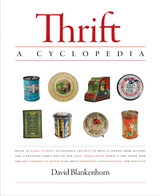 Thrift: A Cyclopedia
David Blankenhorn
Templeton Press, 2008 In today's consumer-driven society, extolling the virtues of thrift might seem like a quaint relic of a bygone era. Americans have embraced the ideas of easy credit, instant gratification, and spending as a tool to combat everything from recessions to the effects of natural disasters and terrorist attacks. In David Blankenhorn's new compendium, Thrift: A Cyclopedia, he reminds readers of a time when thrift was one of America's most cherished cultural values. Gathering hundreds of quotes, sayings, proverbs, and photographs of Blankenhorn's vast personal collection of thrift memorabilia, this handsome book is a treasure trove of wisdom from around the world and throughout the ages. Readers will find insights from such varied sources as the Bible, the Qur'an, William Shakespeare, Karl Marx, Oscar Wilde, J. C. Penney, and Warren Buffett. Entries are serious, inspiring, occasionally humorous, and they will go a great way toward expanding the narrow perception of thrift as simple penny pinching; replacing that myopic view with one of a broader thrift—one that, as William H. Kniffen puts it, "earns largely and spends wisely" and leads to a life of independence and comfort well into old age.
Educators and parents will find ample wisdom to pass on to the next generation about the value of hard work, saving for the future, and generosity. Historians will delight in the glimpses into the U.S. thrift movement of the 1920s. Those seeking encouragement and inspiration will find much material here for reflection on the ideals of good stewardship, diligence, and sound financial planning. As our society ails from wastefulness, growing economic inequality, indebtedness, and runaway consumerism, there could be no stronger cure than this powerful little word, "thrift", which finds its root meaning in the word "thrive."
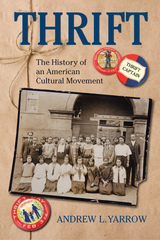 Thrift: The History of an American Cultural Movement
Andrew L. Yarrow
University of Massachusetts Press, 2014 In this lively and engaging book, Andrew L. Yarrow tells the story of a national movement that promoted an amalgam of values and practices ranging from self-control, money management, and efficiency to conservation, generosity, and planning for the future—all under the rubric of “thrift.” Emerging in tandem and in tension with the first flowerings of consumer society, the thrift movement flourished during the 1910s and 1920s and then lingered on the outskirts of American culture from the Depression to the prosperous mid-twentieth century. The movement brought together a diverse array of social actors with widely divergent agendas—the YMCA, the Boy and Girl Scouts, temperance crusaders, and others seeking to strengthen the moral fiber of urban young men and boys in particular, and to damp down the appeal of radicalism. It also attracted credit union and other progressive activists wanting to empower the working class economically, bankers desiring to broaden their customer base, conservationists and efficiency proponents denouncing “waste,” and government leaders, school teachers, and economists who believed that encouraging saving was in the economic interests of both individuals and the nation. A post–World War II culture that centered on spending and pleasure made the early-twentieth-century thrift messages seem outdated. Nonetheless, echoes of thrift can be found in currently popular ideas of “sustainability,” “stewardship,” and “simplicity” and in efforts to curtail public and private debt.
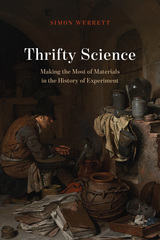 Thrifty Science: Making the Most of Materials in the History of Experiment
Simon Werrett
University of Chicago Press, 2018 If the twentieth century saw the rise of “Big Science,” then the seventeenth and eighteenth centuries were surely an age of thrift. As Simon Werrett’s new history shows, frugal early modern experimenters transformed their homes into laboratories as they recycled, repurposed, repaired, and reused their material possessions to learn about the natural world.
Thrifty Science explores this distinctive culture of experiment and demonstrates how the values of the household helped to shape an array of experimental inquiries, ranging from esoteric investigations of glowworms and sour beer to famous experiments such as Benjamin Franklin’s use of a kite to show lightning was electrical and Isaac Newton’s investigations of color using prisms. Tracing the diverse ways that men and women put their material possessions into the service of experiment, Werrett offers a history of practices of recycling and repurposing that are often assumed to be more recent in origin. This thriving domestic culture of inquiry was eclipsed by new forms of experimental culture in the nineteenth century, however, culminating in the resource-hungry science of the twentieth. Could thrifty science be making a comeback today, as scientists grapple with the need to make their research more environmentally sustainable?
Thrill-Bent
Jan Richman
Tupelo Press, 2013 Journalist and armchair thrill-seeker Jan Richman gets a freelance assignment to write about the nation’s old-fashioned wooden roller coasters. Jan takes off across the U.S. to report on a fanatical sub-culture. This picaresque research junket dovetails with the wedding of her Tourette’s-riddled father, whom she hasn’t seen in years. Brazen and stingingly funny, Thrill-Bent zooms from Coney Island to New Orleans to the San Fernando Valley as our heroine learns how to be truly impulsive in a buttoned-down world.
 Thrillers, Chillers, and Killers: Radio and Film Noir
Frank Krutnik
Rutgers University Press, 2025 Film noir is one of the most exciting and most debated products of studio-era Hollywood, but did you know that American radio broadcast many programs in the noir vein through the 1940s and 1950s? These included adaptations of such well-known films as The Maltese Falcon, Murder, My Sweet, and Double Indemnity, detective series devoted to the adventures of private eyes Philip Marlowe and Sam Spade, and the spine-tingling anthology programs Lights Out and Suspense. Thrillers, Chillers, and Killers is the first book to explore in detail noir storytelling on the two media, arguing that radio’s noir dramas played an important role as a counterpart to, influence on, or a spin-off from the noir films. Besides shedding new light on long-neglected radio dramas, and a medium that was cinema’s major rival, this scrupulously researched yet accessible study also uses these programs to challenge conventional understandings of the much-debated topic of noir.
A Thrilling Narrative: The Memoir of a Southern Unionist
Dennis E. Haynes
University of Arkansas Press, 2006 This Civil War memoir of Capt. Dennis E. Haynes is both unique and rare. Not only did few southern unionists write of their experiences after the war, Haynes’s is the only publication by a Louisiana unionist. Furthermore, it is the only account by a member of the First Louisiana Battalion Cavalry Scouts, a unit that existed for less than three months and saw its only real action during the Red River Campaign of 1864. Haynes’s memoir is a historic collection of his wartime experiences as a unionist in the Confederate South. Among his writings, Haynes describes how he opposed the secession of Texas and thus became a hunted man. He also tells of his harrowing odyssey to reach Union troops in Louisiana. Every step of the way, Haynes provides details, sometimes graphic, of the harassment and cruelty he and many others like him suffered at the hands of his Confederate neighbors.
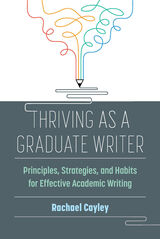 Thriving as a Graduate Writer: Principles, Strategies, and Habits for Effective Academic Writing
Rachael Cayley
University of Michigan Press, 2023 Thriving as a Graduate Writer offers a comprehensive guide to the multifaceted challenges of writing in graduate school. It shows readers how to think about academic writing, how to manage an academic text, and how to establish an effective writing practice. Graduate students from all disciplines will find concrete strategies and motivation for the enterprise of academic writing. Intended for both multilingual writers and those for whom English is a first language, Thriving as a Graduate Writer offers essential writing support in quick, easily digestible chunks. Readers of Thriving as a Graduate Writer will: - Learn how to establish an effective writing practice
- Discover how to position themselves as competent and engaged writers
- Learn how to structure their writing, craft effective sentences, and create movement with a text
- Develop processes for draft revisions
- Create individual writing strategies that will last throughout their careers
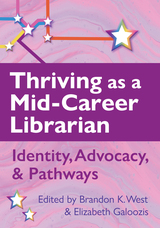 Thriving as a Mid-Career Librarian: Identity, Advocacy, and Pathways
Brandon West
Association of College & Research Libraries, 2023 Mid-career librarianship looks different for everyone. Maybe you’ve worked in libraries for ten years, or you’re halfway to retirement. Maybe you’ve reached the highest level of a hierarchy you care to reach. Most of the literature about mid-career librarianship tends to focus on advancing to leadership or administration, but many of us are more concerned with how to continue to grow professionally without moving upward; how to make decisions about staying in an institution (or the profession); sustaining yourself amid burnout, constant change, wage compression, or even boredom; and navigating cultures of white supremacy, patriarchy, and hierarchy. In four sections, Thriving as a Mid-Career Librarian collects the experiences of mid-career librarians as they grapple with these questions and the roles that marginalized perspectives, intersectionality, and privilege have played in their careers: - Section 1: Staying Engaged in Your Career
- Section 2: The Role of Identity in Shaping Mid-career Librarianship
- Section 3: Being Your Own Advocate
- Section 4: To Lead or Not to Lead?
Chapters explore maintaining engagement and avoiding burnout; informal mentorships; the doctorate; union stewardship; addressing incivility; post-tenure fatigue; balancing ambition, personal fulfillment, and life; and much more. It can feel like everything gets harder, more political, and further under-resourced with each passing year. Thriving as a Mid-Career Librarian offers strategies of community, support, and advocacy that can help make it possible for us to thrive and help others to thrive. At mid-career, we may not have the same bright-eyed enthusiasm we possessed as new information professionals, but we have other things: the contributions we make to our communities and the wealth of experience we have built up since those days.
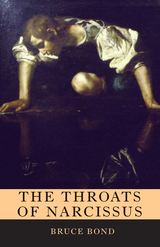 The Throats of Narcissus
Bruce Bond
University of Arkansas Press, 2001 In Bruce Bond's fourth full-length book, The Throats of Narcissus, the myth of Narcissus finds its transfiguring mirror in poems of a contemporary world, a world rendered precarious by literal and metaphysical famine, by the blood of fathers and distant strangers, the charred relics of foreign wars and nearer fires as well—a world wrestling with problems of its own self-regard and the consequent spiritual longing for personal communion and creative transformation. Thus the myth of Narcissus resonates not only as a story of self-absorption and demise, but also of life-affirming metamorphosis. As a result, we see not only poems concerning childhood and the dawn of guilt, desire, and self-awareness, but also poems featuring jazz figures of the fifties and sixties, heroes of creative discipline and play who dealt musically with their own narcissistic wounds and addictions, leaving a generous legacy of pleasures, however rebellious and private their roots.
 Throne and Mandarins: China’s Search for a Policy during the Sino-French Controversy, 1880–1885
Lloyd Eastman
Harvard University Press This study of the policy-making process in China during the Sino–French controversy of 1880–1885 adds a new dimension to our understanding of China’s response to the West in the nineteenth century. The implicit threat presented by French efforts to extend her control into northern Vietnam was the catalyst in Chinese policy decisions, and Lloyd Eastman traces the dramatic process by which the problem was eventually resolved. Analyzing the complicated balance of internal political forces in the Ch’ing dynasty in the late nineteenth century, he makes the first thorough study of the factors which shaped Chinese foreign policy in this period.
Three major power groups affected the decision-making process: the throne, high administrative officials, and lesser officials whose role was largely ideological. Eastman shows the considerable extent to which the throne’s power was limited by the interests of the officials (or mandarins); discusses the role of ch’ing-i, or literati opinion; and emphasizes the importance of the conservative, low-ranking officials who stood overwhelmingly in opposition to the few proponents of reform and modernization and strongly influenced the course of Chinese policy. Discussing the diplomatic objectives involved—preservation of hegemony in Vietnam, reluctance to fight a war that might expose its military weakness, desire to save face—as manifestations of underlying cultural assumptions and values, Eastman offers a fresh perspective on the formulation of policy during the Ch’ing government’s confrontation with the Western powers.
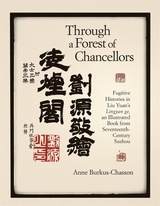 Through a Forest of Chancellors: Fugitive Histories in Liu Yuan’s Lingyan ge, an Illustrated Book from Seventeenth-Century Suzhou
Anne Burkus-Chasson
Harvard University Press, 2010 Liu Yuan’s Lingyan ge, a woodblock-printed book from 1669, re-creates a portrait gallery that memorialized 24 vassals of the early Tang court. Liu accompanied each figure, presented under the guise of a bandit, with a couplet; the poems, written in various scripts, are surrounded by marginal images that allude to a contemporary novel. Religious icons supplement the portrait gallery. Liu’s re-creation is fraught with questions. This study examines the dialogues created among the texts and images in Lingyan ge from multiple perspectives. Analysis of the book’s materialities demonstrates how Lingyan ge embodies, rather than reflects, the historical moment in which it was made.
Liu unveiled and even dramatized the interface between manuscript and printed book in Lingyan ge. Authority over the book’s production is negotiated, asserted, overturned, and reinstated. Use of pictures to construct a historical argument intensifies this struggle. Anne Burkus-Chasson argues that despite a general epistemological shift toward visual forms of knowledge in the seventeenth century, looking and reading were still seen as being in conflict. This conflict plays out among the leaves of Liu Yuan’s book.
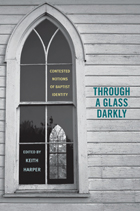 Through a Glass Darkly: Contested Notions of Baptist Identity
Keith Harper
University of Alabama Press, 2012 Normal0falsefalsefalseMicrosoftInternetExplorer4 Through a Glass Darkly is a collection of essays by scholars who argue that Baptists are frequently misrepresented, by outsiders as well as insiders, as members of an unchanging monolithic sect. In contemporary discussions of religious denominations, it is often fashionable and easy to make bold claims regarding the history, beliefs, and practices of certain groups. Select versions of Baptist history have been used to vindicate incomplete or inaccurate assertions, attitudes, and features of Baptist life and thought. Historical figures quickly become saints, and overarching value systems can minimize the unsavory realities that would contribute to a truer interpretation of Baptist life. The essays in this volume use the term Baptist in the broadest sense to refer to those Christians who identify themselves as Baptists and who baptize by immersion as a non-sacramental church rite. Over the past four hundred years, Baptists have grown from a persecuted minority to a significant portion of America’s religious population. They have produced their fair share of controversies and colorful characters that have, in turn, contributed to a multifaceted history. But what does it mean to be a “real Baptist”? Some look to historical figures as heroic exemplars of Baptist core values. Others consider cultural, social, or political issues to be guideposts for Baptist identity. Through a Glass Darkly dives deeper into history for answers, revealing a more complete version of the expansive and nuanced history of one of America’s most influential religious groups. Normal0falsefalsefalseMicrosoftInternetExplorer4 Contributors: James P. Byrd / John G. Crowley / Edward R. Crowther / Christopher H. Evans / Elizabeth H. Flowers / Curtis W. Freeman / Barry G. Hankins / Paul Harvey / Bill J. Leonard / James A. Patterson / Jewel L. Spangler / Alan Scot Willis
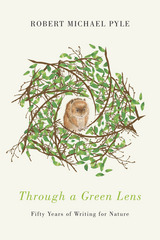 Through a Green Lens: Fifty Years of Writing for Nature
Robert Michael Pyle
Oregon State University Press, 2016 By an early age, Bob Pyle discovered that he had a greater facility with words than with numbers. In school, he found he could get good grades and win essay contests by relying on those words alone. But he wasn't really moved to write until a powerful experience in the summer he graduated brought his pen together with his passion for the natural world, and his first heartfelt essay came out as a revelation.
Thus began a life path devoted to natural history, nature conservation, and the language, and how they all meet in the literature of the land. Working in a succession of far-flung jobs in biological conservation, teaching, and field research, Pyle eventually threw in a regular paycheck in favor of a freelance existence devoted to his mutual passions for nature study and writing.
All along, he wrote, and wrote: to date, twenty books and hundreds of essays, stories, papers, and poems. But it is the occasional prose--the deeply personal essays that explored and indulged his immediate fascinations--that make up this selection of never-before-collected testimonies. Beginning with that 1965 cri de coeur written on mountain motel stationery, Through a Green Lens ranges across broad territory of topic, vehicle, geography, populace, and politics, concluding with powerful forewords for two 2015 books, Earth and Eros and Nerves and Numbers. Pyle's half-century long view, acute and uncommonly attuned to the physical world, gives readers a remarkable window on the natural setting of our life and times.
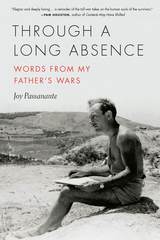 Through a Long Absence: Words from My Father's Wars
Joy Passanante
Ohio State University Press, 2017 A 2017 Foreword INDIES Book of the Year Silver Winner for Biography
Against the backdrop of World War II, Joy Passanante’s touching new book, Through a Long Absence: Words from My Father’s Wars, is the saga of a wartime medical unit, a passionate long-distance love, the making of a surgeon, and two first-generation American families. Told through her father’s eyes—drawing on hundreds of his letters to his beloved wife, his four-volume wartime diary, and his paintings—Passanante masterfully recreates his wartime journey and physically retraces his steps more than sixty years later in an attempt to understand a time in her parents’ lives that they’d spoken about very little.
More than just a World War II story, Through a Long Absence delves into one man’s past to explore his personal wars: a stint as a child bootlegger, a marriage between newlyweds separated by continents and strained by years apart, and his struggle late in life with his own mind. The narrative propels readers to surprising places—from a freight train through North Africa to an underground St. Louis distillery during Prohibition, from a young couple’s forbidden courtship to the chaos of surgical tents under fire in Normandy, from an underground trove of priceless artwork hidden by the Nazis to Jewish New Year services in Paris a week after its liberation. Through a Long Absence is a love story, an honest look into one man’s life, and a daughter’s moving quest to rediscover her father years later through his own words.
Through a Naturalist's Eyes: Exploring the Nature of New England
Michael J. Caduto
University Press of New England, 2016 For native and visitor alike, the New England landscape has a rich allure. This grand sweep of land is a living tapestry woven of interconnected bioregions and natural communities whose compositions of plants and animals have evolved over time. In more than fifty essays, Michael J. Caduto brings readers into the complex stories to be found in nature. Drawing on first-hand experiences and reflections on the relationship between the natural world and humans, Caduto explores some of the plants, animals, natural places, and environmental issues of New England—from dragonflies, cuckoos, and chipmunks to circumpolar constellations and climate change. Stunning illustrations by Adelaide Murphy Tyrol illuminate these elegant and humorous essays.
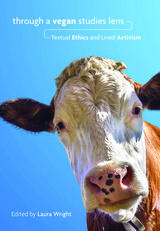 Through a Vegan Studies Lens: Textual Ethics and Lived Activism
Laura Wright
University of Nevada Press, 2019 Interest in the vegan studies field continues to grow as veganism has become increasingly visible via celebrity endorsements and universally acknowledged health benefits, and veganism and vegan characters are increasingly present in works of art and literature. Through a Vegan Studies Lens broadens the scope of vegan studies by engaging in the mainstream discourse found in a wide variety of contemporary works of literature, popular cultural representations, advertising, and news media.
Veganism is a practice that allows for environmentally responsible consumer choices that are viewed, particularly in the West, as oppositional to an economy that is largely dependent upon big agriculture. This groundbreaking collection exposes this disruption, critiques it, and offers a new roadmap for navigating and reimaging popular culture representations on veganism. These essays engage a wide variety of political, historical, and cultural issues, including contemporary political and social circumstances, emergent veganism in Eastern Europe, climate change, and the Syrian refugee crisis, among other topics.
Through a Vegan Studies Lens significantly furthers the conversation of what a vegan studies perspective can be and illustrates why it should be an integral part of cultural studies and critical theory. Vegan studies is inclusive, refusing to ignore the displacement, abuse, and mistreatment of nonhuman animals. It also looks to ignite conversations about cultural oppression.
Through Amazonian Eyes: The Human Ecology of Amazonian Populations
Emilio F. Moran
University of Iowa Press, 1993 In this well-written, comprehensive, reasonable yet passionate volume, Emilio Moran introduces us to the range of human and ecological diversity in the Amazon Basin. By describing the complex heterogeneity on the Amazon's ecological mosaic and its indigenous populations' conscious adaptations to this diversity, he leads us to realize that there are strategies of resource use which do not destroy the structure and function of ecosystems. Finally, and most important, he examines ways in which we might benefit from the study of human ecology to design and implement a balance between conservation and use.
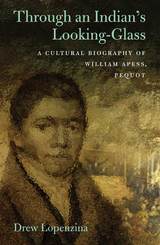 Through an Indian's Looking-Glass: A Cultural Biography of William Apess, Pequot
Drew Lopenzina
University of Massachusetts Press, 2017 The life of William Apess (1798–1839), a Pequot Indian, Methodist preacher, and widely celebrated writer, provides a lens through which to comprehend the complex dynamics of indigenous survival and resistance in the era of America's early nationhood. Apess's life intersects with multiple aspects of indigenous identity and existence in this period, including indentured servitude, slavery, service in the armed forces, syncretic engagements with Christian spirituality, and Native struggles for political and cultural autonomy. Even more, Apess offers a powerful and provocative voice for the persistence of Native presence in a time and place that was long supposed to have settled its “Indian question” in favor of extinction.
Through meticulous archival research, close readings of Apess's key works, and informed and imaginative speculation about his largely enigmatic life, Drew Lopenzina provides a vivid portrait of this singular Native American figure. This new biography will sit alongside Apess's own writing as vital reading for those interested in early America and indigeneity.
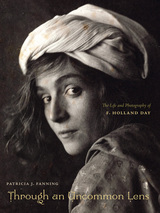 Through an Uncommon Lens: The Life and Photography of F. Holland Day
Patricia J. Fanning
University of Massachusetts Press, 2008 Based in the Boston area, F. Holland Day (1864–1933) was a central figure in artistic circles on both sides of the Atlantic. Publisher of Oscar Wilde and Stephen Crane, mentor to a young Kahlil Gibran, adviser and friend to photographers Alvin Langdon Coburn and Edward Steichen, Day lived a life devoted to art and beauty. At the turn of the twentieth century, his reputation rivaled that of Alfred Stieglitz. A pioneer in the field of pictorial photography, Day was also an influential book publisher in the Arts and Crafts tradition. He cofounded the publishing company of Copeland and Day, which issued more than a hundred titles between 1893 and 1899. In addition, he embraced a unique sense of social responsibility and a commitment to historic preservation. Colorful and sometimes eccentric, Day was best known for his stunningly original, brilliantly executed, and sometimes controversial photographic images of blacks, children, and allegorical subjects. His determination to promote photography as a fine art led him to create photographic representations of the crucifixion of Christ, studies for which he was his own model. Although he continued to mentor young artists until his death, ill health caused Day to spend the last fourteen years of his life inside his home in Norwood, Massachusetts. By the time he died in 1933, he was virtually unknown, but in recent years there has been a resurgence of interest in his art. Responding to this renewed interest, Patricia Fanning has written an impressive biography—one that draws on previously unavailable archival material and is attuned to the historical and cultural contexts in which Day lived and worked. The book is illustrated with more than a hundred photographs, including 32 duotone illustrations of the artist's work.
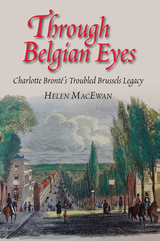 Through Belgian Eyes: Charlotte Bronte's Troubled Brussels Legacy
Helen Macewan
Sussex Academic Press, 2022 Charlotte Bronte's years in Belgium (1842-43) had a huge influence both on her life and her work. It was in Brussels that she not only honed her writing skills but fell in love and lived through the experiences that inspired two of her four novels: her first, The Professor, and her last and in many ways most interesting, Villette. Her feelings about Belgium are known from her novels and letters - her love for her tutor Heger, her uncomplimentary remarks about Belgians, the powerful effect on her imagination of living abroad. But what about Belgian views of Charlotte Bronte? What has her legacy been in Brussels? How have Belgian commentators responded to her portrayal of their capital city and their society? 'Through Belgian Eyes' explores a wide range of responses from across the Channel, from the hostile to the enthusiastic. In the process, it examines what The Professor and Villette tell Belgian readers about their capital in the 1840s and provides a wealth of detail on the Brussels background to the two novels. Unlike Paris and London, Brussels has inspired few outstanding works of literature. That makes Villette, considered by many to be Charlotte Bronte's masterpiece, of particular interest as a portrait of the Belgian capital a decade after the country gained independence in 1830, and just before modernisation and expansion transformed the city out of all recognition from the 'villette' (small town) that Charlotte knew. Her view of Brussels is contrasted with those of other foreign visitors and of the Belgians themselves. The story of Charlotte Bronte's Brussels legacy provides a unique perspective on her personality and writing. [Subject: Bronte Studies, Literary Studies, Biography, History]
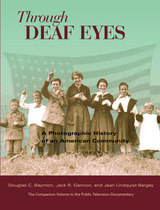 Through Deaf Eyes: A Photographic History of an American Community
Douglas Baynton
Gallaudet University Press, 2007 In 2001, the Smithsonian Institution presented the landmark photographic exhibition History Through Deaf Eyes, representing nearly 200 years of United States deaf history. Drawing heavily on the extensive archives at Gallaudet University, the curators created an exhibition that drew more than 400,000 people viewed at the Smithsonian and in 12 cities during a five-year national tour. Its popularity prompted the production of a documentary film for national broadcast on the Public Broadcasting System. Now, the photographs, quotes, and stories from this remarkable exhibit and documentary have been assembled in a book of stunning beauty and poignant images, Through Deaf Eyes: A Photographic History of an American Community.
Featuring more than 200 full-color photographs, Through Deaf Eyes depicts the story of Deaf America and also affords readers the opportunity to learn about the nation’s broader history. The values and judgments of society have had an impact on the education, employment, and family life of deaf people, while historical eras often can be illuminated by examination through a Deaf lens. Photographs reveal the character of Deaf people in school settings, the workplace, during wartime, and using their cultural signature, American Sign Language. For both deaf and hearing readers, the Deaf community portrayed in Through Deaf Eyes offers a unique and fascinating perspective on the value of human difference.
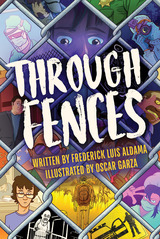 Through Fences
Written by Frederick Luis Aldama and Illustrated by Oscar Garza
Ohio State University Press, 2024 Winner, 2025 TACHE Outstanding Book Award in Fiction Honor-winner, 2025 Texas Institute of Letters Jean Flynn Award for Best Young Adult Book Longlisted, REFORMA National Book Award 2024Through Fences follows the ups and downs of Latino kids and young adults in the US–Mexico borderlands: San Ysidro, Calexico, McAllen, and back and forth across the border. A young girl's journey north goes wrong, and now she is in a forbidding new place, away from her parents and brother, where she doesn't understand what the adults in green are saying even as she tries to obey their rules. Rocky, one of the few white kids in town, stands by and watches as Miguel is jumped by two of his friends. Maggie and her parents are separated at the border in a tragic accident. Alberto's son doesn't understand his Mexican father's hatred for illegals or his work as a border patrol agent. Alicia is a TikTok influencer who doesn't want to grow up to be a hospital cleaning lady like her mother, but COVID complicates things. Whatever their challenges, the kids, teens, tweens, and adults in these pages are just trying to survive their everyday lives. Vibrantly illustrated by Oscar Garza, each of these short stories brings a different perspective on the perils of living on the border while brown.
Through French Windows: An Introduction to France in the Nineties
James Corbett
University of Michigan Press, 1994 Through French Windows is a journey into contemporary French culture and society. By describing the country's education, religion, politics, finances, technology and telecommunications, and social and ethical issues, Corbett draws a portrait of present-day France.The author provides background information necessary for understanding the changes that continue to evolve. Corbett conscientiously avoids the traditional and simplistic means of portraying France that emphasizes the cultural heritage of the country. Instead he provides an insider's view of France, separating that mythic image from the current reality. Further, he presents an accurate portrayal of the diversity of France by moving beyond the typical dichotomy between Paris and the rest of the country or the oversimplification of dividing the country into north and south.
 Through Japanese Eyes: Thirty Years of Studying Aging in America
Yohko Tsuji
Rutgers University Press, 2021 In Through Japanese Eyes, based on her thirty-year research at a senior center in upstate New York, anthropologist Yohko Tsuji describes old age in America from a cross-cultural perspective. Comparing aging in America and in her native Japan, she discovers that notable differences in the panhuman experience of aging are rooted in cultural differences between these two countries, and that Americans have strongly negative attitudes toward aging because it represents the antithesis of cherished American values, especially independence. Tsuji reveals that American culture, despite its seeming lack of guidance for those aging, plays a pivotal role in elders’ lives, simultaneously assisting and constraining them. Furthermore, the author’s lengthy period of research illustrates major changes in her interlocutors’ lives, incorporating their declines and death, and significant shifts in the culture of aging in American society as Tsuji herself gets to know American culture and grows into senescence herself.
Through Japanese Eyes offers an ethnography of aging in America from a cross-cultural perspective based on a lengthy period of research. It illustrates how older Americans cope with the gap between the ideal (e.g., independence) and the real (e.g., needing assistance) of growing older, and the changes the author observed over thirty years of research.
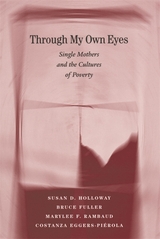 Through My Own Eyes: Single Mothers and the Cultures of Poverty
Susan Holloway, Bruce Fuller, Marylee F. Rambaud, and Costanza Eggers-Piérola
Harvard University Press, 2001 Shirl is a single mother who urges her son's baby-sitter to swat him when he misbehaves. Helena went back to work to get off welfare, then quit to be with her small daughter. Kathy was making good money but got into cocaine and had to give up her two-year-old son during her rehabilitation. Pundits, politicians, and social critics have plenty to say about such women and their behavior. But in this book, for the first time, we hear what these women have to say for themselves. An eye-opening--and heart-rending--account from the front lines of poverty, Through My Own Eyes offers a firsthand look at how single mothers with the slimmest of resources manage from day to day. We witness their struggles to balance work and motherhood and watch as they negotiate a bewildering maze of child-care and social agencies.
For three years the authors followed the lives of fourteen women from poor Boston neighborhoods, all of whom had young children and had been receiving welfare intermittently. We learn how these women keep their families on firm footing and try--frequently in vain--to gain ground. We hear how they find child-care and what they expect from it, as well as what the childcare providers have to say about serving low-income families. Holloway and Fuller view these lives in the context of family policy issues touching on the disintegration of inner cities, welfare reform, early childhood and "pro-choice" poverty programs.
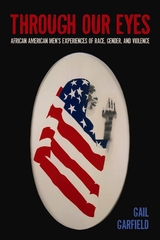 Through Our Eyes: African American Men's Experiences of Race, Gender, and Violence
Garfield, Gail
Rutgers University Press, 2010 How have African American men interpreted and what meaning have they given to social conditions that position them as the primary perpetrators of violence? How has this shaped the ways they see themselves and engaged the world? Through Our Eyes provides a view of black men’s experiences that challenges scholars, policy makers, practitioners, advocates, and students to grapple with the reality of race, gender, and violence in America.This multi-level analysis explores the chronological life histories of eight black men from the aftermath of World War II through the Cold War and into today. Gail Garfield identifies the locations, impact, and implications of the physical, personal, and social violence that enters the lives of African American men. She addresses questions critical to understanding how race, gender, and violence are insinuated into black men’s everyday lives and how experiences are constructed, reconstructed, and interpreted. By appreciating the significance of how African American men live through what it means to be black and male in America, this book envisions the complicated dynamics that devalue their lives, those of their family, and society.
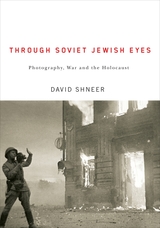 Through Soviet Jewish Eyes: Photography, War, and the Holocaust
Shneer, David
Rutgers University Press, 2012 Most view the relationship of Jews to the Soviet Union through the lens of repression and silence. Focusing on an elite group of two dozen Soviet-Jewish photographers, including Arkady Shaykhet, Alexander Grinberg, Mark Markov-Grinberg, Evgenii Khaldei, Dmitrii Baltermants, and Max Alpert, Through Soviet Jewish Eyes presents a different picture. These artists participated in a social project they believed in and with which they were emotionally and intellectually invested-they were charged by the Stalinist state to tell the visual story of the unprecedented horror we now call the Holocaust.
These wartime photographers were the first liberators to bear witness with cameras to Nazi atrocities, three years before Americans arrived at Buchenwald and Dachau. In this passionate work, David Shneer tells their stories and highlights their work through their very own images-he has amassed never-before-published photographs from families, collectors, and private archives.
Through Soviet Jewish Eyes helps us understand why so many Jews flocked to Soviet photography; what their lives and work looked like during the rise of Stalinism, during and then after the war; and why Jews were the ones charged with documenting the Soviet experiment and then its near destruction at the hands of the Nazis.
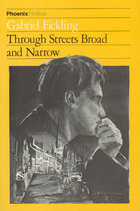 Through Streets Broad and Narrow
Gabriel Fielding
University of Chicago Press, 1986 In this sequel to the acclaimed In the Time of Greenbloom, John Blaydon "runs head on into the paradox of Ireland, attempts to solve it single-handed and gets his heart and most of his head broken in the process. The manner of his undoing is told in a series of brilliant pictures, evocative, authentic, macabre, or hilariously funny. . . . Mr. Fielding has written an original novel of vitality, wit, and compassionate insight."—Isabelle Mallet, New York Times Book Review
"A powerful and beautifully written novel, "Streets" can either stand by itself or solidly in company with In the Time of Greenbloom. . . . [Fielding's] touch is as sure and controlled as his invention is unlimited, and the resultant work seems various and beautiful and new. The major objection to the book is not its ending, but that it ends. It is too good to give up, too vital and dynamic to leave."—Margaret Marble, Los Angeles Times
"A prismatic study of a finely gifted man in the elaborate tangles of his growth in a complex and wonderfully drawn environment."—Newsweek
"Fielding writes a torrential prose, and his imagist phrases, fabulous incidents, antic characters and peripheral violence whip the story forward."—Time
 Through Survivors' Eyes: From the Sixties to the Greensboro Massacre
Sally Avery Bermanzohn
Vanderbilt University Press, 2003 On the morning of November 3, 1979, a group of black and white demonstrators were preparing to march against the Ku Klux Klan through the streets of Greensboro, North Carolina, when a caravan of Klansmen and Nazis opened fire on them. Eighty-eight seconds later, five demonstrators lay dead and ten others were wounded. Four TV stations recorded their deaths by Klan gunfire. Yet, after two criminal trials, not a single gunman spent a day in prison. Despite this outrage, the survivors won an unprecedented civil-court victory in 1985 when a North Carolina jury held the Greensboro police jointly liable with the KKK for wrongful death.
In passionate first-person accounts, Through Survivors' Eyes tells the story of six remarkable people who set out to change the world. The survivors came of age as the "protest generation," joining the social movements of the 1960s and 1970s. They marched for civil rights, against war, for textile and healthcare workers, and for black power and women's liberation. As the mass mobilizations waned in the mid-1970s, they searched for a way to continue their activism, studied Marxism, and became communists.
Nelson Johnson, who grew up on a farm in eastern North Carolina in a family proud of its African American heritage, settled in Greensboro in the 1960s and became a leader of the Black Liberation Movement and a decade later the founder of the Faith Community Church. Willena Cannon, the daughter of black sharecroppers, witnessed a KKK murder as a child and was spurred to a life of activism. Her son, Kwame Cannon, was only ten when he saw the Greensboro killings. Marty Nathan, who grew up the daughter of a Midwestern union organizer and came to the South to attend medical school, lost her husband to the Klan/Nazi gunfire. Paul Bermanzohn, the son of Jewish Holocaust survivors, was permanently injured during the shootings. Sally Avery Bermanzohn, a child of the New York suburbs who came south to join the Civil Rights Movement, watched in horror as her friends were killed and her husband was wounded.
Through Survivors' Eyes is the story of people who abandoned conventional lives to become civil rights activists and then revolutionaries. It is about blacks and whites who united against Klan/Nazi terror, and then had to overcome unbearable hardship, and persist in seeking justice. It is also a story of one divided southern community, from the protests of black college students of the late 1960s to the convening this January of a Truth and Community Reconciliation Project (on the South African model) intended to reassess the Massacre.
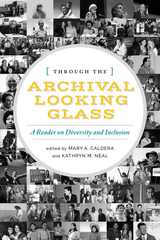 Through the Archival Looking Glass: A Reader on Diversity and Inclusion
Mary A. Caldera
Society of American Archivists, 2014 Realizing Diversity and Inclusion in Archives and the Archival Profession
The impulse to create archives is rooted in the very human need to leave one’s mark on the world. Whether through letters, diaries, reports, photographs, films, or a teenager’s simple need to scrawl “I was here” on a subway wall, there’s a deep desire in individuals to tell their stories, to be seen literally and figuratively in archives.
With this desire also comes the need to ensure that archives are as diverse as the world we live in and to preserve the individuals and cultures that have been consciously or unconsciously underserved in the archives. Through the Archival Looking Glass: A Reader on Diversity and Inclusion, edited by Mary A. Caldera and Kathryn M. Neal, features ten essays that explore prominent themes related to diversity, including:
• Creating a diverse record
• Recruiting diversity to the profession and retaining a diverse workforce
• Questioning the archive itself, on representation, authority, neutrality, objectivity, and power
Through the Archival Looking Glass illustrates a multitude of perspectives and issues so that fresh voices can emerge alongside more familiar ones, and new concepts can be examined with new treatments of established ideas. Diversity is an ever-evolving concept; the term itself is increasingly rephrased as inclusion. By stimulating further ideas and conversation, we can come closer to a common understanding of what diversity and inclusion are or can be and, perhaps most importantly, how they may be realized in archives and the archival profession.
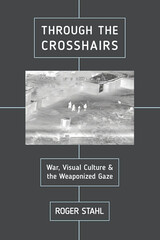 Through the Crosshairs: War, Visual Culture, and the Weaponized Gaze
Stahl, Roger
Rutgers University Press, 2018 Now that it has become so commonplace, we rarely blink an eye at camera footage framed by the crosshairs of a sniper’s gun or from the perspective of a descending smart bomb. But how did this weaponized gaze become the norm for depicting war, and how has it influenced public perceptions?
Through the Crosshairs traces the genealogy of this weapon’s-eye view across a wide range of genres, including news reports, military public relations images, action movies, video games, and social media posts. As he tracks how gun-camera footage has spilled from the battlefield onto the screens of everyday civilian life, Roger Stahl exposes how this raw video is carefully curated and edited to promote identification with military weaponry, rather than with the targeted victims. He reveals how the weaponized gaze is not only a powerful propagandistic frame, but also a prime site of struggle over the representation of state violence.
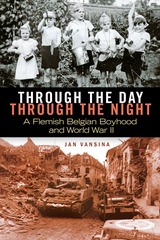 Through the Day, through the Night: A Flemish Belgian Boyhood and World War II
Jan Vansina
University of Wisconsin Press, 2014 One of twelve children in a close-knit, affluent Catholic Belgian family, Jan Vansina began life in a seemingly sheltered environment. But that cocoon was soon pierced by the escalating tensions and violence that gripped Europe in the 1930s and 1940s. In this book Vansina recalls his boyhood and youth in Antwerp, Bruges, and the Flemish countryside as the country was rocked by waves of economic depression, fascism, competing nationalisms, and the occupation of first Axis and then Allied forces.
Within the vast literature on World War II, a much smaller body of work treats the everyday experiences of civilians, particularly in smaller countries drawn into the conflict. Recalling the war in Belgium from a child’s-eye perspective, Vansina describes pangs of hunger so great as to make him crave the bitter taste of cod-liver oil. He vividly remembers the shock of seeing severely wounded men on the grounds of a field hospital, the dangers of crossing fields and swimming in ponds strafed by planes, and his family’s interactions with occupying and escaping soldiers from both sides. After the war he recalls emerging numb from the cinema where he first saw the footage of the Nazi death camps, and he describes a new phase of unrest marked by looting, vigilante justice, and the country’s efforts at reunification.
Vansina, a historian and anthropologist best known for his insights into oral tradition and social memory, draws on his own memories and those of his siblings to reconstruct daily life in Belgium during a tumultuous era.
Best Special Interest Books, selected by the American Association of School Librarians
Best Books for General Audiences, selected by the Public Library Reviewers
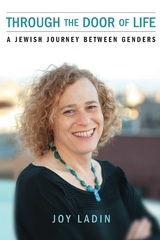 Through the Door of Life: A Jewish Journey between Genders
Joy Ladin
University of Wisconsin Press, 2012 Professor Jay Ladin made headlines around the world when, after years of teaching literature at Yeshiva University, he returned to the Orthodox Jewish campus as a woman—Joy Ladin. In Through the Door of Life, Joy Ladin takes readers inside her transition as she changed genders and, in the process, created a new self.
With unsparing honesty and surprising humor, Ladin wrestles with both the practical problems of gender transition and the larger moral, spiritual, and philosophical questions that arise. Ladin recounts her struggle to reconcile the pain of her experience living as the “wrong” gender with the pain of her children in losing the father they love. We eavesdrop on her lifelong conversations with the God whom she sees both as the source of her agony and as her hope for transcending it. We look over her shoulder as she learns to walk and talk as a woman after forty-plus years of walking and talking as a man. We stare with her into the mirror as she asks herself how the new self she is creating will ever become real.
Ladin’s poignant memoir takes us from the death of living as the man she knew she wasn’t, to the shattering of family and career that accompanied her transition, to the new self, relationships, and love she finds when she opens the door of life.
2012 Finalist for the National Jewish Book Award for Biography, Autobiography, or Memoir “Wrenching—and liberating. . . .[it] opens up new ways of looking at gender and the place of LGBT Jews in community.”—Greater Phoenix Jewish News
“Given her high-profile academic position, Ladin’s transition was a major news story in Israel and even internationally. But behind the public story was a private struggle and learning experience, and Ladin pulls no punches in telling that story. She offers a peek into how daunting it was to learn, with little support from others, how to dress as a middle-aged woman, to mu on make-up, to walk and talk like a female. She provides a front-row seat for observing how one person confronted a seemingly impossible situation and how she triumphed, however shakingly, over the many adversities, both societal and psychological, that stood in the way.”—The Gay and Lesbian Review Worldwide
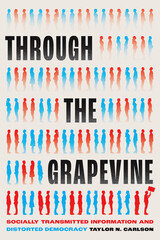 Through the Grapevine: Socially Transmitted Information and Distorted Democracy
Taylor N. Carlson
University of Chicago Press, 2024 An enlightening examination of what it means when Americans rely on family and friends to stay on top of politics. Accurate information is at the heart of democratic functioning. For decades, researchers interested in how information is disseminated have focused on mass media, but the reality is that many Americans today do not learn about politics from direct engagement with the news. Rather, about one-third of Americans learn chiefly from information shared by their peers in conversation or on social media. How does this socially transmitted information differ from that communicated by traditional media? What are the consequences for political attitudes and behavior? Drawing on evidence from experiments, surveys, and social media, Taylor N. Carlson finds that, as information flows first from the media then person to person, it becomes sparse, more biased, less accurate, and more mobilizing. The result is what Carlson calls distorted democracy. Although socially transmitted information does not necessarily render democracy dysfunctional, Through the Grapevine shows how it contributes to a public that is at once underinformed, polarized, and engaged.
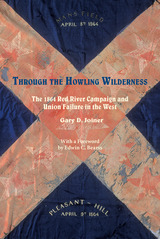 Through the Howling Wilderness: The 1864 Red River Campaign and Union Failure in the West
Gary D. Joiner
University of Tennessee Press, 2006
“This work will have strong appeal across the spectrum of students and be of equal benefit to the casual reader as well as the scholar. His maps are excellent and will aid readers in their study.” —Terrence J. Winschel, co-author of Vicksburg is the Key: The Struggle for the Mississippi River and author of Triumph and Defeat: The Vicksburg Campaign
The Red River Campaign of 1864 was a bold attempt to send large Union army and navy forces deep into the interior of Louisiana, seize the Rebel capital of the state, and defeat the Confederate army guarding the region enabling uninhibited access to Texas to the west. Through the Howling Wilderness emphasizes the Confederate defensive measures and the hostile attitudes of commanders toward each other as well as toward their enemies. Gary D. Joiner contends that the campaign was important to both the Union army and navy in the course of the war and afterward, altering the political landscape in the fall presidential elections in 1864. The campaign redirected troops originally assigned to operate in Georgia during the pivotal Atlanta campaign, thus delaying the end of the war by weeks or even months, and it forced the navy to refocus its inland or “brown water” naval tactics. The Red River Campaign ushered in deep resentment toward the repatriation of the State of Louisiana after the war ended. Profound consequences included legal, political, and sociological issues that surfaced in Congressional hearings as a result of the Union defeat. The efforts of the Confederates to defend northern Louisiana have been largely ignored. Their efforts at building an army and preparations to trap the union naval forces before the campaign began have been all but lost in the literature of the Civil War. Joiner’s book will remedy this lack of historical attention. Replete with in-depth coverage on the geography of the region, the Congressional hearings after the Campaign, and the Confederate defenses in the Red River Valley, Through the Howling Wilderness will appeal to Civil War historians and buffs alike.
Gary D. Joiner is assistant professor of history at Louisiana State University in Shreveport where he is director of the Red River Regional Studies Center. He is also owner of Precision Cartographics in Shreveport. Dr. Joiner is the co-editor of No Pardons to Ask, nor Apologies to Make and the author of One Damn Blunder from Beginning to End: The Red River Campaign of 1864, winner of the 2004 Albert Castel Award and the 2005 A.M. Pate, Jr., Award.
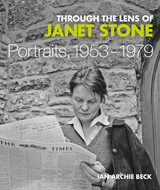 Through the Lens of Janet Stone: Portraits, 1953-1979
Ian Archie Beck
Bodleian Library Publishing, 2018 The wife of the distinguished engraver Reynolds Stone, Janet Stone established a kind of literary salon in the idyllic setting of the old Rectory at Litton Cheney in West Dorset, where their wide circle of friends could visit, work, and flourish. Janet’s photographs of these occasions feature informal portraits from the mid-twentieth century of many of the leading cultural figures and personalities of the day.
Included between these pages are portraits of the composers, actors, novelists, poets, and philosophers in the Stones’ milieu—from Benjamin Britten to Siegfried Sassoon and Frances Partridge—as well as members of the Stone family. Although not a trained photographer, Janet instinctively knew to click the shutter when her subjects were off-guard and at their most informal, capturing an array of candid shots—like one of John Bayley trying on a headscarf and a young Daniel Day-Lewis dressed up as a knight.
These unique portraits offer beguiling insight into a special set of circumstances: an idyllic place and time and a group of people drawn together by two contrasting but complimentary personalities, the shy genius of Reynolds met by the outgoing style and glamour of Janet Stone.
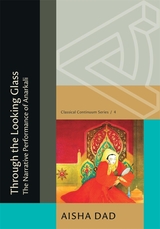 Through the Looking Glass: The Narrative Performance of Anarkali
Aisha Dad
Harvard University Press Anarkali, an Orientalized persona assigned to the harem of the Mughal Emperor Akbar, is also the lover of Akbar’s son, Salim, the future Mughal Emperor Jahangir. Her body and narrative occupy the liminal and contentious space between Akbar and Salim especially as construed under the male gaze of seventeenth-century European travelers. But while both Akbar and Salim are historically attested personalities, Anarkali is not. And yet, her narrative is pervasive in South Asia, appearing in everything from architecture to film. Up to this point studies of the enigma of Anarkali have centered on uncovering her historicity. But in the tragic performance of the poetics of the body, Anarkali embodies the ultimate conflation of the female body with narrative construction.
Informed by oral poetics, performance theory, and memory studies, Through the Looking Glass approaches Anarkali not as a historical enigma but rather as a qissa, an oral narrative. The so-called evidence of her historicity is the performance and reperformance of her qissa across different media: the Tomb of Anarkali in Lahore; early travel writings; Imtiaz Ali Taj’s seminal play Anarkali; and the Indian Cinema films Anarkali and Mughal-e-Azam. The poetics and performance of her body fundamentally signify the foreign and domestic anxieties at stake in the imperial personalities of Akbar and Salim.
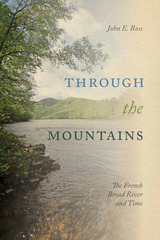 Through the Mountains: The French Broad River and Time
John E. Ross
University of Tennessee Press, 2021 WINNER, NORTH CAROLINA SOCIETY OF HISTORIANS AWARD OF EXCELLENCE
Two generations have passed since the publication of Wilma Dykeman’s landmark environmental history, The French Broad. In Through the Mountains: The French Broad River and Time, John Ross updates that seminal book with groundbreaking new research. More than the story of a single river, Through the Mountains covers the entire watershed from its headwaters in North Carolina’s Blue Ridge and the Great Smoky Mountains to its mouth in Knoxville, Tennessee.
The French Broad watershed has faced new perils and seen new discoveries since 1955, when The French Broad was published. Geologists have learned that the Great Smoky Mountains are not among the world’s oldest as previously thought; climatologists and archaeologists have traced the dramatic effects of global warming and cooling on the flora, fauna, and human habitation in the watershed; and historians have deepened our understanding of enslaved peoples once thought not to be a part of the watershed’s history. Even further, this book documents how the French Broad and its tributaries were abused by industrialists, and how citizens fought to mitigate the pollution.
Through the Mountains also takes readers to notable historic places: the hidden mound just inside the gate of Biltmore where Native Americans celebrated the solstices; the once-secret radio telescope site above Rosman where NASA eavesdropped on Russian satellites; and the tiny hamlet of Gatlinburg where Phi Beta Phi opened its school for mountain women in 1912.
Wilma Dykeman once asked what the river had meant to the people who lived along it. In the close of Through the Mountains, Ross reframes that question: For 14,000 years the French Broad and its tributaries have nurtured human habitation. What must we start doing now to ensure it will continue to nourish future generations? Answering this question requires a knowledge of the French Broad’s history, an understanding of its contemporary importance, and a concern for the watershed’s sustainable future. Through the Mountains fulfills these three criteria, and, in many ways, presents the larger story of America’s freshwater habitats through the incredible history of the French Broad.
Through the Open Door
Dabney Adams Hart
University of Alabama Press, 1984 "This book focuses on Lewis as a teacher, how he opens doors by challenging 20th-century views... Two ideas run through and unify the book. The first is that in all his writing Lewis encourage 'radical key' to all Lewis's critical and imaginative writings. Hart's aim is to show that there is in Lewis a single, integrated, systematic theory of literature focused on the importance of imagination and language. "The book raises many of the right questions about Lewis and explores them in a stimulating and informative way." -Christianity and Literature
Through the Past Darkly: History and Memory in François Mauriac’s Bloc-notes
Nathan Bracher
Catholic University of America Press, 2004 This book, the first English-language study of Mauriac's Bloc-notes, presents these poignant, incisive editorials on social justice, war, and human rights in postwar France as both symptomatic of a culture imbued with the past and emblematic of a Christian humanist's ethical approach to history and memory.
Through the Poet’s Eye: The Travels of Zagajewski, Herbert, and Brodsky
Bozena Shallcross
Northwestern University Press, 2009 Though best known as poets, Zbigniew Herbert (1924-1998), Joseph Brodsky (1940-1996), and Adam Zagajewski (b. 1945) wrote some of the most original prose of this century. These East European poets capture tales of their travels in prose writing that demonstrates the link between works of art, the epiphanic responses these works produce, and the reality of travel. Shallcross's exploration of their journeys creates a testimony connecting them each in his own way to the stream of European culture as a whole.
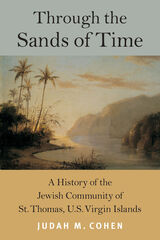 Through the Sands of Time: A History of the Jewish Community of St. Thomas, U.S. Virgin Islands
Judah M. Cohen
Brandeis University Press, 2012 In 1796, the Jews of St. Thomas founded the first Jewish congregation on this Caribbean island. By 1803, new arrivals from England, France, and the neighboring islands of St. Eustatius and Curaçao increased the original number from a handful of congregants to twenty-two families. Their small synagogue was destroyed by fires and rebuilt several times. The congregation numbered sixty-four families by the time the present synagogue was erected in 1833. It is by now the oldest synagogue in continuous use under the American flag. The congregation was also among the first to receive copies of the new West London Reform liturgy when it came out in 1841 and the first in this hemisphere to hold a Jewish confirmation ceremony, two years later. In addition, the St. Thomas Synagogue has produced its own unique religious literature relating to hurricanes! While the synagogue has served for over 200 years as a central religious and social gathering place, the Jews of St. Thomas have been highly mobile members of a progressive, cosmopolitan society that at times rivaled any in the world. As an accepted part of the larger community, members were accomplished, model citizens in a highly tolerant Danish colonial society. Jews took positions in government, served as auctioneers, participated in the local Masonic lodges, and represented other countries as consuls in St. Thomas. As traders in a mercantile culture, the Jews contributed to the activity of one of the world’s busiest harbors and played a crucial role in St. Thomas’s nineteenth-century rise to prominence in the northern Caribbean.
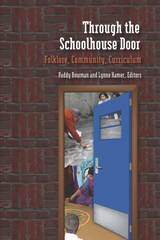 Through the Schoolhouse Door: Folklore, Community, Currriculum
Paddy Bowman and Lynne Hamer
Utah State University Press, 2011 The creative traditions and expressive culture of students' families, neighborhoods, towns, religious communities, and peer groups provide opportunities to extend classrooms, sustain learning beyond school buildings, and better connect students and schools with their communities. Folklorists and educators have long worked together to expand curricula through engagement with local knowledge and informal cultural arts-folk arts in education is a familiar rubric for these programs-but the unrealized potential here, for both the folklore scholar and the teacher, is large. The value folklorists "place on the local, the vernacular, and the aesthetics of daily life does not reverberate" throughout public education, even though, in the words of Paddy Bowman and Lynne Hamer, "connecting young people to family and community members and helping them to develop self-identity are vital to civic well-being and to school success." Through the Schoolhouse Door offers a collection of experiences from exemplary school programs and the analysis of an expert group of folklorists and educators who are dedicated not only to getting students out the door and into their communities to learn about the folk culture all around them but also to honoring the culture teachers and students bring to the classroom.
Through the Stonecutter's Window: Poems
Indigo Moor
Northwestern University Press, 2010 The inaugural winner of the Cave Canem Northwestern University Press Poetry Prize, Indigo Moor’s Through the Stonecutter’s Window is a sustained and impressive dialogue with the visual arts, history, the natural world, and the poet’s dreams and nightmares. The verse dances polyrhythmically across and down each page. Always in motion, Moor’s lines are choreographed to make sense of all that is most elusive in meaning: music, violence, love, anger, and desire.
 Through the Window: Kinship and Elopement in Bosnia-Herzegovina
Keith Doubt
Central European University Press, 2014 This book is not about war crimes, crimes against humanity, genocide, evil, or the killing of a society. It is about a cultural heritage, something vital to a society as a society, something that was not killed in the previous war, something that is resilient. Through the Window brings an original perspective to folklore of Bosnians at a certain period of time and the differences and similarities of the three main ethnic groups in Bosnia and Herzegovina. It examines the transethnic character of cultural heritage, against divisions that dominate their tragic recent past. The monograph focuses in particular on customs shared by different ethnic groups, specifically elopement, and affinal visitation. The elopement is a transformative rite of passage where an unmarried girl becomes a married woman. The affinal visitation, which follows, is a confirmatory ceremony where ritualized customs between families establish in-lawships These customs reflect a transethnic heritage shared by people in Bosnia as a national group, including Bosniaks, Serbs and Croats.
 Through the Window, Out the Door: Women's Narratives of Departure, from Austin and Cather to Tyler, Morrison, and Didion
Janis P. Stout
University of Alabama Press, 1998 This informative and provocative study focuses on the centrality of departure in the texts of five major American women novelists. An important moment in many novels and poems by American women writers occurs when a central character looks out a window or walks out the door of a house. These acts of departure serve to convey such values as the rejection of constraining social patterns, the search for individual fulfillment, and the entry into the political. Janis Stout examines such moments and related patterns of venture and travel in the fiction of five major American novelists of the 20th century: Mary Austin, Willa Cather, Anne Tyler, Toni Morrison, and Joan Didion. Stout views these five writers within a spectrum of narrative engagements with issues of home and departure—a spectrum anchored at one end by Sarah Orne Jewett and at the other by Marilynne Robinson, whose Housekeeping posits a vision of female transience. Through the Window, Out the Door ranges over an expansive territory. Moving between texts as well as between texts and contexts, Stout shows how women writers have envisioned the walls of physical and social structures (including genres) as permeable boundaries, drawing on both a rhetoric of liberation and a rhetoric of domesticity to construct narrative arguments for women's right to move freely between the two. Stout concludes with a personal essay on the dilemmas of domesticity and the ambivalence of departure.
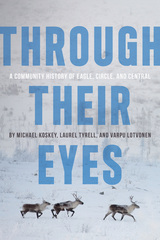 Through Their Eyes: A Community History of Eagle, Circle, and Central
Edited by Michael Koskey, Laurel Tyrrell, and Varpu Lotvonen
University of Alaska Press, 2018 The towns of Eagle, Circle, and Central are tucked away in the cold, rugged, and sparsely populated central-eastern interior of Alaska. These communities have fewer than three hundred residents in an area of more than 22,000 square miles. Yet they are closely linked by the Yukon River and by history itself.
Through their Eyes is a glimpse into the past and present of these communities, showing how their survival has depended on centuries of cooperation. The towns have roots in the gold rushes but they are also located within the traditional territories of the Hän Hwëch’in, the Gwichyaa Gwich’in, and Denduu Gwich’in Dena (Athabascan) peoples. Over time, residents have woven together new heritages, adopting and practicing each other’s traditions. This book combines oral accounts with archival research to create a rich portrayal of life in rural Alaska villages. Many of the stories come directly from the residents of these communities, giving an inside perspective on the often colorful events that characterize life in Eagle, Circle, and Central.
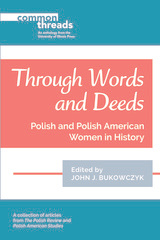 Through Words and Deeds: Polish and Polish American Women in History
Edited by John Bukowczyk
University of Illinois Press, 2021 Though often overlooked in conventional accounts, women with myriad backgrounds and countless talents have made an impact on Polish and Polish American history. John J. Bukowczyk gathers articles from the journals Polish Review and Polish American Studies to offer a fascinating cross-section of readings about the lives and experiences of these women. The first section examines queens and aristocrats during the Polish-Lithuanian Commonwealth, but also looks at the life of the first Polish female doctor. In the second section, women of the diaspora take center stage in articles illuminating stories that range from immigrant workers in Europe and the United States to women's part in Poland’s nationalist struggle. The final section concentrates on image, identity, and consciousness as contributors examine the stereotyping and othering of Polish women and their portrayal in ethnic and émigré fiction. A valuable and enlightening resource, Through Words and Deeds offers an introduction to the many facets of Polish and Polish American womanhood. Contributors: Laura Anker, Robert Blobaum, Anna Brzezińska, John J. Bukowczyk, Halina Filipowicz, William J. Galush, Rita Gladsky, Thaddeus V. Gromada, Bożena Karwowska, Grażyna Kozaczka, Lynn Lubamersky, Karen Majewski, Nameeta Mathur, Lori A. Matten, Jan Molenda, James S. Pula, Władysław Roczniak, and Robert Szymczak
Throughout Your Generations Forever: Sacrifice, Religion, and Paternity
Nancy Jay
University of Chicago Press, 1992 Why does sacrifice, more than any other major religious institution, depend on gender dichotomy? Why do so many societies oppose sacrifice to childbirth, and why are childbearing women so commonly excluded from sacrificial practices? In this feminist study of relations between sacrifice, gender, and social organization, Nancy Jay reveals sacrifice as a remedy for having been born of woman, and hence uniquely suited to establishing certain and enduring paternity. Drawing on examples of ancient and modern societies, Jay synthesizes sociology of religion, ethnography, biblical scholarship, church history, and classics to argue that sacrifice legitimates and maintains patriarchal structures that transcend men's dependence on women's reproductive powers.
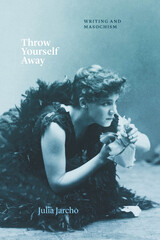 Throw Yourself Away: Writing and Masochism
Julia Jarcho
University of Chicago Press, 2024 Proposes that we can best understand literature’s relationship to sex through a renewed focus on masochism.
In a series of readings that engage American and European works of fiction, drama, and theory from the late nineteenth through the early twenty-first centuries, critic and playwright Julia Jarcho argues that these works conceive writing itself as masochistic, and masochism as sexuality enacted in writing. Throw Yourself Away is distinctive in its sustained focus on masochism as an engine of literary production across multiple authors and genres. In particular, Jarcho shows that theater has played a central role in modern erotic fantasies of the literary.
Jarcho foregrounds writing as a project of distressed subjects: When masochistic writing is examined as a strategy of response to injurious social systems, it yields a surprisingly feminized—and less uniformly white—image of both masochism and authorship. Ultimately, Jarcho argues that a retheorized concept of masochism helps us understand literature itself as a sex act and shows us how writing can tend to our burdened, desirous bodies. With startling insights into such writers as Henry James, Henrik Ibsen, Mary Gaitskill, and Adrienne Kennedy, Throw Yourself Away furnishes a new masochistic theory of literature itself.
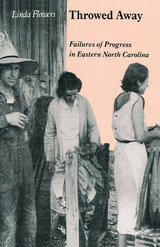 Throwed Away: Failures of Progress in Eastern North Carolina
Linda Flowers
University of Tennessee Press, 1992 Guided by memory and experience, reading and conversations, Linda Flowers offers a perceptive and often painful rendering of the changes industrialization has brought to her native region of eastern North Carolina since 1960. Entwined with her own narrative of coming of age in the rural South is the story of the undoing of the local way of life, brought about by the demise of tenant farming. Flowers charts the progress of the first generation to make the transition from farm to factory and records their hopes and dreams of achieving a better life.
The sixties brought industrialization and sweeping changes in public schooling characterized by integration and large, consolidated school systems. Ten years later, it was apparent that neither the schools nor the factories had yet fulfilled the promise inherent in them. The children of that first generation to leave the farm struggled to find and keep even low-paying, dead-end jobs, their plight worsening with the rise of the service-oriented economy of the 1980s. As the author's interviews with students, teachers, and administrators reveal, educational innovations have not meant improvements for all, and white flight from public schools to private academies has sometimes sabotaged the goals of integration.
Flowers finds a generation of displaced families on whom long hours of shift work, low wages, and abandoned hopes have taken their toll. The factories have come and somtimes gone in eastern North Carolina, leaving behind a place and its people "throwed away."
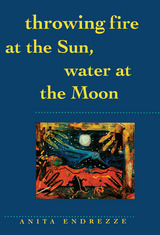 Throwing Fire at the Sun, Water at the Moon
Anita Endrezze
University of Arizona Press, 2000 Perhaps you know them for their deer dances or for their rich Easter ceremonies, or perhaps only from the writings of anthropologists or of Carlos Castaneda. But now you can come to know the Yaqui Indians in a whole new way. Anita Endrezze, born in California of a Yaqui father and a European mother, has written a multilayered work that interweaves personal, mythical, and historical views of the Yaqui people.
Throwing Fire at the Sun, Water at the Moon is a blend of ancient myths, poetry, journal extracts, short stories, and essays that tell her people's story from the early 1500s to the present, and her family's story over the past five generations. Reproductions of Endrezze's paintings add an additional dimension to her story and illuminate it with striking visual imagery. Endrezze has combed history and legend to gather stories of her immediate family and her mythical ancient family, the two converging in the spirit of storytelling. She tells Aztec and Yaqui creation stories, tales of witches and seductresses, with recurring motifs from both Yaqui and Chicano culture. She shows how Christianity has deeply infused Yaqui beliefs, sharing poems about the Flood and stories of a Yaqui Jesus. She re-creates the coming of the Spaniards through the works of such historical personages as Andrés Pérez de Ribas. And finally she tells of those individuals who carry the Yaqui spirit into the present day. People like the Esperanza sisters, her grandmothers, and others balance characters like Coyote Woman and the Virgin of Guadalupe to show that Yaqui women are especially important as carriers of their culture.
Greater than the sum of its parts, Endrezze's work is a new kind of family history that features a startling use of language to invoke a people and their past--a time capsule with a female soul. Written to enable her to understand more about her ancestors and to pass this understanding on to her own children, Throwing Fire at the Sun, Water at the Moon helps us gain insight not only into Yaqui culture but into ourselves as well.
Thucydides
John H. Finley Jr.
Harvard University Press
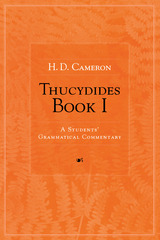 Thucydides Book I: A Students' Grammatical Commentary
H. D. Cameron
University of Michigan Press, 2003 The first book of Thucydides is a compact masterpiece. Here he sets up the conditions that led to the outbreak of the Peloponnesian War in 431 B.C. With great economy, he analyzes the origins of large-scale wars; integrates a sketch of the historical background into the larger thematic threads of his narrative; presents a brief statement of his methods and goals; outlines a hierarchy of causation; develops a theory of character and human nature; and presents a theory of leadership, chance, and foresight, all within a narrative structure that perfectly focuses these elements.
Because Book I is not primarily historical narrative, it inevitably proves difficult for inexperienced readers. Despite the convolutions and density of Thucydides' prose style, no authoritative commentary has been published since the early days of the last century. H. D. Cameron is a renowned expert in Greek and comparative grammar and has written this handbook for all levels of classical students and scholars. His commentary authoritatively accounts for the last one hundred years of evolving grammatical and linguistic theory as they apply to the seminal work of Thucydides.
H. D. Cameron is Professor of Greek and Latin and Director of the Great Books Program at the University of Michigan.
Thucydides on the Nature of Power
A. Geoffrey Woodhead
Harvard University Press, 1970 The implications of Thucydides' hostility to full democracy have long been avoided by scholars. In this provocative study the author confronts and examines this aspect of Thucydides' thought in detail. A. Geoffrey Woodhead also discusses his controversial interpretation of Thucydides' view of the nature of power: that equally among states and individuals, the impulse toward power follows its own laws, which are not immoral but amoral, and which should be viewed for themselves without ethical or emotional confusion.
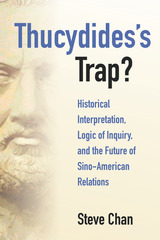 Thucydides’s Trap?: Historical Interpretation, Logic of Inquiry, and the Future of Sino-American Relations
Steve Chan
University of Michigan Press, 2020 The Peloponnesian War (431–404 BCE) ostensibly arose because of the fear that a rising Athens would threaten Sparta’s power in the Mediterranean. The idea of Thucydides’ Trap warns that all rising powers threaten established powers. As China increases its power relative to the United States, the theory argues, the two nations are inevitably set on a collision course toward war. How enlightening is an analogy based on the ancient Greek world of 2,500 years ago for understanding contemporary international relations? How accurate is the depiction of the history of other large armed conflicts, such as the two world wars, as a challenge mounted by a rising power to displace an incumbent hegemon?Thucydides’s Trap?: Historical Interpretation, Logic of Inquiry, and the Future of Sino-American Relations offers a critique of the claims of Thucydides’s Trap and power-transition theory. It examines past instances of peaceful accommodation to uncover lessons that can ease the frictions in ongoing Sino-American relations.
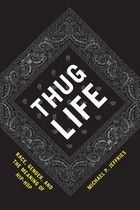 Thug Life: Race, Gender, and the Meaning of Hip-Hop
Michael P. Jeffries
University of Chicago Press, 2010 Hip-hop has come a long way from its origins in the Bronx in the 1970s, when rapping and DJing were just part of a lively, decidedly local scene that also venerated b-boying and graffiti. Now hip-hop is a global phenomenon and, in the United States, a massively successful corporate enterprise predominantly controlled and consumed by whites while the most prominent performers are black. How does this shift in racial dynamics affect our understanding of contemporary hip-hop, especially when the music perpetuates stereotypes of black men? Do black listeners interpret hip-hop differently from white fans?
These questions have dogged hip-hop for decades, but unlike most pundits, Michael P. Jeffries finds answers by interviewing everyday people. Instead of turning to performers or media critics, Thug Life focuses on the music’s fans—young men, both black and white—and the resulting account avoids romanticism, offering an unbiased examination of how hip-hop works in people’s daily lives. As Jeffries weaves the fans’ voices together with his own sophisticated analysis, we are able to understand hip-hop as a tool listeners use to make sense of themselves and society as well as a rich, self-contained world containing politics and pleasure, virtue and vice.
Thump! Ouch!: Marcus Gets Hurt
The University of Michigan Medicine C. S. Mott Children's Hospital Pediatric Trauma Program; Illustrated by Billy Phillips
Michigan Publishing, 2021 Marcus loves playing with his friends Olivia and Nora. One day while they are swinging at the playground, he falls and gets hurt. He has to go to the hospital! At the hospital, Marcus meets a dog named Denver. Denver teaches Marcus about pain, how to help the pain, and how to take medicine safely so he feels better and can play with his friends again.
 Thunder Below!: The USS *Barb* Revolutionizes Submarine Warfare in World War II
Admiral Eugene B. Fluckey
University of Illinois Press, 1992 The thunderous roar of exploding depth charges was a familiar and comforting sound to the crew members of the USS Barb, who frequently found themselves somewhere between enemy fire and Davy Jones's locker.
Under the leadership of her fearless skipper, Captain Gene Fluckey, the Barb sank the greatest tonnage of any American sub in World War II. At the same time, the Barb did far more than merely sink ships-she changed forever the way submarines stalk and kill their prey.
This is a gripping adventure chock-full of "you-are-there" moments. Fluckey has drawn on logs, reports, letters, interviews, and a recently discovered illegal diary kept by one of his torpedomen. And in a fascinating twist, he uses archival documents from the Japanese Navy to give its version of events.
The unique story of the Barb begins with its men, who had the confidence to become unbeatable. Each team helped develop innovative ideas, new tactics, and new strategies. All strove for personal excellence, and success became contagious. Instead of lying in wait under the waves, the USS Barb pursued enemy ships on the surface, attacking in the swift and precise style of torpedo boats. She was the first sub to use rocket missiles and to creep up on enemy convoys at night, joining the flank escort line from astern, darting in and out as she sank ships up the column.
Surface-cruising, diving only to escape, "Luckey Fluckey" relentlessly patrolled the Pacific, driving his boat and crew to their limits. There can be no greater contrast to modern warfare's long-distance, videogame style of battle than the exploits of the captain and crew of the USS Barb, where they sub, out of ammunition, actually rammed an enemy ship until it sank.
Thunder Below! is a first-rate, true-life, inspirational story of the courage and heroism of ordinary men under fire.
A Main Selection of the Military Book Club. Winner of the Rear Admiral Samuel Eliot Morison Award for Naval Literature given by the Naval Order of the United States, New York Commandery.
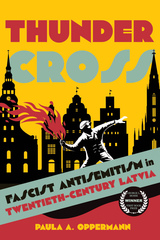 Thunder Cross: Fascist Antisemitism in Twentieth-Century Latvia
Paula A. Oppermann
University of Wisconsin Press, 2025 Founded in 1932, Thunder Cross (Pērkonkrusts) was the largest and most prominent right-wing political party in Latvia in the early twentieth century. Its motto—“Latvia for Latvians!”—echoed the ultranationalist rhetoric of similar movements throughout Europe at the time. Unlike the Nazis in Germany or the Fascists in Italy, however, Thunder Cross never succeeded in seizing power. Nevertheless, Holocaust historian Paula A. Oppermann argues, its movement left an indelible mark on the country. The antisemitism at the core of Thunder Cross’s ideology remained a driving force for Latvian fascists throughout the twentieth century, persisting despite shifting historical and political contexts.
Thunder Cross is the most comprehensive study of Latvia’s fascist movement in English to date, and the only work that investigates the often neglected continuities of fascist antisemitism after World War II. Formulated as an empirical case study, this book draws on international and interdisciplinary secondary literature and sources in seven languages to broaden our understanding of fascism, antisemitism, and mass violence from Germany and Italy to the larger European context.
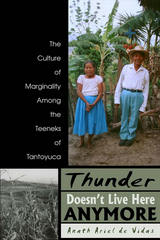 Thunder Doesn't Live Here Anymore: The Culture of Marginality Among the Teeneks of Tantoyuca
Anath Ariel de Vidas
University Press of Colorado, 2004 Now available in English, Thunder Doesn't Live Here Anymore explores the highly unusual worldview of the Teenek people of Tantoyuca, Veracruz, whose self-deprecating cosmology diverges quite radically from patterns of positive cultural identity among other indigenous groups in Mexico. The Teeneks speak of themselves as dirty, dumb, ignorant, and fearful, a vocabulary that serves to justify the Teeneks' condition of social and spatial marginality in relation to their mestizo neighbors.
However, as Anath Ariel de Vidas argues in this masterful ethnography, this self-denigration - added to the absence among the Teeneks of emblematic Indian features such as traditional costumes, agricultural rituals, specific ceremonies, or systems of religious cargos or offices - are not synonymous with collective anomie. Rather, as Ariel de Vidas demonstrates, their seeming ontological acceptance of a marginal social and economic condition is - in its own peculiar way - a language of indigenous resistance.
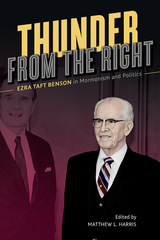 Thunder from the Right: Ezra Taft Benson in Mormonism and Politics
Edited by Matthew L. Harris
University of Illinois Press, 2019 Ezra Taft Benson's ultra-conservative vision made him one of the most polarizing leaders in the history of the Church of Jesus Christ of Latter-day Saints. His willingness to mix religion with extreme right-wing politics troubled many. Yet his fierce defense of the traditional family, unabashed love of country, and deep knowledge of the faith endeared him to millions. In Thunder from the Right, a group of veteran Mormon scholars probe aspects of Benson's extraordinary life. Topics include: how Benson's views influenced his actions as Secretary of Agriculture in the Eisenhower Administration; his dedication to the conservative movement, from alliances with Barry Goldwater and the John Birch Society to his condemnation of the civil rights movement as a communist front; how his concept of the principal of free agency became central to Mormon theology; his advocacy of traditional gender roles as a counterbalance to liberalism; and the events and implications of Benson's term as Church president. Contributors: Gary James Bergera, Matthew Bowman, Newell G. Bringhurst, Brian Q. Cannon, Robert A. Goldberg, Matthew L. Harris, J. B. Haws, and Andrea G. Radke-Moss
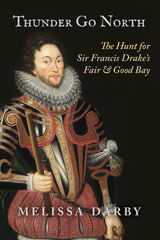 Thunder Go North: The Hunt for Sir Francis Drake's Fair and Good Bay
Melissa Darby
University of Utah Press, 2019 In the summer of 1579 Francis Drake and all those aboard the Golden Hind were in peril. The ship was leaking and they were in search of a protected beach to careen the ship to make repairs. They searched the coast and made landfall in what they called a ‘Fair and Good Bay’, generally thought to be in California. They stacked the treasure they had recently captured from the Spanish onto on this sandy shore, repaired the ship, explored the country, and after a number of weeks they set sail for home. When they returned to England, they became the second expedition to circumnavigate the earth, after Magellan’s voyage in 1522, and the first to return with its commander.
Thunder Go North unravels the mysteries surrounding Drake’s famous voyage and summer sojourn in this bay. Comparing Drake’s observations of the Natives’ houses, dress, foods, language, and lifeways with ethnographic material collected by early anthropologists, Melissa Darby makes a compelling case that Drake and his crew landed not in California but on the Oregon coast. She also uncovers the details of how an early twentieth-century hoax succeeded in maintaining the California landing theory and silencing contrary evidence. Presented here in an engaging narrative, Darby’s research beckons for history to be rewritten.
Thunder In the Mountains: The West Virginia Mine War, 1920–21
Lon Savage
University of Pittsburgh Press, 1990
The West Virginia mine war of 1920–21, a major civil insurrection of unusual brutality on both sides, even by the standards of the coal fields, involved thousands of union and nonunion miners, state and private police, militia, and federal troops. Before it was over, three West Virginia counties were in open rebellion, much of the state was under military rule, and bombers of the US Army Air Corps had been dispatched against striking miners.
The civil war began in the small railroad town of Matewan when Mayor C. C. Testerman and Police Chief Sid Hatfield sided with striking miners against agents of the Baldwin-Felts Detective Agency, who attempted to evict the miners from company-owned housing. Thunder in the Mountains was the first book-length account of this crisis in American industrial relations and governance, much neglected in historical accounts.
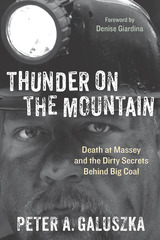 Thunder on the Mountain: Death at Massey and the Dirty Secrets behind Big Coal
Peter A. Galuszka
West Virginia University Press, 2014 With a foreword by Denise Giardina On April 5, 2010, an explosion ripped through Massey Energy’s Upper Big Branch Mine, killing twenty-nine coal miners. This tragedy was the deadliest mine disaster in the United States in forty years—a disaster that never should have happened. These deaths were rooted in the cynical corporate culture of Massey and its notorious former CEO Don Blankenship, and were part of an endless cycle of poverty, exploitation, and environmental abuse that has dominated the Appalachian coalfields since coal was first discovered there. And the cycle continues unabated as coal companies bury the most insidious dangers deep underground, all in search of higher profits, and hide the true costs from regulators, unions, and investors alike. But the disaster at Upper Big Branch goes beyond the coalfields of West Virginia. It casts a global shadow, calling into bitter question why coal miners in the United States are sacrificed to erect cities on the other side of the world, why the coal wars have been allowed to rage, polarizing the country, and how the world’s voracious appetite for energy is satisfied at such horrendous cost. With Thunder on the Mountain, Peter A. Galuszka pieces together the true story of greed and negligence behind the tragedy at the Upper Big Branch Mine, and in doing so he has created a devastating portrait of an entire industry that exposes the coal-black motivations that led to the death of twenty-nine miners and fuel the ongoing war for the world’s energy future. This paperback edition contains a foreword by Denise Giardinia that provides an update on Massey Energy and Donald Blankenship, Chairman and CEO of Massey Energy Company during the UBB disaster, and recounts her own experiences with Massey Energy and the United Mine Workers Association in the 1980s. This edition also includes a notes section and a bibliography.
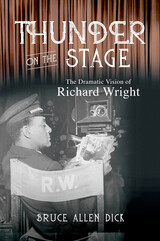 Thunder on the Stage: The Dramatic Vision of Richard Wright
Bruce Allen Dick
University of Illinois Press, 2024 Richard Wright’s dramatic imagination guided the creation of his masterpieces Native Son and Black Boy and helped shape Wright’s long-overlooked writing for theater and other performative mediums. Drawing on decades of research and interviews with Wright’s family and Wright scholars, Bruce Allen Dick uncovers the theatrical influence on Wright’s oeuvre--from his 1930s boxing journalism to his unpublished one-acts on returning Black GIs in WWII to his unproduced pageant honoring Vladimir Lenin. Wright maintained rewarding associations with playwrights, writers, and actors such as Langston Hughes, Theodore Ward, Paul Robeson, and Lillian Hellman, and took particular inspiration from French literary figures like Jean-Paul Sartre. Dick’s analysis also illuminates Wright’s direct involvement with theater and film, including the performative aspects of his travel writings; the Orson Welles-directed Native Son on Broadway; his acting debut in Native Son’s first film version; and his play “Daddy Goodness,” a satire of religious charlatans like Father Divine, in the 1930s. Bold and original, Thunder on the Stage offers a groundbreaking reinterpretation of a major American writer.
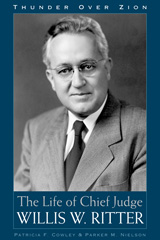 Thunder Over Zion: The Life and Times of Chief Judge Willis W Ritter
Cowley & Nielson
University of Utah Press, 2006 Willis William Ritter, United States District Judge for the District of Utah from 1949 until his death on March 4, 1978, was the one judge whose name was familiar among those who had little or no idea of the difference between judicial jurisdictions. Many knew him by the broad gestures with which he challenged bureaucracies and the federal government itself. He was, legally speaking, a friend to the underdog. Yet at his death scarcely a friend was left and he had become the object of ridicule, outrage, pity, and contempt.
Ritter was clearly ahead of his time, for his opinions on criminal justice, police interrogation, and the rights to counsel have now become accepted standards in jurisprudence. They are, indeed, so universally accepted that few if any viewers of televised police court dramas would even question them. In his personal life he was a man flawed on a grand scale and he lived a life fraught with contradictions. This is his compelling story, compellingly recounted.
 Thunder Shaman: Making History with Mapuche Spirits in Chile and Patagonia
By Ana Mariella Bacigalupo
University of Texas Press, 2016 As a “wild,” drumming thunder shaman, a warrior mounted on her spirit horse, Francisca Kolipi’s spirit traveled to other historical times and places, gaining the power and knowledge to conduct spiritual warfare against her community’s enemies, including forestry companies and settlers. As a “civilized” shaman, Francisca narrated the Mapuche people’s attachment to their local sacred landscapes, which are themselves imbued with shamanic power, and constructed nonlinear histories of intra- and interethnic relations that created a moral order in which Mapuche become history’s spiritual victors. Thunder Shaman represents an extraordinary collaboration between Francisca Kolipi and anthropologist Ana Mariella Bacigalupo, who became Kolipi’s “granddaughter,” trusted helper, and agent in a mission of historical (re)construction and myth-making. The book describes Francisca’s life, death, and expected rebirth, and shows how she remade history through multitemporal dreams, visions, and spirit possession, drawing on ancestral beings and forest spirits as historical agents to obliterate state ideologies and the colonialist usurpation of indigenous lands. Both an academic text and a powerful ritual object intended to be an agent in shamanic history, Thunder Shaman functions simultaneously as a shamanic “bible,” embodying Francisca’s power, will, and spirit long after her death in 1996, and an insightful study of shamanic historical consciousness, in which biography, spirituality, politics, ecology, and the past, present, and future are inextricably linked. It demonstrates how shamans are constituted by historical-political and ecological events, while they also actively create history itself through shamanic imaginaries and narrative forms.
Thunderbird: Book One
Sonia Nimr, translated by M. Lynx Qualey
University of Texas Press, 2022 Shortlisted for the 2023 Saif Ghobash Banipal Prize for Arabic Literary Translation, Society of Authors
A Palestinian girl travels to the past in a magical quest to save the world.
The Thunderbird trilogy is a fast-paced time-traveling fantasy adventure centered on Noor, a young orphaned Palestinian girl who starts in the present and must go back in time to get four magical bird feathers and save the world. Aided by a djinn cat and girls who look identical to Noor and who each have one of the bird’s powers, in this initial volume Noor begins her journey through different historical periods, striving to keep the wall between worlds intact.
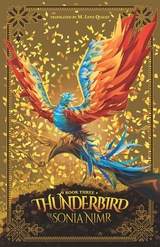 Thunderbird: Book Three
Sonia Nimr, translated by M. Lynx Qualey
University of Texas Press, 2024 The third book in a fast-paced time-traveling fantasy adventure trilogy centered on a young orphaned Palestinian girl who starts in the present and must go back in time to save the world. In the third and final book of the Thunderbird trilogy, Noor finds herself in Byzantine Jerusalem, in the year 638 CE, where the city is under siege. She is joined by Sabeeka, the djinn who takes the form of a cat, and meets the twins Helena and Julian, who have the power of healing. The four team up to find the thunderbird. But before they can, they are swallowed by a giant wormlike creature called a bakasola, which takes them to the world beyond the wall that separates the world of the djinn from our ordinary human world. From the terrifying, dark, gloomy world of the bakasola, Noor and her friends are rescued and delivered to the colorful and peaceful world of the sakarik, where they discover the bakasola are stealing the golden liquid that keeps the sakarik alive. Will Noor and her friends rescue the sakarik and return to the human world in time to find the last two thunderbird feathers that will save the world?
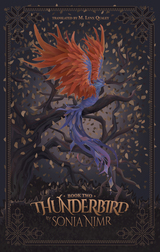 Thunderbird: Book Two
Sonia Nimr, translated by M. Lynx Qualey
University of Texas Press, 2022 Shortlisted for the 2023 Saif Ghobash Banipal Prize for Arabic Literary Translation, Society of Authors
A Palestinian girl travels to the past in a magical quest to save the world.
The Thunderbird trilogy is a fast-paced time-traveling fantasy adventure centered on Noor, a young orphaned Palestinian girl who starts in the present and must go back in time to get four magical bird feathers and save the world. In this second installment, Noor finds herself in the year 1177 in Jerusalem, during the Crusades. With the help of Sabeeka, Zainab, a girl who has the power to become invisible, and her local resistance group, Noor must once again find a feather belonging to the thunderbird before it burns, in order to prevent the world of the djinn from collapsing into the human world. Along the way, Noor helps the resistance group save hundreds of books and manuscripts from being burned. Like the first book in the Thunderbird trilogy, Book Two combines the magical with real events from Palestinian history to take the reader on a wild and adventurous ride through time.
|
|
